11 Proven Tips for Taking a Cat on a Road Trip
Published by sarah vaughan on june 7, 2021 june 7, 2021.
In March of 2021, we set off on a cross-country road trip from Virginia to California, taking our beloved cat, Fitzgerald, along with us! During that time, we’ve driven over 7,000 miles and spent more than 120 hours in the car with our furry friend. While taking a cat on a long distance road trip has its challenges, it’s absolutely doable! In this article, we’ve compiled everything we’ve learned from many hours spent in the car with Fitzgerald. We hope these tips will give you the confidence you need to hit the road with your feline companion!
Two Outliers may contain affiliate links and is a member of the Amazon Services LLC Associates Program. As an Amazon Associate I earn from qualifying purchases at no extra cost to you. For more information, see our privacy policy.

Our Story: Taking a Cross Country Road Trip with our Cat!
If you know me (Sarah), you likely know that I am a total sucker for animals – cats, dogs, horses – I love them all. When I’m not traveling, I spend my spare time fostering kittens for the SPCA. In fact, many of the pictures you’ll see in the post are of my foster kittens. And if you know the two of us, you know that our cat, Fitzgerald (aka Fitz, Fitzy, Ger, Ger Bear…), is our pride and joy.
And so, when the global pandemic hit and we found ourselves working remotely and contemplating a long-term cross-country road trip, there was never a question that we were taking Fitzgerald with us.

From Virginia to California
In March of 2021, we got rid of most our belongings, packed up what was left, subleased our apartment in Virginia and hit the road: California bound! We drove from Virginia to St. Louis in one day, then to Denver the next.
After spending one week in Denver to break up the road trip, we continued to Southern California. Over the span of that first week, we drove 2,653 miles and spent over 40 hours on the road, all with our cat!
P.S: You can read more about us here and keep up with our road trip adventures here .

A long-term road trip
Since driving across the country the first time, we’ve decided to make life on the road our permanent lifestyle and haven’t settled down yet.
Needless to say, Fitzgerald has gotten pretty used to long car rides and changing homes, and we have learned a ton about how to make him most comfortable and stress-free in the car. All in all, he’s traveled more than 4,400 miles and spent around 68 hours in the car with us!
In this article, we’ve outlined 11 tips that we use to ensure taking our cat on long distance road trips are stress-free every time ! We hope you’ll find our tips helpful for road tripping with your cat too!
Tip | About to head off on a long road trip? Check out this list of our favorite songs about travel and adventure and refresh your playlist before you hit the road!
You may also like

72 Best Songs about Travel and Adventure
11 tips for a taking a cat on a road trip.
Without further ado, here are the 11 tips we’ve learned from long distance travel with a cat in the car long-distance road tripping with Fitzgerald.
We hope these insights will help keep you and your feline companion stress free on the road!
- Try to stop as little as possible
- Get your cat a collar with tag for traveling
- Bring a familiar comfort item from home
- If possible, make one long trip rather than several shorter trips
- Create a “safe space” in the car for your cat to retreat to
- If your cat is especially nervous, try feline anxiety medication
- Try letting your cat roam free, but always pack a cat carrier just in case
- If you must crate your cat, leave the carrier out several days before your trip
- Pack your cat’s litter box, filled with clean litter
- Take away your cats food the night before the trip
- Set up a small, quiet place for your cat to rest at your final destination
Please note that these tips are based on our own personal experience road tripping with cats. All cats have different personalities and may react differently in the car! We are not veterinarians – please consult with your cat’s vet about the best way to travel with your cat in the car.

1. Try to stop as little as possible
When you first get in the car, your cat will be nervous (no matter how relaxed he/she normally is). However, most cats will settle in after a few minutes of adjusting to their surroundings and the motion of the car.
Each time you stop, there are new sights, sounds, and smells for your cat to take in, and he/she may become unsettled all over again. To minimize your cat’s stress, try to make as few stops as possible.
Pack snacks and lunches, fill up on gas the night before and only stop when absolutely necessary. In general, cats don’t like change, so trying to create a consistent environment is key.
2. Get your cat a collar with tag for traveling
My biggest fear when hitting the road with Fitzgerald is that somehow he’ll escape at a gas station or rest area and be lost forever! A bit dramatic, I know, but cats are so sneaky and it’s easy to imagine him getting startled and darting out the door.
I got Fitzgerald a collar and tag with his name and both our phone numbers engraved on the tag, and it gives me serious peace of mind to know that if he somehow gets lost, we at least have a solid chance of getting him back.
- For an extra layer of protection, attach a tracking device ( Apple Airtag or Tile ) to your cat’s collar.
Tip: You can get an inexpensive collar and engraved name tag super easily at most pet supply stores.

3. Bring a familiar comfort item from home
Fitzgerald has absolutely loved this old, raggedy orange blanket since he was just a little kitten. At home, he’ll knead, or “make biscuits,” on it all the time before he naps. It’s definitely his favorite comfort item (or security blanket, if you will)!
Whenever we road trip, we bring this blanket and make sure he has a comfy spot to curl up with it. If your cat has a favorite toy, blanket, bed, etc., it’s a great idea to bring with you! A little hint of familiarity from home can bring some comfort to your cat in a new environment.
Side note : When cats “make biscuits” like Fitzgerald does, they are replicating the act of nursing, and it’s typically because they lost their mother too early as a kitten.

4. If possible, make one long trip rather than several shorter trips
Let’s say you’ve got a 12 hour drive coming up. You may think it’d be best for your cat if you split this long drive up into two shorter 6 hours drives, stopping for the night along the way. In our experience, however, it’s actually better to just go for the full 12 hours at once.
Cats hate change , and one long drive means less change than 2 shorter drives. Typically, the most stressful parts of the road trip are getting into the car and settling into a new place at your destination.
Taking several shorter trips means more adjusting to the car and more adjusting to temporary new homes when you stop.

5. Create a “safe space” in the car for your cat to retreat to
This is especially important if your cat is a “hider.” Set aside a comfortable space in the car for your cat to retreat to when he or she gets scared.
We typically pack Fitzgerald’s cat carrier and leave it open with some toys and blankets during the car ride in case he wants to curl up in his own little “safe space”. He ends up spending most of his time in the car lounging inside the carrier.

6. If your cat is especially nervous, try feline anxiety medication
You should only try medication as a last resort . Many cats will be perfectly fine in the car without medication, as long as you take appropriate steps to keep them comfortable.
But if your cat is particularly anxious, it may be a good idea to talk to your veterinarian about anxiety medication to keep them calm in the car.

7. Try letting your cat roam free, but always pack a carrier just in case
We’re very lucky that Fitzgerald has a laid-back demeanor, and we’re able to let him roam free in the car. He typically spends his time in the car either sleeping on our laps, perched up on our piles of stuff looking out the window, or curled up in his carrier.
If your cat is laid back in the car, you may want to try to let them roam free, at least to start out. Having some space to move around will make your cat happier, and hopefully, mean less whining.
It’s a good idea to test this out with a short trip , and whether it’s a good idea for you depends on your cat’s personality. If you are traveling alone, it’s best to keep your cat in the crate since you will have no one to help you in the event that the cat starts to become a distraction.
That being said, safety should always come first. If your cat starts to try to get under your feet or becomes a serious distraction to your driving, it’s better to be safe and crate them. Always pack a cat carrier or small crate just in case, even if you don’t think you’ll need it.

8. If you must crate your cat, leave the carrier out several days before your trip
If you plan on crating your cat, it can be helpful to leave your car carrier out in your home a few days prior to your trip. Put some of your cats favorite toys, blankets, or bed in there and let them get used to being in the crate before the trip.
Doing so will give your cat some time to adjust to life in the crate and reduces the chance they will freak when it comes time for your road trip.
9. Pack your cat’s litter box, filled with clean litter
Cat’s have an amazing ability to hold in their urge to go to the bathroom. That being said, sometimes the urge can be overwhelming and your cat will need to use the litter box on the road, particularly if you are road tripping long distance . Make sure their litter box is accessible in the car so they can relieve themselves if nature calls.
Most importantly, make sure the litter box is clean before you leave! You do not want to be stuck in the car with a dirty litter box for hours.
The smell of clean litter can be overwhelming on its own! We recommend getting a covered litter house with a door , if you don’t have one already, to help contain the smell and reduce the likelihood of any litter spills.
10. Take away your cat’s food the night before the trip
Your cat might be mad at you for taking away their food, but trust us, it is not as bad as a puking cat at the start of a road trip.
Our cat, Fitzgerald, usually does great on road trips but both times we’ve forgotten to take away his food, he has thrown up within an hour of being in the car. The first time we were lucky and he made it to his litter box. The second time, he barfed all over Matt’s legs in the passenger seat. Not fun for felines or humans!
To reduce the chance of any pukey cats, take away their food before going to bed the night before your trip. They may whine at first but they will be okay, and you will definitely be thankful when you have a barf-free car ride!
11. Set up a small, quiet place for your cat to rest at your final destination
How you introduce your cat to his/her new environment is just as important (if not more!) to your cat’s mental health as how you handle the car ride.
Like we’ve said, cats do not handle change well so giving them time and space to adjust to new surroundings is super important. They will also likely be tired from a long and stressful journey in the car.
Once you get to your final destination, it may take some time for your cat to warm up to their new surroundings. This is perfectly normal. Try to make them feel as comfortable and safe as possible by setting up a quiet place for them to rest and adjust.

Road trip packing list for your cat
To help you prepare for taking your cat on a long distance road trip, we’ve summarized the most important items to pack:
- A favorite item from home: make sure you have something available in the car that reminds your cat of home and brings them a sense of comfort. This can be anything – a favorite toy, blanket, pillow, bed, etc.
- Cat carrier : for moving your cat to and from the car, and just in case you need to contain your cat while driving.
- Collar and leash with name tag : for moving your cat to and from the car, and just in case your cat gets loose.
- Litter house (with a door) : so your cat can use the bathroom while in the car if necessary, without spilling litter everywhere.
- Comfortable bed or blanket: If you are traveling with a fully loaded down car, make sure you have a comfortable spot for your cat to relax.
- Anxiety medication: if needed, talk to your vet
- Treats! But only for after you arrive at your final destination (Fitzgerald’s all time favorites are Temptations Shrimpy Shrimps )
- Scratching post : At home Fitzgerald loves his scratching post with hammock . Even though its a bit bulky, we always bring it with us on road trips because it means he won’t scratch up furniture at our Airbnb/hotel/short-term rental. 100% worth the space it takes up!
Other Useful Resources
Planning a road trip? You may also be interested in the following resources:
- Road trip | 59 Best Songs About Travel and Adventure
- Road trip| Complete List of Road Trip Camping Essentials
- Road trip | 27 Highlights of Our Life on the Road in 2021
- Road trip | The Ultimate 1 Week Arizona and Southern Utah Road Trip
- Road trip | How to Plan an Epic Utah National Parks Road Trip
- Road trip | Texas to California: 14-Day Itinerary
With the right preparation, you can ensure that both you and your cat have a low-stress and safe road trip experience. Let us know if you have any questions as you get ready to hit the road or other tips you use to make road tripping with your furry friend a breeze .
Sarah Vaughan
Hello! I'm Sarah, one half of the couple behind Two Outliers! In 2023, I quit my job as a Data Scientist to travel around the world on an epic 15-month journey in search of the world's greatest hikes and outdoor adventures. Matt and I started Two Outliers in 2021 as a place for visitors to find concise, accurate, and honest information to plan their own adventures. We hope our experiences inspire you to hit the trail! Happy Hiking! Sarah
11 Comments
Judy McCormick · September 4, 2022 at 8:32 am
We bought a large, comfortable carrier for our back seat that has it’s own litter box, but, made the mistake of giving him treats before we left which our cat threw up and, ended up sitting in the litter box! Will definitely take advice about stopping food night before, and think will try to have his regular litter box outside the carrier, because it is very hard to clean that carrier! Are planning to take him to Florida in February, and, appreciate any help we can get! Would like to know if you should try to give food and water to your cat while traveling?
twooutliers · September 11, 2022 at 5:32 pm
Hi Judy! We typically give Fitzgerald water while traveling (especially on longer trips) but try to avoid giving him food if possible because we’ve found that it upsets his stomach in the car. Also, we have a litter box house with a lid that does wonders to prevent the mess in the car! It’s definitely a bit large, but we like to give him the option to have it and it’s pretty easy to take with us.
Marcus Koolmees · August 30, 2022 at 5:34 am
Thanks for this article, I was wondering though: Do you let Fitzgerald roam free outside when you get to the new location? I’d be worried of the cat walking off / getting lost?
Jenny Wong · August 18, 2022 at 2:06 pm
What a fantastic well written article! I am potentially moving from Ontario, Canada to Alberta, Canada which is a 45 hour or more car ride if we make no stop. We plan on making stops. This was a great read and I’ve wrote down some notes. I will for sure also talk to my veterinarian for further advice.
twooutliers · August 22, 2022 at 9:47 pm
Thanks so much! We were just in Alberta – it’s one of our absolute favorite places!
Syd · July 12, 2022 at 1:55 pm
Most of this seems like very solid advice, but I genuinely don’t think letting the cat roam about in the car while it’s moving is a good idea, given that the cat could easily get around the pedals and potentially cause a very dangerous situation. Every vet I’ve ever been to heavily emphasized even on short trips taking your cats in carriers specifically because of this. They may be somewhat less happy about the situation, which does suck, but is likely better than the potential death of everyone in the vehicle.
twooutliers · July 13, 2022 at 8:39 pm
Hi Syd, completely see your point. I think it depends a ton on the personality of the cat. We’ve traveled thousands of miles in the car with our cat and never had any trouble. But certainly, not all cats are as laid back, so whether it’s a good idea definitely varies and should be up to the cat’s owner who knows their personality best. We’d also never do this if traveling alone, in case the cat starts to become distracting or tries to get under the driver’s seat. I’ve updated that section to include a few extra words of warning on this 🙂
Sherry Kirchoff · May 30, 2022 at 11:02 pm
Thanks bunches for your amazing tips for taking Fitzgerald on car trips! My child and I have two rescued cats, and our trip is going to be 14 hours plus delays/stops. I designed the cats’ collar tags (HippieClecticHope on Zazzle), but I was otherwise clueless about preparation (I don’t normally travel, let alone with passengers).
twooutliers · June 8, 2022 at 8:41 am
Hi Sherry, best of luck with your trip! Hope you and your cats have a safe drive. That’s so cool that you designed the collar tags yourself!!
Alexandra Romanyshyn · May 20, 2022 at 12:11 pm
A lot of great advice here! Just to add on: if you do let your cat roam free in your car, be sure to disable your airbags. Airbags are deployed with enough force that they can crush an animal, or even a carrier. God forbid you do get into an accident, the safest place for your pet will be in a crate buckled into the back seat, which will prevent them from getting jostled around as much and also protect them from airbags. There are many articles on this issue, but here’s one for starters: https://www.express.co.uk/life-style/cars/1427837/driving-animals-pets-road-safety-airbags-danger
twooutliers · June 5, 2022 at 5:49 pm
Hi Alexandra, that’s a great point, thanks so much for the tip!
Leave a Reply Cancel reply
Related posts.

Backpacking Baron Lakes Idaho: Complete Trail Guide
The Alice Toxaway Loop in Idaho is a minefield of amazing teal-blue alpine lakes, framed by the jagged peaks of the Sawtooth Mountains.

Grand Teton Inspiration Point & Hidden Falls Trail Guide
Nestled in the foothills of the Grand Tetons, Bradley Lake makes for a great spot to enjoy head on views of the iconic rocky peaks.

Adventure Activities
The ultimate packing list for road trips (plus road trip checklist).
Living full-time on the road with only our mid-sized Subaru means we've perfected our packing list for road trips, and we're excited to share it with you!
Discover more from TWO OUTLIERS
Subscribe now to keep reading and get access to the full archive.
Continue reading
- PRO Courses Guides New Tech Help Pro Expert Videos About wikiHow Pro Upgrade Sign In
- EDIT Edit this Article
- EXPLORE Tech Help Pro About Us Random Article Quizzes Request a New Article Community Dashboard This Or That Game Popular Categories Arts and Entertainment Artwork Books Movies Computers and Electronics Computers Phone Skills Technology Hacks Health Men's Health Mental Health Women's Health Relationships Dating Love Relationship Issues Hobbies and Crafts Crafts Drawing Games Education & Communication Communication Skills Personal Development Studying Personal Care and Style Fashion Hair Care Personal Hygiene Youth Personal Care School Stuff Dating All Categories Arts and Entertainment Finance and Business Home and Garden Relationship Quizzes Cars & Other Vehicles Food and Entertaining Personal Care and Style Sports and Fitness Computers and Electronics Health Pets and Animals Travel Education & Communication Hobbies and Crafts Philosophy and Religion Work World Family Life Holidays and Traditions Relationships Youth
- Browse Articles
- Learn Something New
- Quizzes Hot
- This Or That Game New
- Train Your Brain
- Explore More
- Support wikiHow
- About wikiHow
- Log in / Sign up
- Pets and Animals
- Travel with Cats
How to Drive Long Distance With a Cat
Last Updated: May 24, 2022 Approved
This article was co-authored by Pippa Elliott, MRCVS . Dr. Elliott, BVMS, MRCVS is a veterinarian with over 30 years of experience in veterinary surgery and companion animal practice. She graduated from the University of Glasgow in 1987 with a degree in veterinary medicine and surgery. She has worked at the same animal clinic in her hometown for over 20 years. wikiHow marks an article as reader-approved once it receives enough positive feedback. In this case, 100% of readers who voted found the article helpful, earning it our reader-approved status. This article has been viewed 89,305 times.
Cats like routine, and so traveling with one can cause stress. If you have to move or want to take a long car journey with your cat, you may be concerned about its comfort and safety. By gathering the right supplies and preparing your cat beforehand, you can make the trip as pleasant as possible.
Preparing for Travel with Your Cat

- You can also discuss with your vet whether or not feline sedatives are a good idea while traveling with your cat. [1] X Research source These can calm some felines, but your cat may react badly to the medicines, or it may wear off during the trip. Never give your cat a sedative designed for humans.

- Well-ventilated
- Large enough for your cat to sit, stand, turn around, and lay down in
- Made of a sturdy material, whether soft (cloth or mesh) or hard (plastic or wire)

- Favorite toys, pillows, blankets, etc.
- Food and water
- A litterbox and litter
- A waste scoop and/or plastic bags
- Brushes, combs, and other grooming supplies
- Any medications your cat takes
- A pet first-aid kit (ask your veterinarian about getting one)
- Travel papers (showing vaccinations, health records, etc.), if needed in your destination

- If you wish, you can also have an identifying microchip placed in your cat. [6] X Trustworthy Source American Society for the Prevention of Cruelty to Animals Leading organization dedicated to the prevention of animal cruelty Go to source

- If you and your veterinarian have decided to give your cat sedatives, make sure to give it a dose prior to your trip, according to instructions.
- For trips under 2 hours, you won’t need to feed your cat on the road. Otherwise, feed it every 2 to 3 hours. Your cat may not want to eat or drink while traveling.
- Don’t feed your cat while moving in your vehicle, as there are risks that it could choke, become sick, or get loose in the vehicle. If you need to feed your cat en route, stop first.
Traveling with Your Cat

- Letting your cat loose in the car while traveling is not safe. If your cat is not safely in its carrier, it may crawl to a dangerous place (such as under your feet), or it may become even more stressed.
- Only let your cat out of its carrier when you are safely at your destination or a stopping point.

- The safest place to keep your cat’s carrier is in the backseat.
- Don’t leave a car window window down while traveling with your cat. [7] X Trustworthy Source The Humane Society of the United States National organization devoted to the promotion of animal welfare Go to source It might try to escape, the noise might bother it, or the wind might make it cold.

- A product that mimics this feline facial pheromone is called Feliway. You can spray it in your car to make your cat feel more comfortable.

- Zylkene is available without prescription and comes in 75 mg capsules. The dose for a cat is a 75 mg capsule once a day, given with or after food. It can take a couple of days to take effect, but if there is no noticeable difference after 7 days, it is unlikely to help your cat.

- Buprenorphine, gabapentin and alprazolam are examples of medications that have recently begun to be used to reduce the anxiety associated with car travel or veterinary visits. If one of these medications is appropriate for your cat’s situation, your veterinarian will prescribe it. [11] X Research source
- Be sure to ask your veterinarian about the potential side effects in order to properly weigh the pros and cons.

Expert Q&A
You Might Also Like

- ↑ https://indoorpet.osu.edu/cats/felinelifestressors/traveling-your-cat
- ↑ http://www.humanesociety.org/animals/resources/tips/traveling_tips_pets_ships_planes_trains.html
- ↑ http://www.aspca.org/pet-care/car-travel-tips
- ↑ http://www.cathealth.com/inappropriate-behavior/cats-and-stress
- ↑ https://www.wikihow.com/Reduce-Stress-in-Cats
- ↑ http://www.vcahospitals.com/main/pet-health-information/article/animal-health/medication-to-reduce-the-stress-of-veterinary-visits-for-cats/10567
About This Article

To drive long distance with your cat, first get a sturdy carrier that's big enough for your cat to sit, stand, and turn around in, and leave it out in your home for a few days so your cat gets used to it. You can also take your cat on a few short trips in the carrier before your long drive. When it's time for your long-distance drive, put a collar on your cat with a tag containing your contact information in case it escapes. You should also pack toys, blankets, food, water, a litter box, and litter. For more tips from our Veterinary co-author, like how to keep your cat calm during your trip, read on! Did this summary help you? Yes No
- Send fan mail to authors
Reader Success Stories
Feb 3, 2017
Did this article help you?
Daniel Anderson
Jan 23, 2019

Featured Articles

Trending Articles

Watch Articles

- Terms of Use
- Privacy Policy
- Do Not Sell or Share My Info
- Not Selling Info
Don’t miss out! Sign up for
wikiHow’s newsletter

Car Travel With Cats — Road Trips & Moving
Author: Dr. Jason Nicholas
Published: August 4, 2018
Updated: November 9, 2023
Our mission is to help save dogs' and cats’ lives through our educational content. To support our efforts, this page may contain affiliate links . We earn a commission for qualifying purchases – at no cost to you.

But believe it or not, if a cat is properly acclimated and conditioned to riding in a car, they will actually learn to really love it. And you will too!
During the summer months and around the holidays, many of us plan or go on family vacations, and more commonly, families are including their furry feline. The summer is also a busy time for people buying and selling homes, which sometimes means a long-distance move.
Hopefully, your cat is young or has not had a traumatic experience in the car, making your upcoming road trip more viable. Don’t despair if this is not the case; even “more mature cats” can be taught new car riding tricks.
Getting your cat ready for a road trip
Step 1: get your kitty to love their carrier..
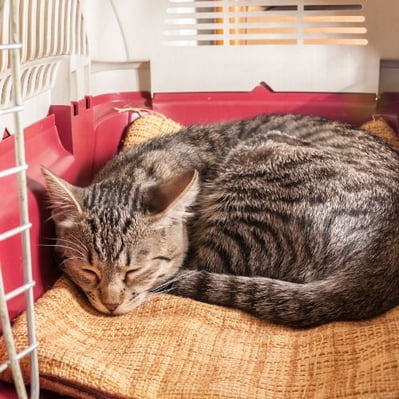
After all, unrestrained cats can be a distraction, interfering with your ability to steer or brake, and even become a dangerous projectile in the event of a crash or sudden stop. Like in this case of a cat loose in the car, distracting the driver and causing three accidents! In order to make restraint stress-less for your kitty and yourself, spend some time training your cat to love their carrier before the big travel day arrives.
Don't have a carrier for your cat yet? See further below for our recommendations, including carriers that are crash test certified.
Step 2: Get your cat to love the car.
Now that your kitty loves their carrier, it’s time to get them loving the car, too! Here are some steps to help you do that. Pro Tip: This car acclimation step is best done with two people … one to drive the car, the other to pet, praise, and treat kitty! That said, it can be done with one person, too, but very carefully.
- Take kitty out to the car, in their carrier.
- With the car parked and the doors and windows closed, sit in the back seat with your cat in their carrier. Partially open one of the carrier doors to get your hand in to play with your cat, pet them, praise them, and give them treats. (Caution: For your own safety and that of your cat, avoid doing this type of in-car training when the weather is too hot or too cold.)
- Once kitty seems settled in and happy in their carrier in the car, place an interactive, treat/kibble-dispensing toy in their carrier with them (the Egg-Cersizer and the SlimCat are great choices ).
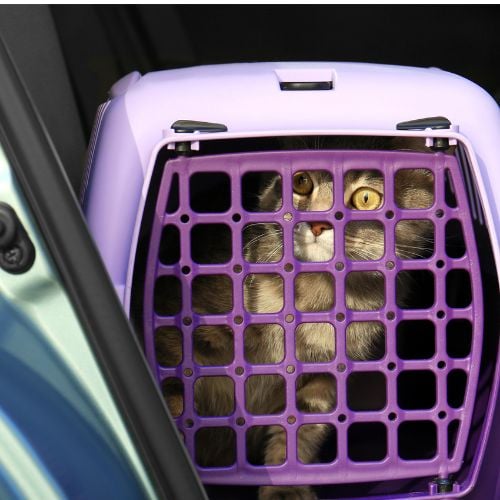
- Caution: If your car is parked in your garage while you’re doing this acclimation for your cat, either ensure that your garage door is open or move your car out of the garage and onto the street or driveway. Carbon monoxide is very dangerous for both of you!
- Once your cat is comfortable with the sound and vibration of the engine, it’s time to take some short trips. You don’t want to overdo it here — just go down the street initially, then progress to a block or two, and then gradually extend the distance of the drives. Also, if you frequently drive with your windows open, try some of these "test" drives with the windows down for a bit to see if the sound of the air passing by and the changing air pressures are OK for kitty. Never push these drives further than your cat is comfortable with. Also, be sure to drive calmly and go easy on the gas pedal and brakes. Note: This step will be best with more than one person in the car so that someone can continue to monitor, soothe, and play with kitty while the other person does the driving and focuses on the road.
- Continue to do these steps each day or every few days, and kitty will soon be more than happy to join for car rides! Note: Since each cat and each situation are different, it could take anywhere from a few days of this type of training to several months for an individual cat to love car travel.
Questions? If you would like to chat with a veterinarian about traveling with your cat, Click here
Don't have a carrier for your kitty yet?
Still using the cardboard carrier your cat came home from the shelter in? Here are some of my favorite cat carriers for car travel.
Carriers for around town and shorter trips
These can also be used for longer trips with a leash-trained cat , as you won't need the extra space of the ones linked further below to put a litter box in the carrier with them. It's best to choose a carrier that has an opening at the top, as this often makes it easier and less stressful for everybody when getting them in and out when traveling or visiting the vet. The options linked below all have easy "top access."
Sleepypod carriers: The Mobile Pet Bed (this mobile pet bed may not work for flying on all airlines) and the Air In-Cabin Carrier are truly exceptional and beautifully crafted carriers, and Sleepypod takes pet travel safety very seriously . They do their own crash testing (at the standard set for child safety restraints) on their products and also received excellent marks in the Center for Pet Safety's crash testing studies. They're a bit pricier, but if you can swing it, they're well worth the money!
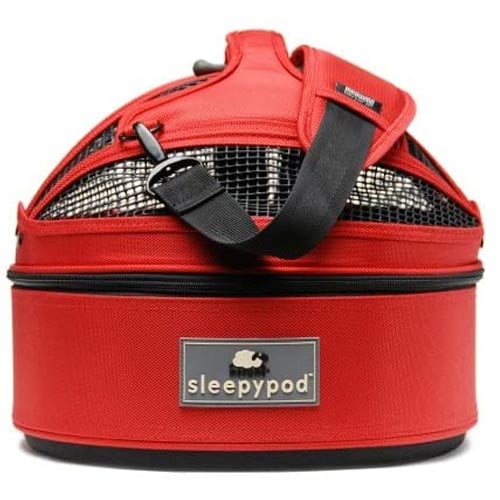
Available at:
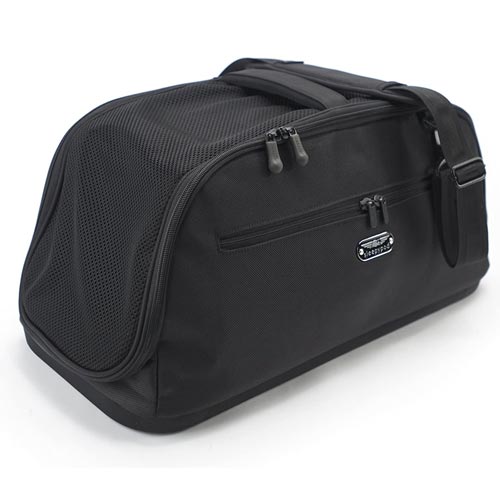
Sherpa carrier : Another good choice with a long track record of being an excellent and versatile cat carrier, both in the car and when flying.
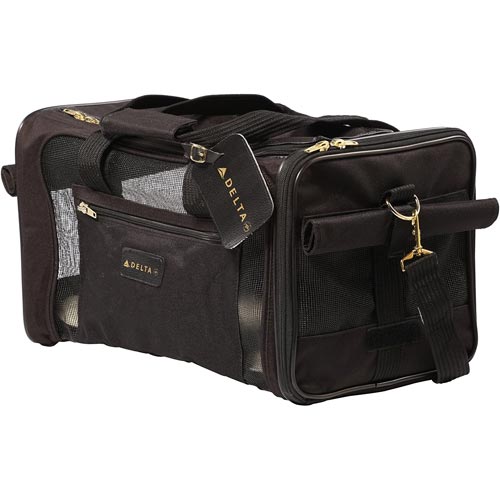
Amazon Basics two-door, top-load pet kennel : This is a hard-sided carrier that has easy open/close latches (rather than nuts and bolts) to secure top to bottom, as well as a top access door.
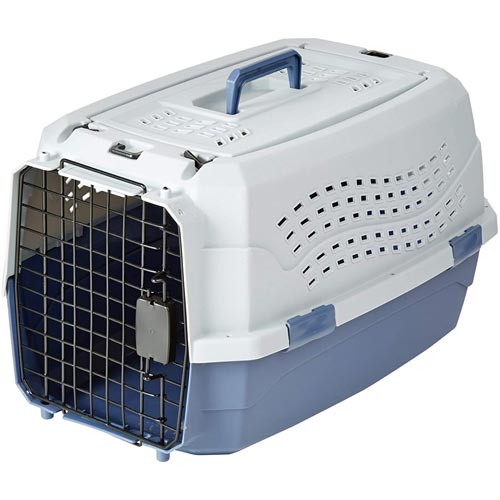
Take note that if you want to use your carrier for flying, make sure the size of your hard carrier fits in your airline's under-seat regulations, as the hard carriers aren't as "flexible" as the soft-sided ones when going under the seat.
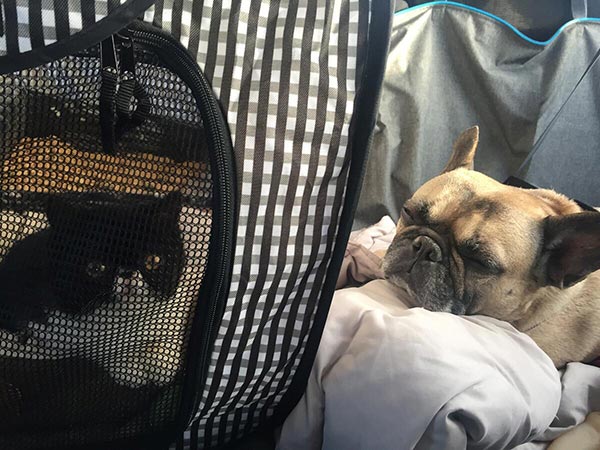
Cat carriers for longer road trips
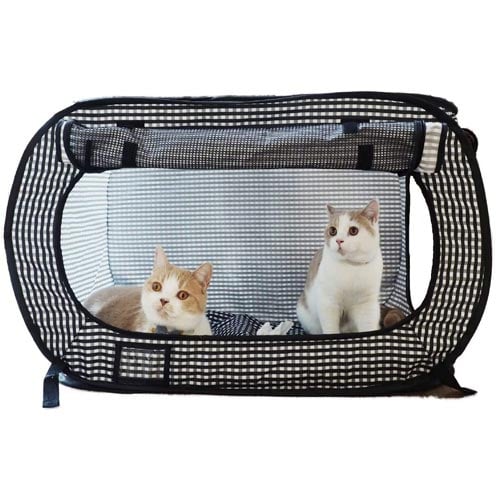
Siivton 4-sided carrier : This carrier has expandable sides making this soft-sided carrier a little more spacious for your kitty than a traditional carrier. It doesn't really have enough room for you to include a litter box for your kitty within the carrier so something to consider.
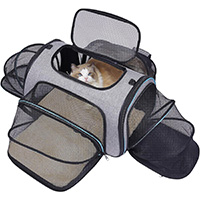
It is an "extra space" option though for car travel that also has an "airline approved" claim, unlike the portable cage (above).
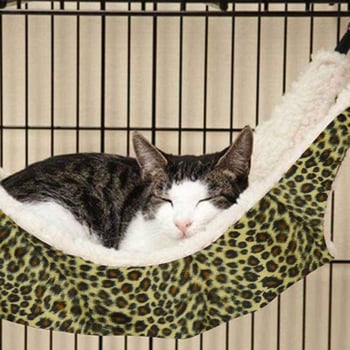
- Don’t feel like doing it DIY, or don’t have the time? Get an awesome pre-fab kitty condo instead! We know of a veterinarian who used one on a cross-country move and their cats loved it. Note: While these kitty condo options will likely help make travel less stressful and more comfortable for your kitty, they do introduce some new safety risks for them (falling from higher shelves or having shelves fall on them in the event of an accident or sudden stop) and perhaps even for you, depending on how/if you secure it within your vehicle. Please take these cautions into consideration should you select one of these kitty condo options. In order to make restraint stress-less for your kitty and yourself, spend some time training your cat to love their carrier before the big travel day arrives.
Car ride logistics with cats — where to go 'potty'
Jumping right down to “business,” … depending on the duration of your travel adventures with kitty and where you’re winding up, you’re going to have to deal with potty planning and bathroom breaks. This is the case both when you’re on the road and when you get to your hotel or wherever your destination is. You can help your cat take care of business on the road in a few different ways.
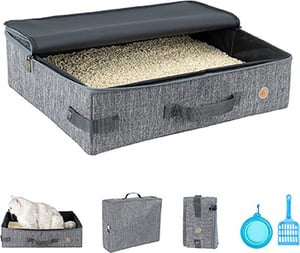
First, get them a good travel litter box, a litter they like, and (perhaps) even a litter attractant, and then get them used to using this set-up before you ever even need to use the car.
A good travel litter box will be large enough for your cat to fit in and comfortably do their business in, yet small enough to fit in their carrier (see recommended larger car cat carriers above).
If your trip isn’t too far and their carrier isn’t large enough to fit a litter box, your travel litter box for use in the hotel can be a bit larger. The travel litter box should also be waterproof, easy to clean, and collapsible (for easier storage), yet sturdy enough so as to not collapse on kitty when they’re doing their thing in it. There are also disposable litter box options available!
Recommended litter boxes for travel with cats
There are collapsible options ( Necoichi and PetIsFam ) or disposable ones ( Nature's Miracle or Kitty Sifter ). Given that you and your cat’s litter box will be in fairly close quarters, it’s a good idea to go with a litter that’s got good odor control and low dust potential.
While it might be tempting to get a fragranced litter, recognize that the fragrance could actually irritate your cat’s nose and lungs, stressing them out and making it less likely that they’ll actually use their litter box! Below are some recommended cat litters, as well as a recommended cat litter attractant, which sometimes is needed to help a cat remember to use their box, especially in a time of change, like travel.
Recommended litters for travel with cats
All of these litters are considered low-dust, are easily scoopable, and all have excellent absorbency and odor control. The first two ( Boxiecat and Dr. Elsey’s ) are clay-based, the third ( World’s Best ) is corn-based, in case your cat (or you) don’t like clay litter. I’m also including the recommended cat litter attractant in the list, as well as a scoop and items for used litter containment, as those will be important, too. The antimicrobial scoop and caddy is helpful when traveling, so the scoop isn’t laying on your car interior itself!

And depending on the size of your car, how much space you’ve got available, how long your trip is, and how averse you are to having any smell or chance of spillage, you may want to consider the excellent Litter Genie used cat litter storage system. Note: This Litter Genie also comes with the bags, as well as a litter scoop and holder! If you want something smaller than the Litter Genie, you can do the simple, sealable bucket (don't forget the lid !) and some tall kitchen garbage bags.
Is your cat used to doing their business outside , or you really don’t want the smell of cat litter and the stuff that winds up in it in your car, or there’s just no room for a litter box in your cat’s carrier? Then, depending on the length of your car trip, you’ll have to make proper bathroom stops for your cat. This is most safely done, though, if you take the time to leash-train your cat well in advance of your travel day! Don’t worry it can be done! Here’s our article on how to leash-train a cat . And another important precaution for cats that you’ll be leash walking and just traveling with in general … have them microchipped at your vet, and ensure that your contact information associated with the microchip is up-to-date !
Recommended leashes and harnesses for leash-walking cats:
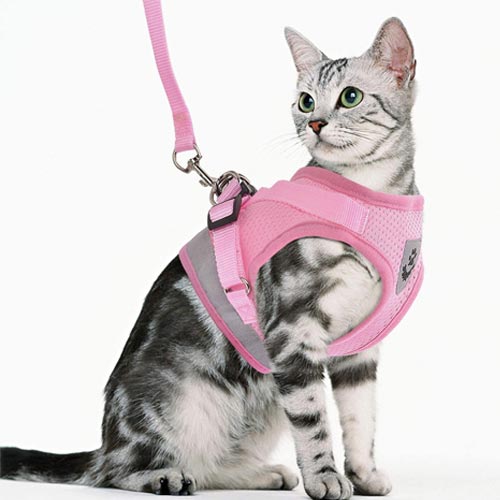
Also works well for cats.
Speaking about “doing business,” … what about if YOU have to go? What should you do with your cat?
If the temperatures aren’t too hot or too cold to have to worry about leaving your cat in the car, just leave them in their carrier and go about your business. Just try not to take too long. It's usually safe between about 40–65 degrees F (4–18 degrees C), though every cat and every situation will be different, so use this as a rough guide.
Talk to your vet about more specific safe temperature ranges for your cat based on your cat's age, breed (smushed face?), and any chronic medical conditions they may have or medications they may be on. If the temperatures are outside of that range, though, you’re going to have to take some precautions when making your own pit stops (and this includes for meals). In many cases, it’ll be possible for you to bring your cat into the bathroom with you in their carrier! This is the easiest solution if it’s possible and practical.

If it’s over the high end of the temperature range and you can’t bring kitty in with you, take some steps to ensure their comfort and safety when in the car:
- Do your bathroom break at a place where you don’t have to go into a big shop or mall to find and use the bathroom. Gas stations and rest stops along the side of the road are usually good options. Coffee shops often are, too!
- If you have an extra set of car keys with you, leave the car on and the air conditioner running and lock the doors behind you. You’ll be happier to get back into a cool car, too! Caution: This can help a lot, but be aware that car engines and air conditioner compressors can and do fail, leading to excessively hot temperatures building up in the car quickly.
- If leaving the car and A/C running isn’t possible or practical, pre-cool the car the best you can by running the air conditioner on high for several minutes before you get out.
- Park in the most well-shaded spot you can find.
- Park with your front windshield facing the sun and put up a reflective windshield sun shade like this one .
- Cracking the windows doesn’t make a huge difference, but it also doesn’t hurt (so long as your cat is securely in their carrier and there’s no danger of someone reaching in your car and stealing your stuff).
- Make sure kitty has plenty of water.
- Move their carrier from on the back seat to the floor in front of the back seat. Since hot air rises, it should be cooler on the floor.
- Be as quick with your stop as possible. If it’s a food break you’re taking, come back and check on your cat frequently (like every 10 minutes or so, just to be safe).

If it’s under the low end of the temperature range and you can’t bring kitty in with you, take some steps to ensure their comfort and safety when in the car:
- If you have an extra set of car keys with you, leave the car on and the heater running and lock the doors behind you. You’ll be happier to get back into a warm car, too! Caution: This can help a lot, but be aware that car engines and heater compressors can and do fail, leading to cold temperatures building up in the car quickly.
- If leaving the car and heater running isn’t possible or practical, pre-warm the car by turning up the heater to high (if it isn’t already) for several minutes before you get out.
- Add a nice cozy blanket or fleece to your cat’s carrier for them to snuggle up and be warm with. Pro Tip: If it’s a fleece or blanket that has your scent on it, all the better. Your cat will love “having you near” while you’re gone.
- Move their carrier to a sunny spot within the car, if there is one.
Where to stay when traveling with your cat
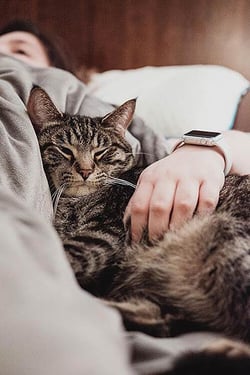
Road trips and long-distance moves with cats will often require hotel stays for sleeping and resting up (oh, and showering!). But not all hotels or motels are pet-friendly, and even those that are may only have a few pet-friendly rooms. So, here are some tips for finding pet-friendly places to stay when you’re on the road with kitty.
- If you know your route and plans, try to book pet-friendly accommodations early before they book up. This is especially important in the busy summer travel season and around the holidays.
- Some of the bigger hotel and motel chains are generally very pet-friendly. For instance, check out Red Roof Inns, Kimpton hotels, La Quinta, Best Western, and others. The folks at GoPetFriendly.com have a searchable state-by-state database to help you find pet-friendly accommodations.
- Some Airbnb properties are also pet-friendly!
Pro Tip: “Pet-friendly” means that your pets aren’t likely to have been the only pets staying in your room recently! And since not everyone uses flea and other parasite protection on their cats and dogs as regularly as they should… well, you (hopefully) get the picture. For your cat’s sake — and yours — make sure your cat is protected from fleas and other parasite infestation before heading out on the road! Learn more about safe and effective parasite prevention for your cat , and talk to your veterinarian.
Dealing with travel anxiety and carsickness with your cat
Ah, the best-laid plans... It’s possible that even if you take all of the precautions and steps outlined above to condition your cat to car travel they may still be stressed or even experience carsickness in spite of your best efforts. Here are some tips and products to help minimize those possibilities and to help deal with these problems should they arise.
- Composure calming treats for cats : These are great and can be used both before and during travel.
- Thundershirt for cats : Some anxious cats respond really well to the compressive and comforting nature of these anti-anxiety jackets. You'll want to test it out on your cat well in advance of your departure date and even do some of your "test drives" with them wearing their new jacket.
- Feliway pheromone spray : A couple of sprays of this calming pheromone on the towel or mat in your cat's carrier could be just what they need to feel less stressed and more comfortable with travel. Note that with pheromones, a little goes a long way. Don't overdo it — more is not better.
- Catnip spray to spritz their toys and catnip to sprinkle in their carrier , both can provide some great and distracting entertainment for your cat and a nice little "high" that could help reduce their anxiety.
- The likelihood of a cat getting carsick and vomiting can be reduced by not feeding them for a few hours prior to the car ride. Now, this won’t be super practical for a multi-day car trip — after all, kitty has got to eat at some point! But, if it’s just a one-day trip, this might help.
- Talk to your vet about the medication specifically designed to help prevent carsickness and vomiting in pets.
- Similarly, there are also medications your vet may be able to prescribe to help decrease your cat’s anxiety associated with car rides. But be sure to speak with your vet well in advance of your expected departure date, as your kitty may need a current exam, and doing trial or test doses is often necessary to determine what the best and most effective dose or combination will be for your cat.
- Some cats also benefit from and respond to calming music to help reduce their anxieties. And, who knows, it may just help make the drive more pleasant for you, too.
Emergencies on the road
Emergencies do happen, and so the occasion may arise where you’ll need to find a vet when you’re on the road. You can always Google “emergency veterinarian in __zipcode/town__” or use a vet emergency locator .
Questions? To chat with a veterinarian while on the road, Click here
First Aid on the Road
You'll also want to consider putting together a pet first-aid kit for your car. Here's a shopping list of first-aid essentials . Look for the icon of a little car 🚗 as it's these products that are the most essential in a smaller, travel-sized first-aid kit.
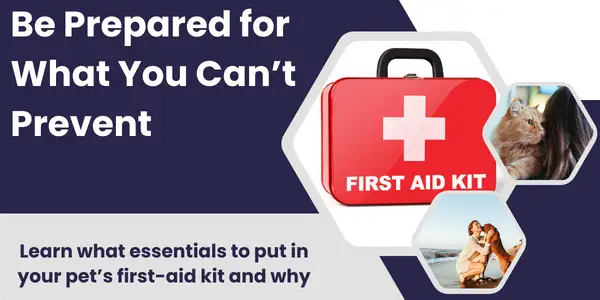
Special travel considerations for cats with chronic health issues and on medications
Before striking out on the road for a long trip or moving with a cat that’s got a chronic medical condition or is on long-term medications — like a cat with diabetes or chronic kidney disease — there are a few steps and precautions you should take.
- Make sure your cat has had a recent (ideally within the past month or so) exam with your vet. You’ll have more peace-of-mind knowing that their condition is as well managed as possible and that they’re as healthy as can be before hitting the road with them. Your vet will also have recommendations for making their trip as comfortable and safe as possible.
- Bring a copy of your cat’s medical records with you! This should include recent exam notes, laboratory test results, and medication/supplement names and dosages. Your vet can often print these out (with enough notice), and they may even subscribe to an app or other service that allows you to keep updated copies of such records with you always on your phone. This will make visiting another vet on the road if you have to, much easier.
- Especially with cats with known chronic health concerns, it’s a good idea to know about a few vet hospitals along your route and in the area of your destination before you head out. See the vet locator tools and links listed in the section above to start searching.
- If your cat is on a special prescription diet, like for their kidneys, make sure to stock up on it from your vet before hitting the road. It’s not always easy to get prescription diet refills when you’re away from home and your vet’s office! You should take enough with you to last for the duration of your trip PLUS an additional (at least) 2 weeks.
- Similarly, be sure to stock up on your pet’s medications and supplements, as well as any supplies you need for them. This would include needles and a sharps container for safely disposing of and storing used needles for diabetic cats, pills for blood pressure, overactive thyroid, and any other chronic medications. Again, you should take with you enough to last for the duration of your trip PLUS an additional (at least) 2 weeks.
- Pro Tip: Depending on the type of insulin your cat is on, you may be able to get an insulin “pen” that may be more stable outside of the fridge and may be easier to administer to your cat on the road. Talk to your vet to see if an insulin pen is an option for your cat — it isn’t for all cats, but if it is for yours, it could be a great travel (and even long-term) solution for you.
We encourage you to leave a comment below if you’ve got any tricks, tips, or products you’ve used that made car travel with your cats easier. Best of luck on your travels or your move. Have fun and be safe! And be sure to come back and leave a comment to let us and our community know how your trip went.
About the author

Dr. Jason Nicholas
Dr. Nicholas graduated with honors from The Royal Veterinary College in London, England and completed his Internship at the Animal Medical Center in New York City. He currently lives in the Pacific Northwest.
Dr. Nicholas spent many years as an emergency and general practice veterinarian obsessed with keeping pets safe and healthy. He is the author of Preventive Vet’s 101 Essential Tips book series.
Related Articles

How to Take a Car Trip With Your Cat
:max_bytes(150000):strip_icc():format(webp)/jenna-stregowski-tsp-bio-page-300fa370d15f4fb1ae407340bb7ea3ae.png)
It's no secret that most cats hate car rides. During their lives, most cats only take occasional car trips. Car rides are often just to the veterinarian, leaving the cat with a negative impression of the car. Plus, people don't tend to take their cats on car rides very often, so they may never get used to the feeling of it.
If short trips are stressful for your cat, then long trips will probably be worse. If you are planning a long car trip with your cat, you may feel overwhelmed and worried, especially if you know your cat gets stressed out in the car. While you may never be able to get your cat to love car rides, you might be able to get him used to them enough to reduce his stress.
How to Get Your Cat Used to the Car
Chances are your cat associates car rides with vet visits . Most cats get very stressed at the vet, so this association can make car rides dreadful for everyone. Don't let this keep you from taking your cat to the vet for annual or biannual check-ups. Instead, start practicing the routine of a car until your cat starts to relax. This process can eventually reduce the stress associated with car trips.
First, begin leaving your cat carrier out with the door open so your cat can explore it. Put a soft bed or blanket inside along with a favorite toy and/or some extra tasty treats. Don't close your cat inside yet, just let him get used to it. Offer additional treats if he gets to the point where he is willing to remain in the carrier for a few minutes. If your cat is worried about the carrier, consider spraying the inside with a feline pheromone like Feliway to promote a sense of calm. However, do not directly spray your cat with pheromones. You can also try putting some catnip inside the carrier if this is something your cat enjoys.
Next, practice closing your cat in the carrier as if you are about to go for a car ride. Pick up the carrier and walk around with it. Afterward, let your cat out and offer valuable treats. Increase the length of time you walk around with your cat in the carrier. Once your cat starts to relax, try bringing the carrier out to the car, but don't go anywhere. Reward them with another high-value treat.
Then, add small trips to nowhere. Take a ride around the house, then bring your cat back home and let him out of the carrier. Once again, offer plenty of yummy treats .
Gradually increase the length of car trips without using your cat too far. If your cat is vocalizing loudly or panting, then the trips became too long too quickly. Slow down the process and see if your cat adjusts.
Preparing for a Long Trip
If you plan to take a longer trip, perhaps a few hours or more, then it's best to get your cat ready in advance.
Before the actual trip, be sure to get some things together. Make sure your cat is wearing an easy release collar or harness with identification. A microchip is also important in case your cat gets loose or lost and the collar or harness falls off. Make a list of emergency vets along the way in case your cat becomes ill.
The night before travel, put your cat in a small room with the carrier, a litter box, food, and water. This will make it easier to get your cat in the carrier the next day. Plus, it can help your cat adjust to a smaller space.
If the trip is more than two or three hours long, then your cat will need a break. Bring a litter pan, food, and water along with you on the trip. Take a break every two or three hours so your cat can relax, eat and drink, and use the litter box.
What to Do If Your Cat Won't Get Used to the Car
Some cats will never be able to calm down for car rides, despite your best efforts. These cats may benefit from calming supplements and/or medications. Talk to your vet about the best options for your cat.
Nutritional supplements like Solliquin can help your cat relax without the use of pharmaceutical medications. Test this out in advance before you venture out for a long trip.
If supplements are ineffective, then it might be time to try a stronger medication. Sedation may be the best option for the most anxious cats.
When You Arrive at your Destination
Whether you are moving to a new home or taking your cat on vacation, be aware that your cat needs time to adjust to his new environment. Gradually introduce your cat to his new space until he feels comfortable. Be patient as this can take time.
More from The Spruce Pets
- The Best Cat Carrier For Road Trips Is Crash Test Certified
- The 11 Best Cat Carriers of 2024, Tested and Reviewed
- The 8 Best Dog Car Seats and Restraints, Tested With Real Dogs
- How to Move With a Cat
- The 6 Best Backpack Cat Carriers of 2024, Tested and Reviewed
- The 7 Best Dog Bike Baskets for Your Small-Breed Passenger
- The 8 Best Dog Backpack Carriers Tested With Real Dogs
- How to Travel With a Rabbit in a Car
- The 6 Best Dog Seat Belts for Your Next Road Trip
- How to Crate Train Your Cat
- How to Prepare Your Cat for an Annual Veterinary Exam
- 8 Tips to Make Traveling with Pets Much Easier
- The 5 Best Cat Strollers of 2024, Tested In Our Lab
- Is Your Cat Depressed? Signs, Causes, and Treatment
- The 10 Best Calming Aids for Dogs of 2024
- Understanding the Different Types of Pet-Friendly Transportation Options
- Cat Behavior
- Health & Care
How to Travel Long-Distance With a Cat: 15 Tips & Tricks
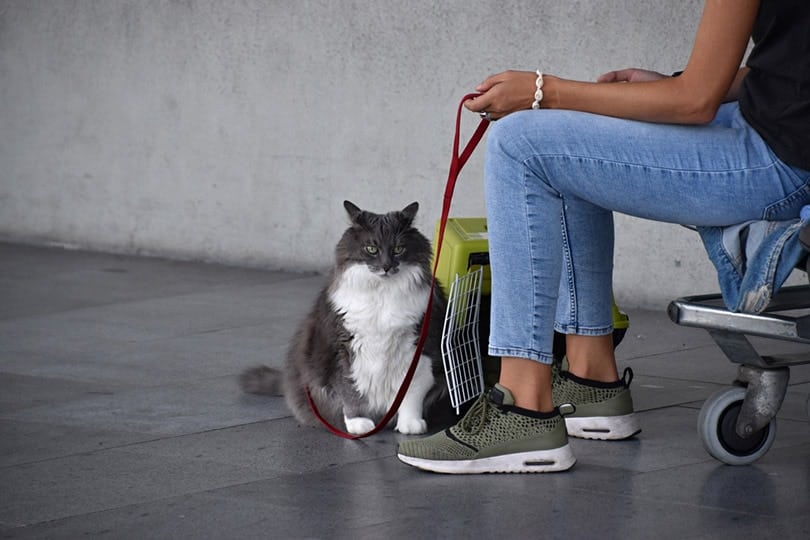
Image Credit: Helena Zezulkova, Shutterstock
Last Updated on March 18, 2024 by Catster Editorial Team
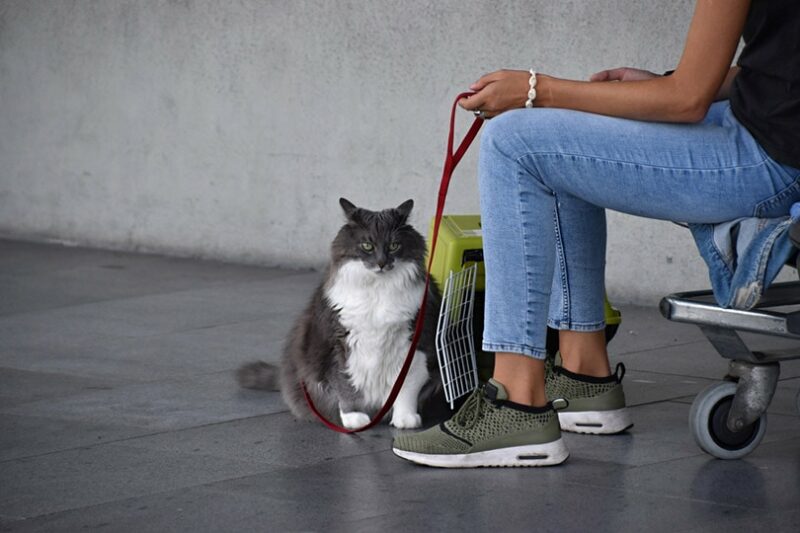
VET APPROVED
REVIEWED & FACT-CHECKED BY
Dr. Maxbetter Vizelberg DVM
The information is current and up-to-date in accordance with the latest veterinarian research.
Whether you are moving across the country or just taking a long road trip, traveling long-distance with your cat can be concerning. Some cats don’t like to travel, and it’s easier to leave them at home with a caregiver while you’re away. However, in some cases, it’s necessary to bring your cat with you. Relocation and extended trips may require that your cat come along, no matter how they feel about it.
In this article, we have tips and tricks for long-distance travel with your cat. First, we look at the best ways to travel with your cat in a car and then for traveling with your cat on an airplane.

- Before You Go
Talk to your vet about traveling with your cat, and make sure the animal is healthy enough for the experience. Ask about any prevalent diseases in your destination, and ensure that your cat has the necessary vaccinations. No matter how you’re traveling, you should always have your cat’s identification tags on their harness and be sure that they are always wearing the harness attached to a leash when they are not in their carrier.
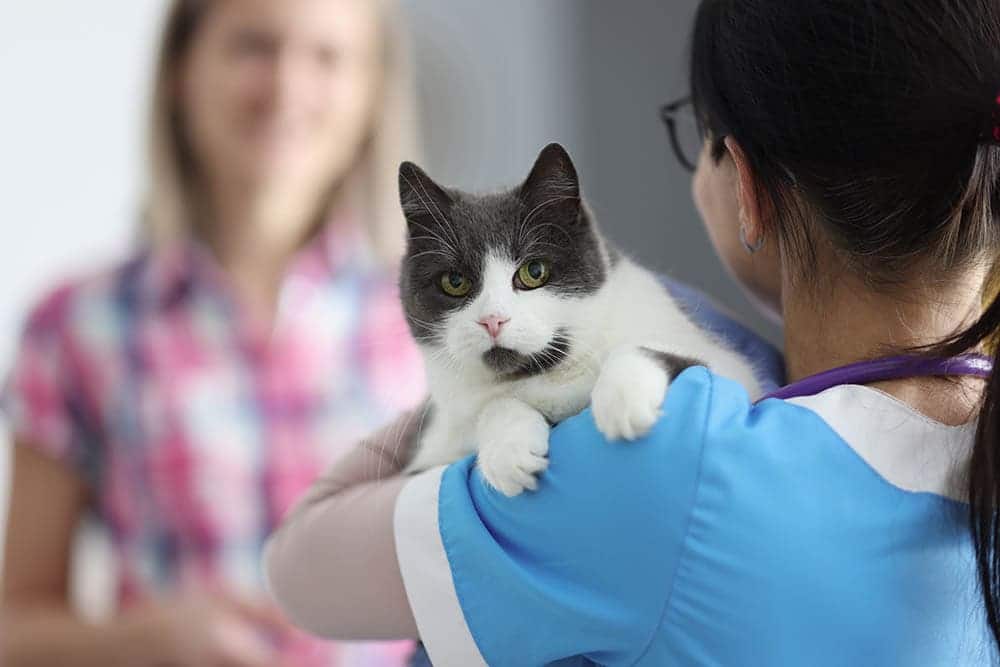
As you plan your route, check for emergency veterinary hospitals along the way just in case you need one. Pack the cat’s medical records, paperwork, and vaccination records, and keep them handy. Plan to stop at pet-friendly hotels in advance so you aren’t scrambling to find one when you want to stop driving.
Book a flight with the fewest stops, if possible. Ask about the airline’s animal policies, and try to book a flight that will allow your cat to be in the cabin with you instead of in the cargo area. Find out the rules for this ahead of time, as they vary by airline.
- The 9 Tips for Long-Distance Travel With a Cat in a Car
- 1. Familiarize Your Cat With the Car
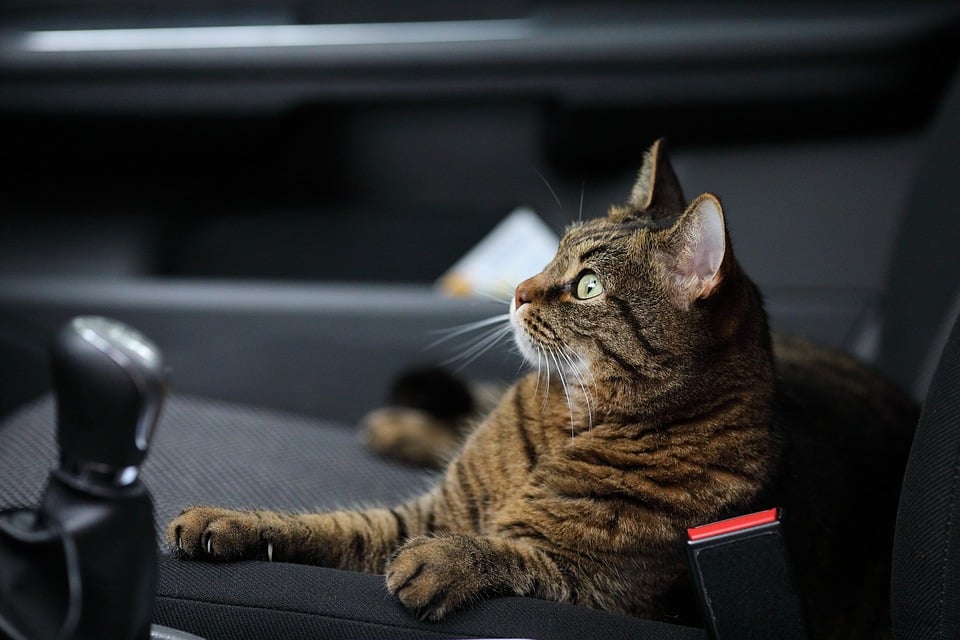
Cats may associate the car with vet trips and be anxious during them. Before the trip, start taking your cat for short rides in the car. Frequent rides that don’t end with vaccinations or exams may get your cat comfortable with being in the car. If they’re used to the vehicle, they’ll be calmer on a long trip.
- 2. Choose & Familiarize Your Cat With the Carrier
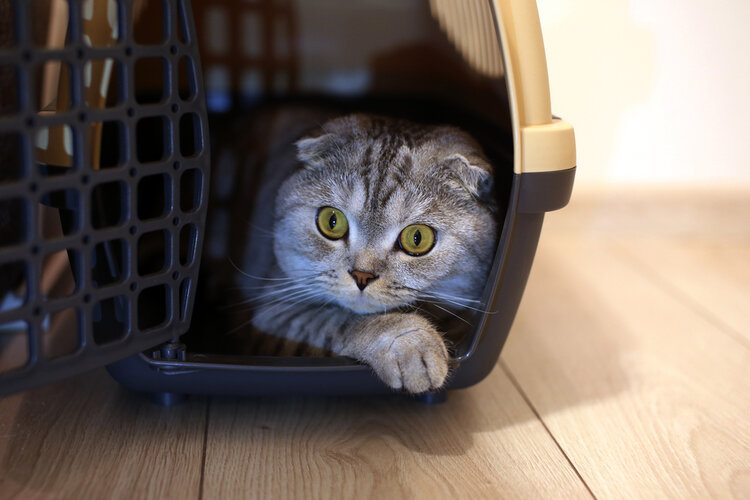
Choose a carrier that is comfortable, well-ventilated, and large enough for your cat. We don’t recommend traveling with your cat loose in the car. If there is an accident, your cat could get injured or escape and be lost in unfamiliar territory. If a door is opened and your cat isn’t secure, they could bolt. A carrier is the safest place for them. Be sure that when your cat is in the carrier, they are not wearing a collar or anything that could get caught and tighten around their neck. Have a harness and leash handy for stops. Only open the car doors once your cat is leashed, so they can stretch their legs outside. If you’d like to put a litter box in the carrier, make sure there is enough room for your cat to rest comfortably away from it.
Before the trip, leave the carrier open in the house and let your cat smell and get used to it. You can even feed them inside of it to help them learn that it’s not a scary place to be.
- 3. Feed Your Cat Before Leaving

Feed your cat between 4 and 6 hours before you leave. Their food needs time to settle so it doesn’t make them throw up. If you know that your cat gets motion sickness , this is especially important. Bring food and plenty of water that is just for your cat with you on the trip so you can feed them at their regular mealtimes. These should ideally correspond with your own times to stop, rest, and eat. Give your cat time to digest their food before you continue.
- 4. Ventilate the Car If You Leave
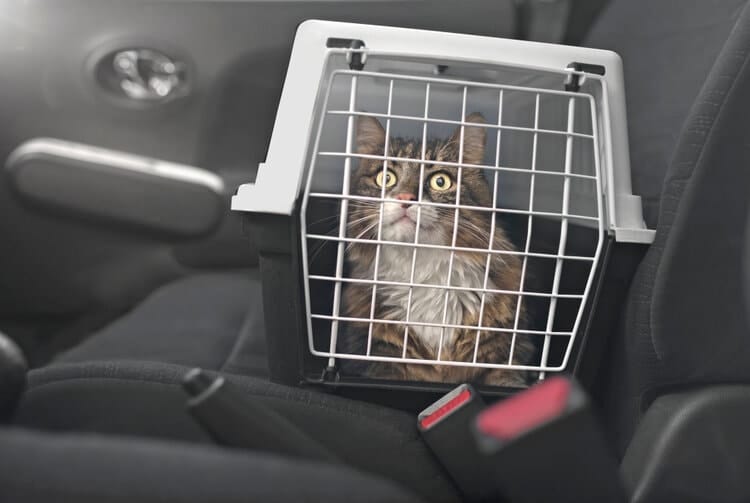
If you must park and leave your cat in the car, use caution. Leave your cat in the carrier, and roll down the windows about 1 inch. No matter what the weather is, don’t leave your cat alone for more than a couple of minutes. The car can heat up to dangerous temperatures, even if the weather feels pleasant to you. It can also get cold quickly, so always keep your pit stops as short as possible.
- 5. Make Their Carrier Comfortable
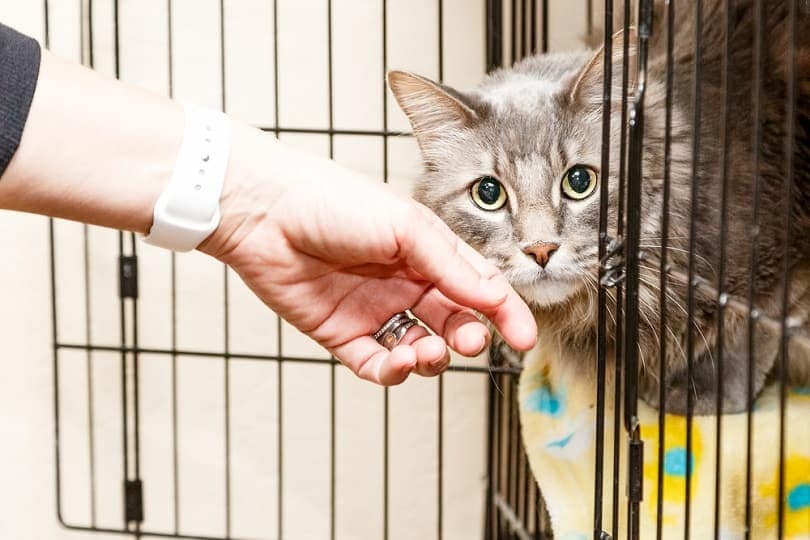
Since your cat will be spending most of their time confined to the carrier, it should be a comfortable experience for them. If they have a bed, put it in the carrier. Add blankets or towels that smell like home. You can also give them toys or catnip.
The carrier should be in a place where the cat can see out of it. Even if the car is packed full, be sure to give your cat a way to look out and see what’s happening around them. If your cat is nervous, you may want to line the carrier with pee pads in case accidents occur. These will keep the carrier floor dry in case your cat pees or vomits.
A travel litter box is convenient because it’s small and easy to transport. It can fit inside most carriers if you want to give your cat the option to use it. If you don’t put a litter box in the carrier, be sure to stop regularly and let your cat use their litter box either in the car or outside on a leash and harness.
The best cat leashes are sturdy, comfortable to hold, and easy to attach to the harness. Hepper's Cat Harness & Leash Set offers all that and more, which is why we highly recommend it.

- Escape Proof - Cat leashes and harnesses for walking aren't all equally secure. Our double aluminium...
- Superior Comfort - Our cat harnesses are lightweight, made with premium velvet fabric, breathable...
- Free Extra Strength Leash - You don't need to worry about your cat escaping this harness. This cat...
This set includes a lightweight velvet and mesh harness with reinforced stitching, quick-release buckles, and reflective strips, plus a five-foot leash made from sturdy nylon climbing rope. We especially love this leash's rotating clamp and padded neoprene handle.
At Catster, we’ve admired Hepper for many years and decided to take a controlling ownership interest so that we could benefit from the outstanding designs of this cool cat company!
- 6. Keep Your Cat Calm
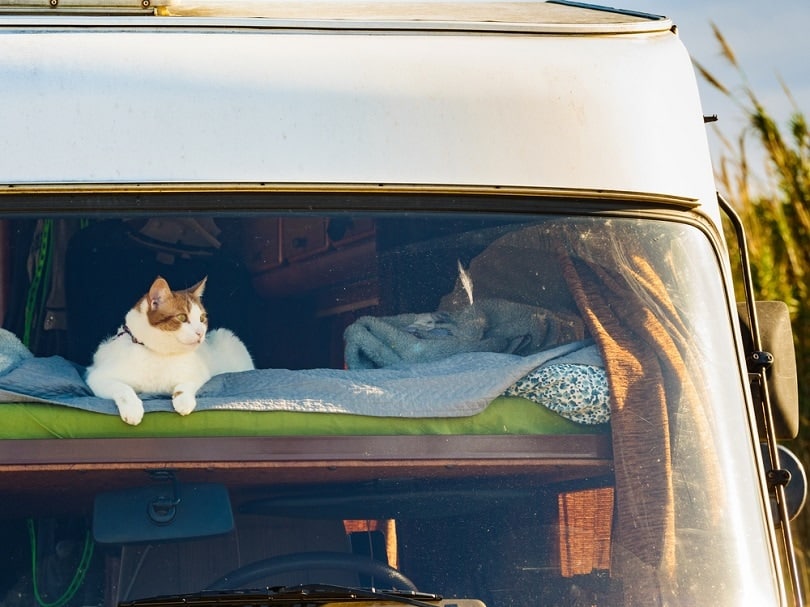
Calming pheromone spray or anxiety-reducing treats might be helpful if your cat gets nervous while traveling. Speak to your vet before using anything new. They may even prescribe medication to calm your cat if they get severely stressed in the car.
- 7. Pack the Essentials
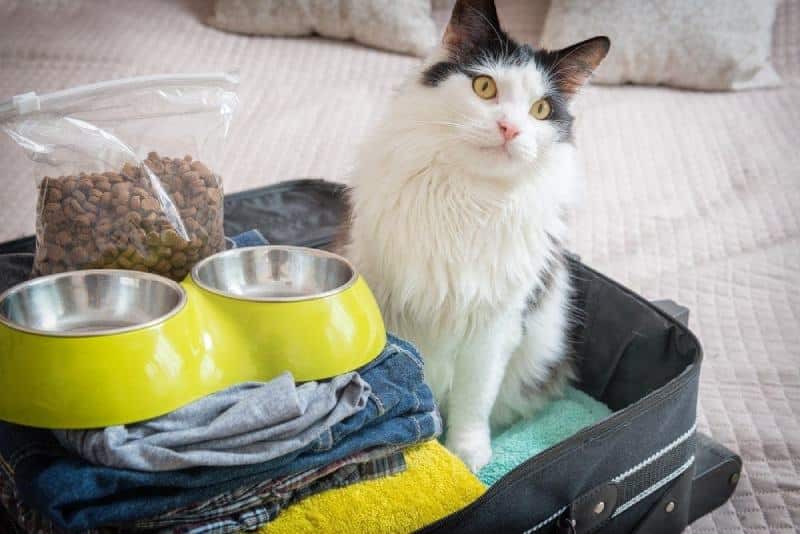
You’ll need your cat’s food and water bowls, treats, litter, litter scoop, litter box, and food all within easy reach in the car. You can use travel food and water bowls on the road because they can fold up and be stored while you’re driving. This way, their regular bowls can remain packed away. Keep your cat hydrated by leaving a small dish of water in the carrier or offering water to them at regular intervals.
- Read more: What to Pack When Traveling with Your Cat: 11 Essentials for Your List
- 8. Maintain the Car Temperature
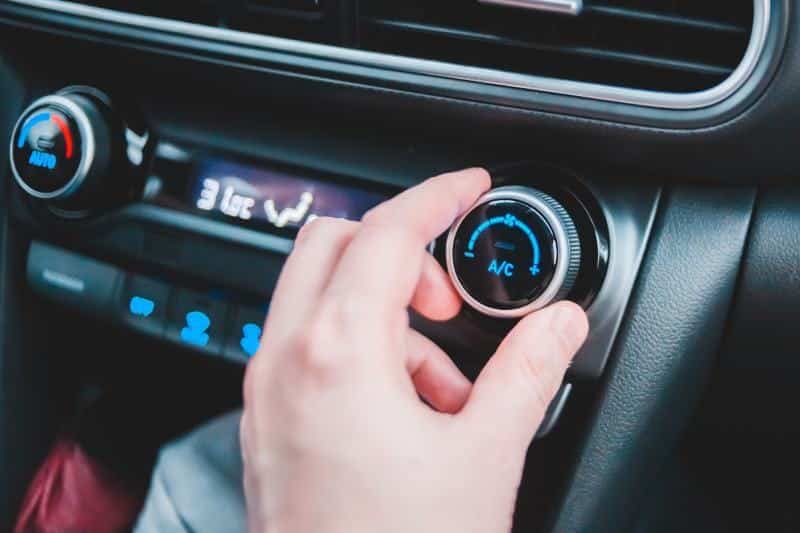
Good air circulation in the car will prevent your cat from getting too hot. If your car doesn’t have air conditioning and you’re traveling in warm weather, wrap ice packs in a towel and put them around the carrier to help your cat stay cool. Refresh these with new ice whenever you stop.
Make sure the carrier isn’t in a place where the sun is beating directly on it and the cat can’t escape it. There should be shade in the carrier at all times, even if you have to cover half of it with a towel. Check your cat regularly for signs of discomfort.
- 9. Take Breaks
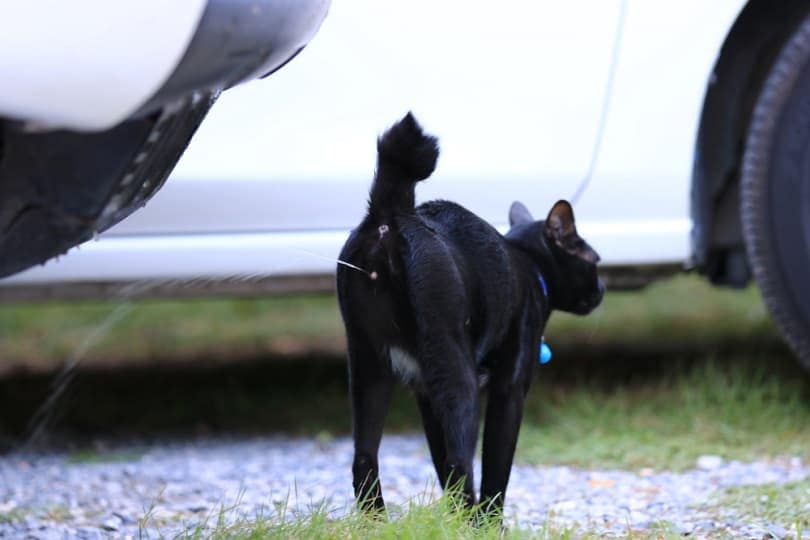
Stick to a schedule that allows for frequent breaks. Your cat will need to eat and use a litter box and may not feel comfortable doing either of these things inside the carrier . If you don’t want to or can’t take breaks, plan your trip to only drive a handful of hours each day to give your cat time to rest, especially if they are nervous in the carrier.
Pet stores are great places to take bathroom breaks because you can bring your cat inside with you! This is also a perfect time to stock up on any cat supplies that you need.

- The 6 Tips for Long-Distance Travel With a Cat on an Airplane
- 10. Be Aware of the Pet Policy

Learn the rules of the airline regarding animal travel , and make sure to follow them thoroughly to avoid delays and to keep your cat safe. Be sure to use a carrier approved for your airline.
- 11. Practice Security Protocol
You will need to remove your cat from the carrier and carry them through the security checkpoint. You can practice doing this at home by placing your cat in the carrier. Carry the carrier around your home, and then stop, open it, and pick up your cat. They should already be attached to a harness and leash while in the carrier. Then, walk to the next room with them. Give them treats and praise them for remaining calm.
- 12. Pack Cat Supplies in Your Carry-On Bag
A folded travel litter box, a baggie of litter, treats, and a collapsible water bowl are handy to have with you in the cabin. If the flight is long, you can bring your cat to the bathroom and set up their litter box to give them a chance to use it. You can ask the flight attendant for bottled water and give your cat a drink. Consider what you’ll need for the length of your flight to keep your cat comfortable.
- 13. Arrive Early
Traveling with a cat takes longer than traveling alone. Plan extra time for yourself by arriving at the airport early. In case there’s any delay with going through security or reviewing your cat’s medical records, you’ll have the time that you need to still make your flight.
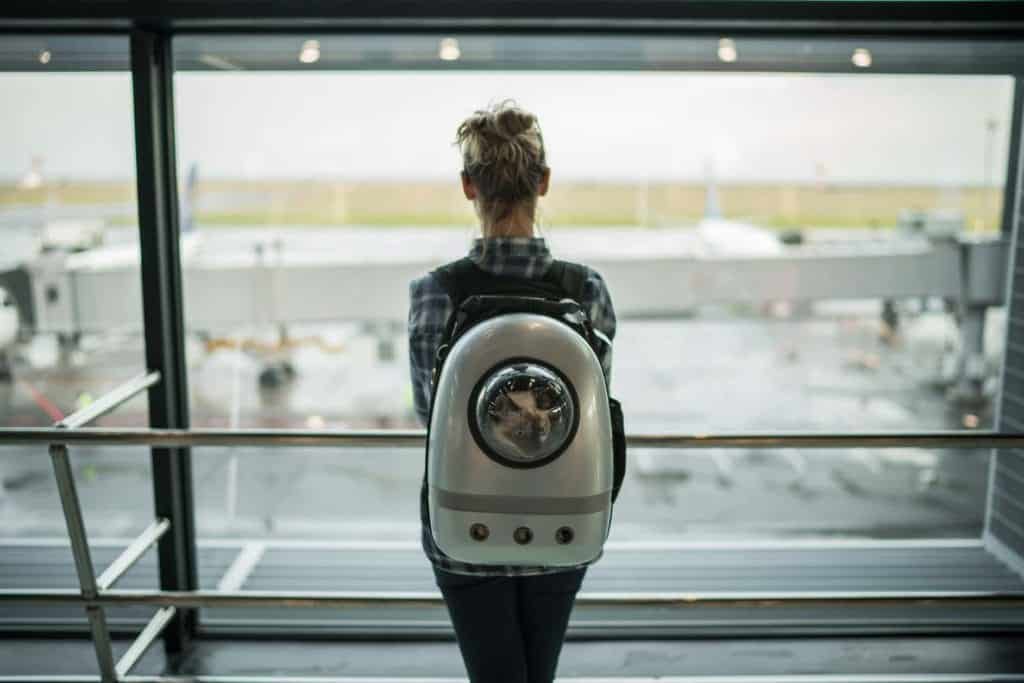
- 14. Respect Fellow Passengers
It can be tempting to take your cat out of the carrier and put them in your lap, but other passengers may not like this. Some may be allergic, and others may be scared of cats. Your cat should stay in the carrier for the entire flight unless you take them to the bathroom with their litter box. This is also the safest place for your cat to be.
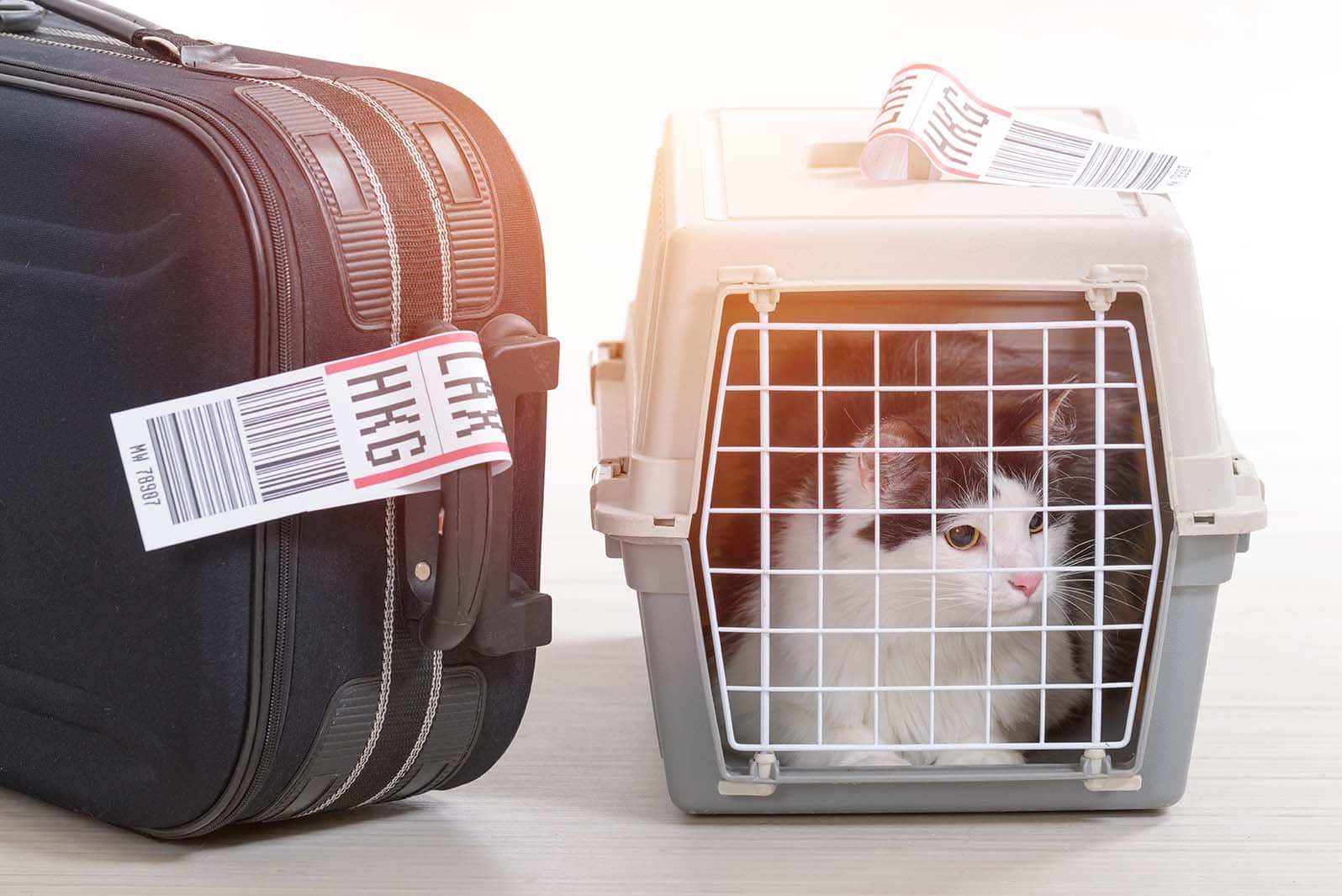
If your cat is in the cargo area, you won’t be able to see them until your flight has landed. In this case, let the flight attendants know that your cat is on board. It’s helpful to have other people aware of your animal so they can tend to them if there are delays or emergencies.
- Once You’ve Arrived at Your Destination
When you’ve finally arrived at your destination, whether it’s a new home or a hotel room for the night, it’s important to set up everything that your cat needs and make sure the area is safe before letting them out of the carrier. Close all doors and windows.
Give your cat time to adjust and get comfortable. They may initially hide for a while. Once they feel safe, they will come out to explore their new surroundings. You should have their litter box, food, water, favorite toys, and treats out for them so they know that this is a space for them.
Keep an eye on your cat, even if they’re hiding , to make sure they are safe and not getting into anything hazardous, like trying to climb into a dangerous spot. Use calming sprays if necessary.
Stick to your cat’s routine regarding feeding and sleeping times. When your cat comes out of hiding, try to engage them in playing with toys or cuddling with you. Watch for any signs of illness or things that seem out of character for your cat. If they seem to be in distress, contact the nearest veterinarian for an appointment.
If you’ve just moved into a new home, it’s best to set up an appointment with your new vet as soon as possible to get your cat registered as a new client. Be sure to update any identification tags with your new address and/or phone number.
Cats would always prefer not to travel, but if they must, there are ways to make the process more comfortable for them. We hope that these tips have helped you plan a trip with your cat’s needs in mind. Your trip will be much more pleasant when you know what to expect and take the time to make sure everything is in order before you set off.
- 5 Cat Breeds That Like to Travel: Pictures, Facts & Tips
- Traveling With Kittens: 7 Essential Tips
Featured Image Credit by: Helena Zezulkova, Shutterstock
About the Author
Jessica Rossetti
Jessica is a lifelong resident of Chicago who has shared her home with furry, feathered, and scaly pets for over 30 years. Animal enthusiast since childhood Jessica owned and operated a pet care company. Nowadays, Jessica is a full-time writer who loves to explore all animal topics while contemplating the birds and squirrels enjoying the oasis of her backyard.

10 Pet-Friendly Hotels in St. George, Utah (2024 Update)

Does Health Monitoring Cat Litter Work? Vet Reviewed Facts & FAQ
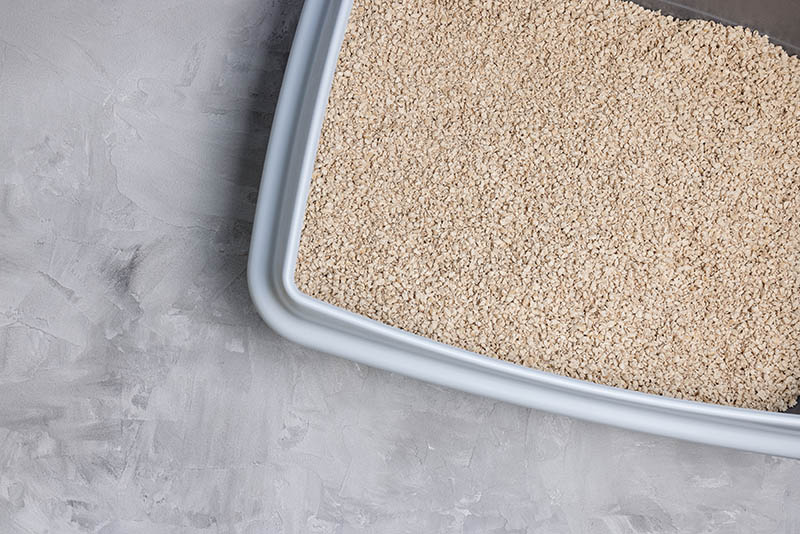
Can You Use Kitty Litter for Oil Spills? Alternative Uses, Tips & Tricks
Get catster in your inbox.

National Pet Travel Safety Day 2024: When Is It & Useful Tips
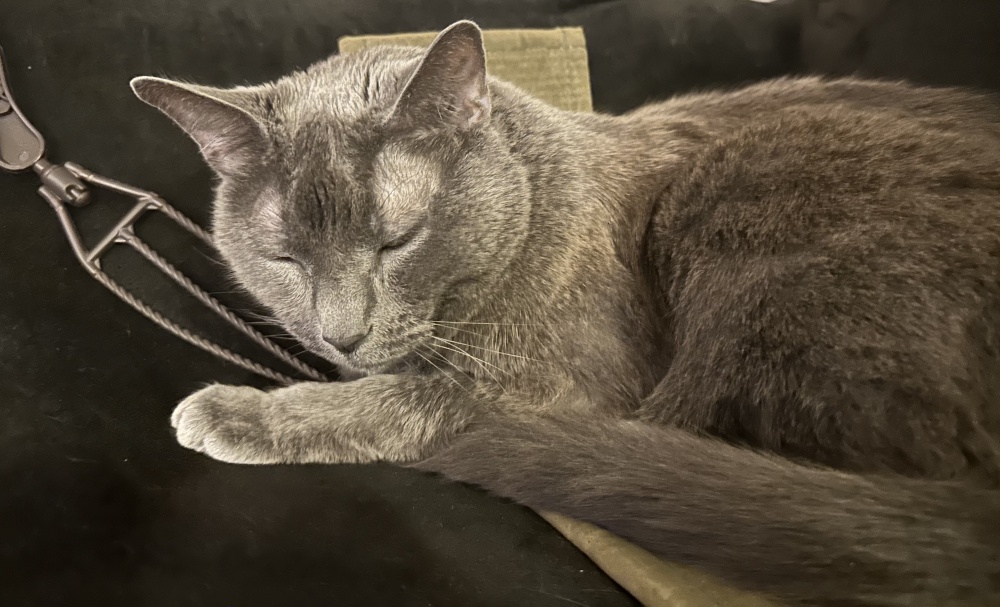
Should Cats Stay in the Cabin or Cargo of Planes? My Preference for Olga
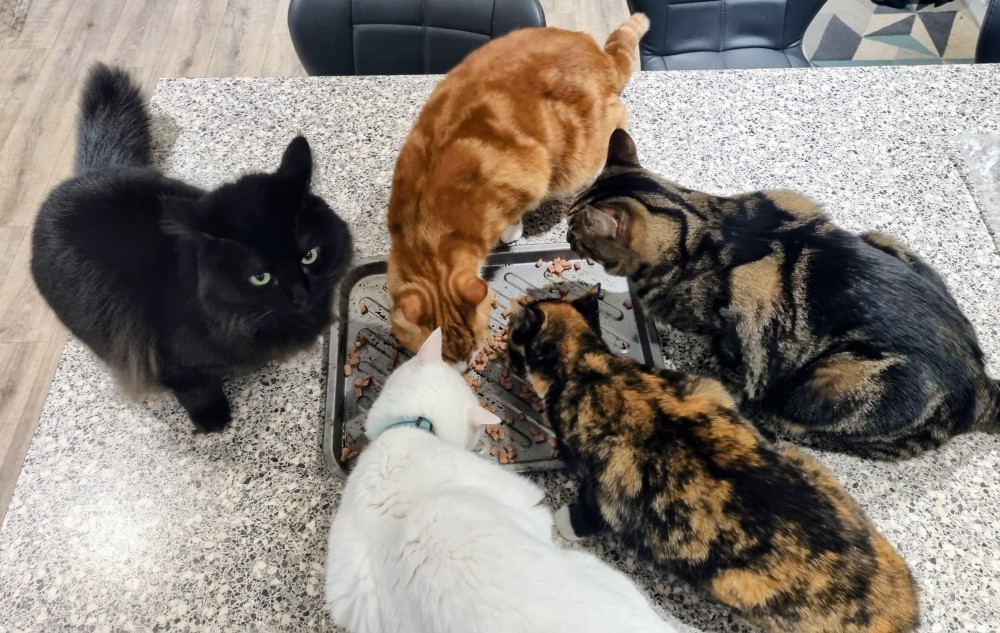
Pet Insurance: Something to Pay For, But Hopefully Never Need
© pangolia pte. ltd. all rights reserved..


How To Travel With A Cat In A Car Long Distance: 13 Useful Tips
Posted on Published: January 31, 2022 - Last updated: January 23, 2024
Categories Cat Travel , Travel , Travel Tips
So you’re planning to travel with a cat in the car?
I don’t want to tell you that travel with a cat in a car is going to be a breeze. I t’s all about your cat and their needs . Every cat is different and will behave differently in the car – especially to travel with cats in a car long distance.
A cat may be fine for a few minutes to an hour in the car, but once you hit the 3, 4, or even 8 hour mark – you can’t really know how they’re going to be?
What about the different terrains you may encounter while driving with a cat? It may not be flat the whole way so you have to be prepared for bumpy and mountainous driving conditions.
Because there are so many unknowns when you travel with cats in a car long distance, you have to prepare for the worst . Here are my top tips for when you travel with a cat in a car long distance.
P.S. If you’re traveling with cats long distance and staying overnight, be sure to read my top tips for staying in a hotel with a cat .
Psst! This blog post contains affiliate links in it which sends me a bit of extra money if you use them… at no extra cost to you!

Travel With Cats In A Car Long Distance – My Experience
My experience driving with a cat comes from my long distance road trips from Montreal to Florida, which is a 26 hour road trip each way.
Plus, we’ve also done some shorter road trips over the years together.
The drives are typically smooth sailing, but sometimes the little guy surprises me with some new behaviours. So you should always be prepared for anything!
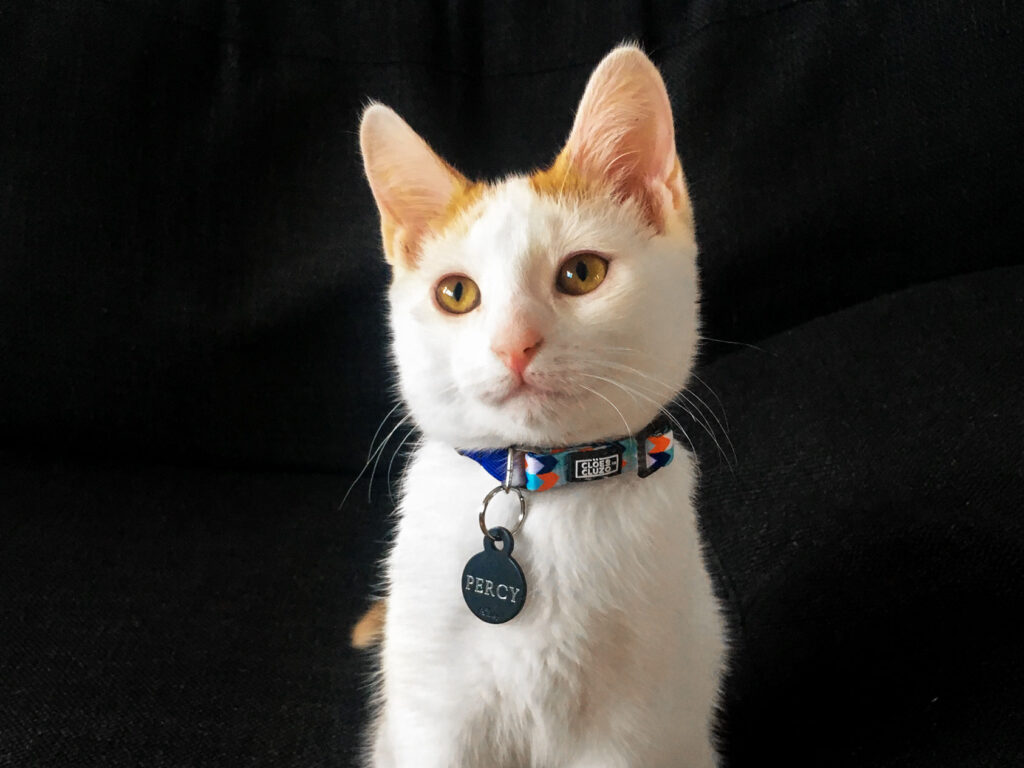
Never forget a favourite travel memory
- Everything You Should Know Before Travelling With A Cat: Is It Worth It?
13 Tips How To Travel With A Cat In A Car
Here are the top tips I’ve learned from driving with a cat in the car!
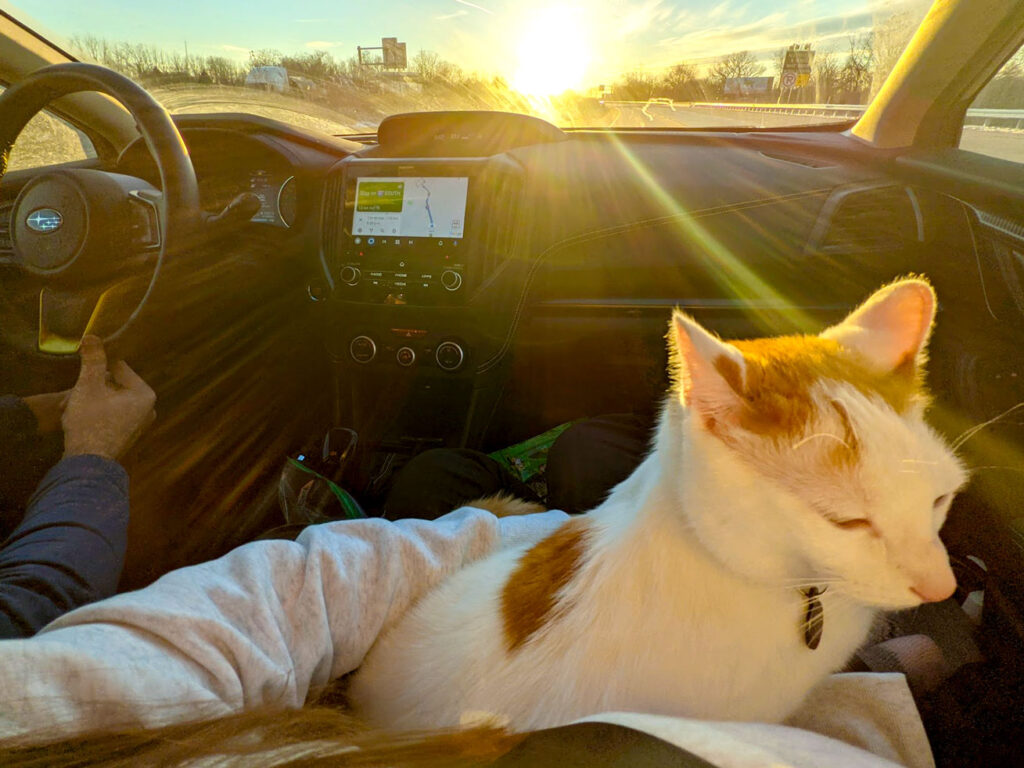
1. Find A Carrier They Love (Don’t Let Them Wander Free!)
When you travel with a cat in a car, the safest place for them to be is in a car safe carrier (like this one on Amazon ).
A free roaming cat in the car causes risks, not only for your safety but also theirs. Even the most well trained cat is risky.
There are so many carriers to choose from, from large to small. Originally I had the large carrier for him, like this one from Amazon . I thought this way my cat would be able to stretch his legs for a bit during longer journeys.
But, after a few road trips, I noticed he’s really in love with his Navigator cat backpack (see it on Amazon here ) and he’s completely okay sleeping in there for 11 hours on the road.
So now I take whatever we have space for in the car, knowing that he’s good in both!
Shop PetSeek Large Cat Carrier On Amazon

2. Get Them Used To Their Carrier Ahead Of Time
A cat’s carrier should be their safe space. You want them to be used to the carrier before ever bringing them into the car in it.
To do this, leave the carrier out in the house for your cat to constantly use. At the start, I left treats inside for my cat to find.
If you have enough time, I would also train your cat to be comfortable when the carrier is closed… this is where my cat starts to freak out.
Start closing the carrier, then give them a treat. Slowly keep the carrier door closed for longer periods of time before giving them their treat.
P.S. If you’re using a different carrier for the car and the hotel when you travel with cats in a car long distance, try to get them used to both. The car carrier is so large, we use a cat backpack to transport him from the car to the hotel.

You might also be interested in reading…
- Honest Cat Backpack Review: Pecute Cat Backpack
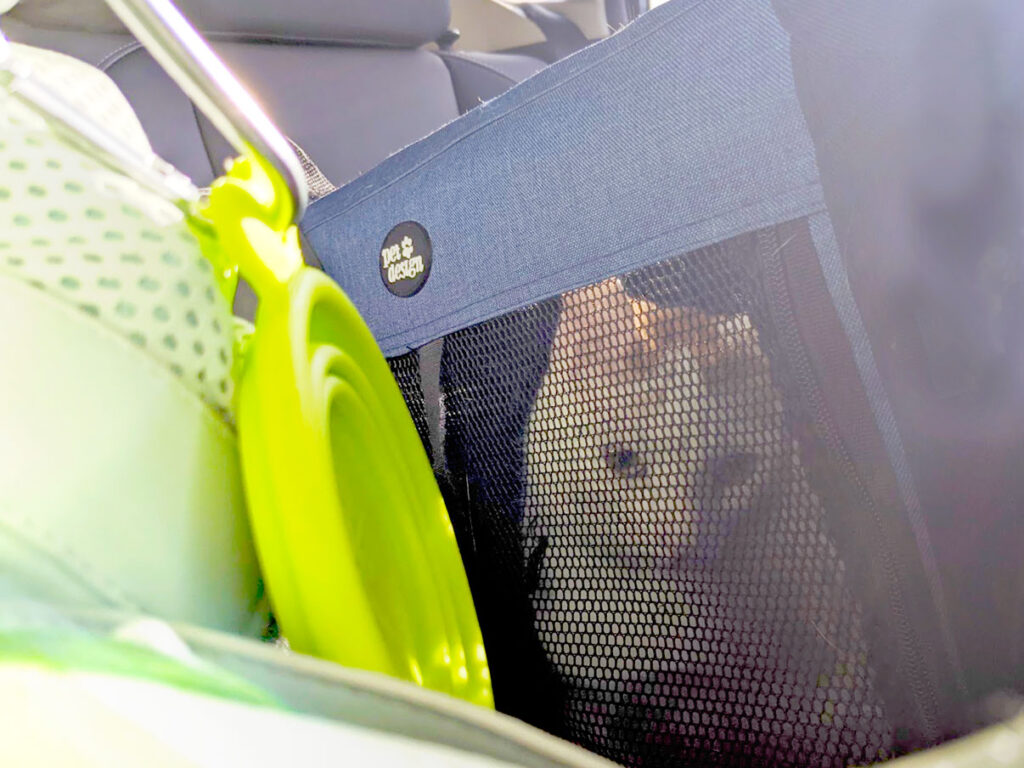
3. Travel With A Cat In A Car – Get Them Used To Driving
The best thing you can do before you travel with cats in a car long distance is to get them used to driving as much as possible beforehand .
Driving is a lot to handle for cats: there’s a lot of motion, different noises, lights …etc.
You want them to be as used to the car as much as possible before venturing on a long road trip. Getting them used to their carrier at home is one thing, bringing it into the car is a whole other ball game.
When we first started bringing our cat in the car he would meow like crazy and rip out of his carrier. I would have to sit in the back with him to put him back inside. Eventually – he learned. I can’t stress enough that this process takes time, so if you have time before you leave, there’s nothing better you can do for your cat.

How To Prepare A Cat For Travel: Training Tips & More
We started by taking our cat in the car as much as we could on short drives. Around the block, to the grocery store to pick up an online order…etc. Try going at different times of the day as well so they can be used to day time, and night time driving!
Eventually, our cat got used to it and now immediately falls asleep as soon as we get in the car.
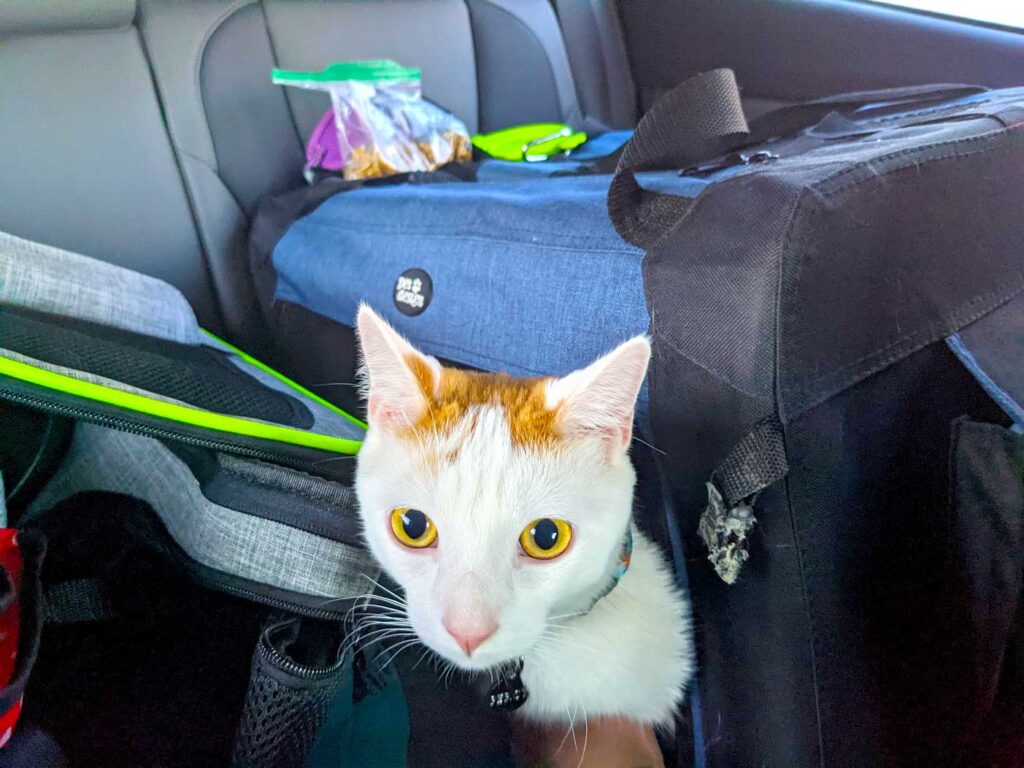
4. Make Their Carrier Feel Comfortable & Cozy
I know, it’s a lot about the carrier so far, bit this is their tiny home on wheels!
So you want there carrier to feel like home as much as possible, not a barren cold carrier they’re stuck in for several hours.
There are a few ways to make your cat feel more comfortable in their carrier to travel with cats long distances.
In the large carrier, I put his bed and a blanket inside so he has a warm place to sleep. I even put a scratcher in there if he wants to use it- although I never saw him even look at it. You can add a toy or two if you want to as well.
We did once have a poop incident, so now I always line the bottom of the carrier with pee pee pads (like these on Amazon )… but more on cat bathrooms breaks in a bit!
If you see your cat is overwhelmed in the car, you can also put a blanket on top of the carrier. This will make the space feel cozier and warmer, and now they won’t be able to see outside or any light reflections.

The ultimate cat travel planner!
My digital cat travel planner template has everything you need to travel with your cat: research pet-friendly places, cat packing lists and checklist. You can print it out or use it digitally on your phone, tablet, or computer.
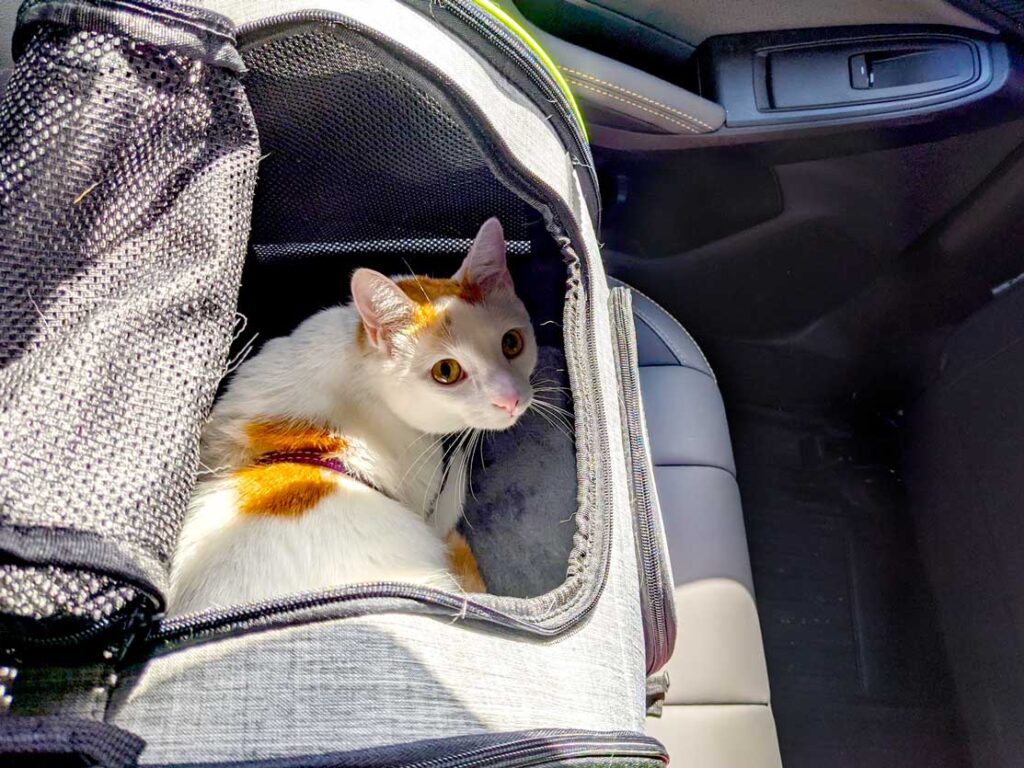
5. Car Travel With Cat: Keep Your Cat Calm While Driving
If your cat is still uncomfortable driving, you may want to get them something to calm their nerves a bit.
I’ve used a spray that mimics cat pheromones to calm them down, see it on Amazon here . Spray this in their carrier 15 minutes before you leave and it lasts from 4 to 5 hours. Heads up: people are nervous that the spray can make the driver sleepy, we haven’t noticed any issues with it.
Another option when going on a roadtrip with cats is to buy calming treats (like these on Amazon ).
If your cat needs something stronger, you can also speak to your vet about getting some medication to travel with a cat in a car.
Shop Ways To Keep You Cat Calm When You Travel With A Cat In A Car

Shop Amazon.ca

6. Be Prepared: Cats Can Hold In Their Pee… But Accidents Happen
You can try to get your cat to use their litter before leaving, but you most likely won’t be successful. And you shouldn’t really worry, cats can hold their pee for up to 24 to 48 hours , but realistically shouldn’t hold it for more than 12 hours (read more here ).
Of course, accidents do happen, especially if your cat is nervous.
With his in mind, plan for the worst. As I mentioned, after a poop incident one summer we now line our cats carrier with absorbent pee pee pads . That way, if our cat had an accident while driving, it’s an easy clean up. It’s also good to have in case your cat gets nauseous and throws up. See pee pee pads on Amazon .
You can still plan to offer your cat their litter box at every stop, but more likely than not they won’t use it… more on travel cat litter boxes soon !
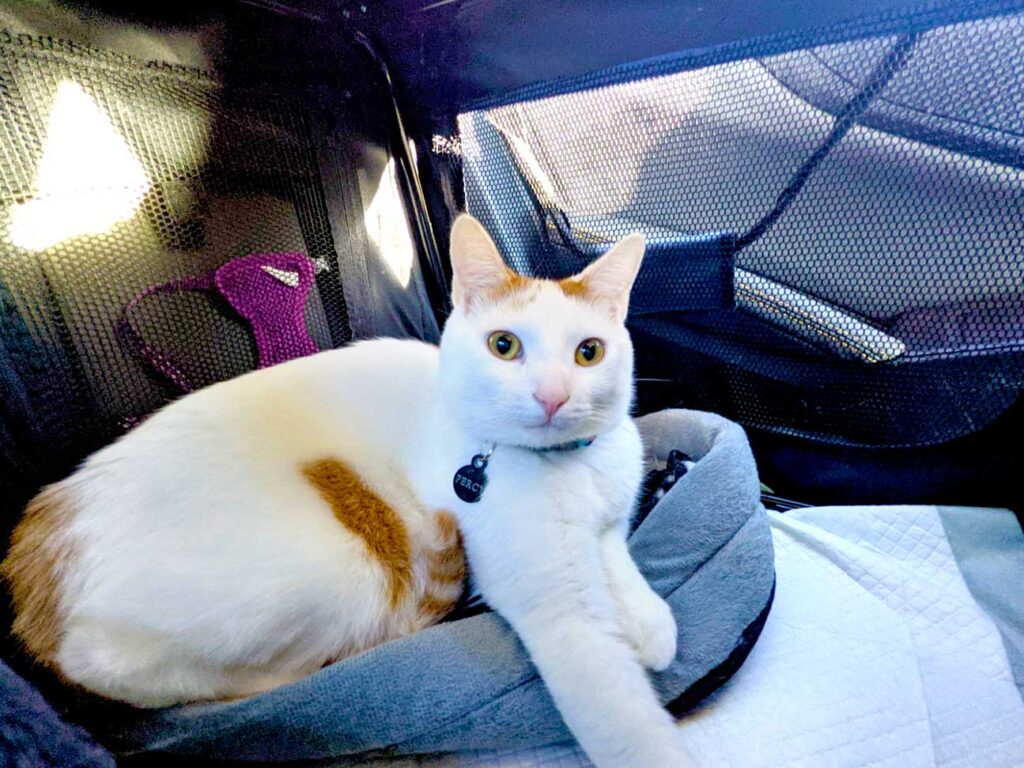
7. Buy Cat Travel Litter Boxes & Use Your Normal Litter…
A big question when travelling with a cat in the car is what to do about the litter box? It’s not like a dog that you can let out to pee on the grass.
You want to buy a smaller litter box that you can close. There are small cat travel litter boxes, like this one on Amazon , or you can just buy a small plastic container with a cover (what we do).
This way, you can easily cover it up and not worry about it spilling it in the car. Or if your cat does use it on the road trip, you can close it up and not have to worry about spelling it!
Another cat road trip tip for the litter box is to use the same litter you’re using at home ! And there are a few reasons for this…
If you buy a travel litter that comes with litter, it’s usually not quality litter that’s provided . It can be dustier and won’t mask the smell as well.
But the main thing is that your cat isn’t used to it. They’re already being introduced to so many new environments and changes – don’t change their litter on them!
Remember, you want to keep as many things as constant as you can. Using the same litter is one of the best ways to do that. Your cat is already used to it, you know they like it, why would you change it?
I even went as far as taking some old litter instead of a completely new bag (don’t worry I cleaned it out first!). But this way it already even smelled like him and he knew it was his!
Shop Cat Travel Litter Box On Amazon

8. What About Your Bathroom Breaks?
When you travel with a cat in a car, your needs often get overlooked. But they really shouldn’t.
Just like you you need to think about your cats bathroom breaks, you also have to think about your own. But unlike cats, we as humans can’t (and shouldn’t) be holding in our pee.
Depending on if you’re driving with anyone else when you travel with a cat in car, you may have to leave your cat alone in the car for a few minutes while you take car of business.
When you leave your cat in the car, make sure their carrier is closed, or they are attached to a leash. You don’t want to open the door to find them running out!
When we first started out driving with a cat, we didn’t leave him alone for a second. We were two people driving so while my partner would fill up with gas, I would use the bathroom. Then we would swap, I would stay at the car – seeing if the cat needed anything (water, food …etc.) while my partner used the bathroom. This way, it also never felt like we were ever waiting for the other person.
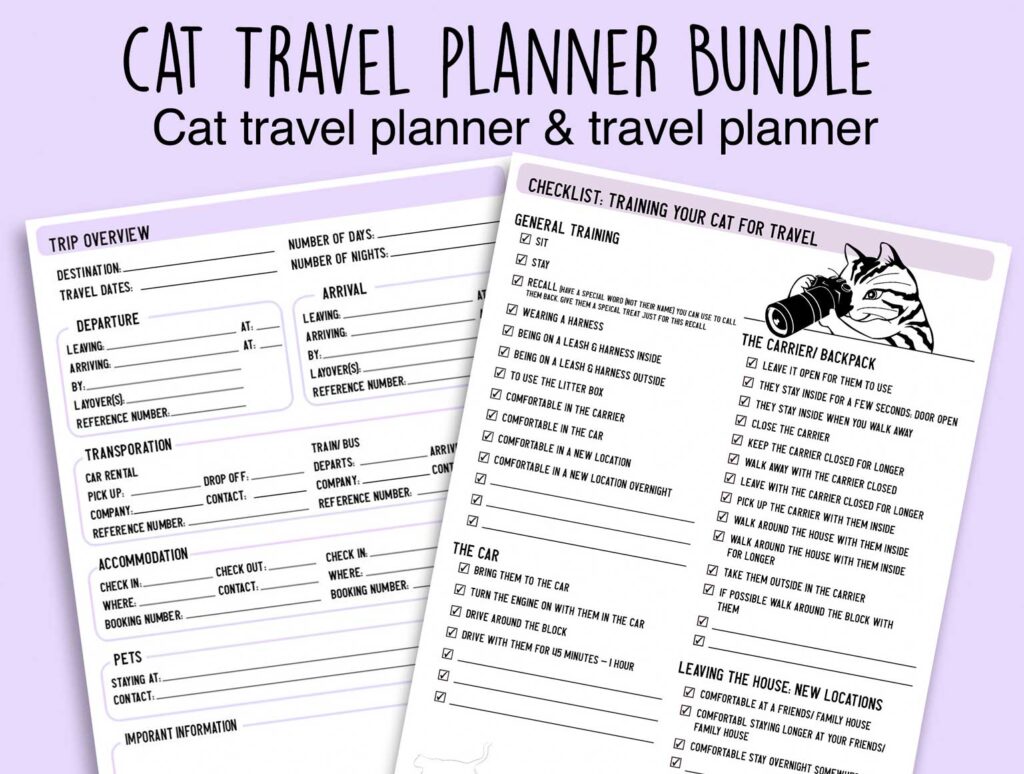
The ultimate digital travel planner bundle for you and your cat!
My digital travel planner template has everything you need to plan your vacation and it’s paired with my cat travel planner .
Click Here to see the bundle on Etsy
By the end of the trip, the cat was more used to staying in the car by himself so now we are able to leave him alone briefly.
If you’re alone driving with a cat, try to train them ahead of time to be okay in the car alone. Or another option is to use a duffel or cat backpack to bring them inside with you. We love the Pecute cat backpack for this.

9. How To Keep A Cat In The Car Hydrated!
If you’re packing water for yourself, make sure you have extra for your cat and a bowl to give it to them ( get a collapsible bowl on Amazon for this ).
Our cat didn’t want to drink water during the drive at all. Whenever I offered it to him he was too interested in what was happening outside.
It’s okay if they don’t drink during the day, but make sure they drink enough at night. Dehydration in cats is a real thing.
To make sure my cat stayed hydrated on our road trip I bought chicken in water from Purebites . You can also buy wet food to give them when you arrive at your destination to make sure they’re getting enough water.
Roadtrip With Cats – Keep Your Kitty Hydrated

- Made with only 1 ingredients; 100% pure Chicken Breast in water.
- 100% Natural & Grain Free, High in Protein and only 32 calories per tray.
- Cat parents love PureBites because our treats are rich in nutrients for a happy and healthy life

10. Pack A Quick Access Bag With Your Cats Necessities
You’ve packed everything for your cat and maybe even have a separate overnight bag for them.
But you’ll also want to pack a quick access bag. This bag will keep everything you may need for your cat while you’re driving . You can either keep it in the front with you or have it accessible in the back seat.
It should carry all your cats necessities and what you’ll either need in the car or when you stop. I packed a small bag of treats (two kinds for a nice variety!), food, his harness and leash, collapsible bowl, Feliway calming spray, and a toy.
You should also keep any medication that your cat has here as well as his proof of vaccination.
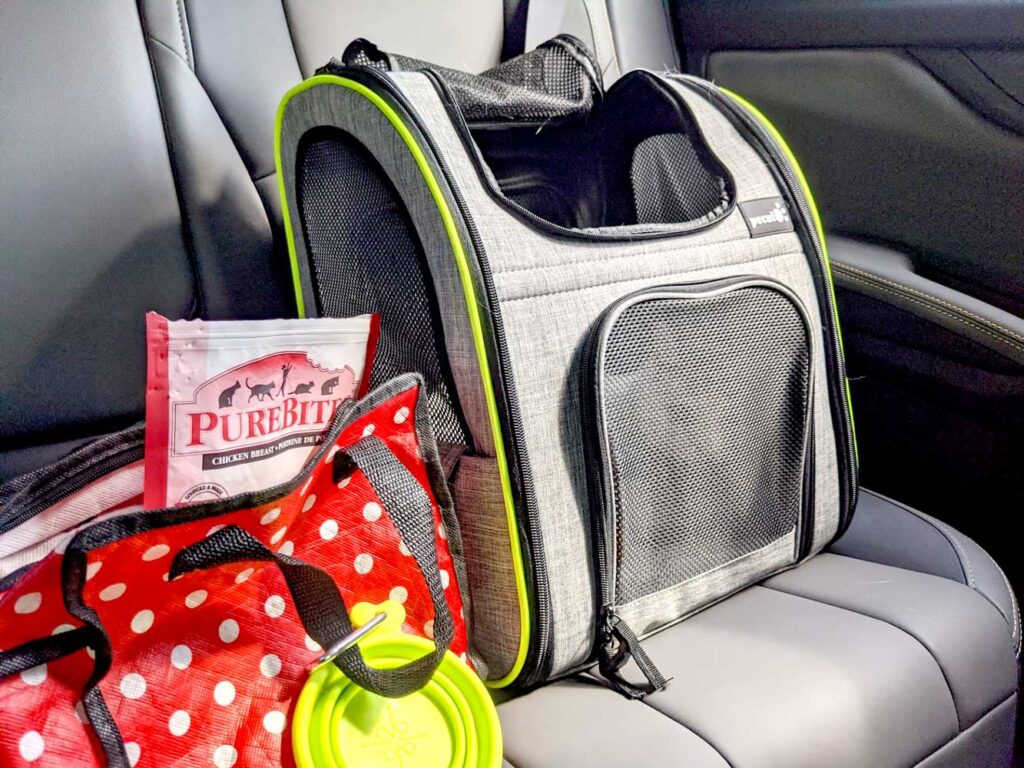
11. How To Travel With A Cat: Don’t Just Ignore Them For 8+ Hours!
This may sound obvious but depending on your cat, they may just sleep in the car the whole time, so they can be easy to forget about.
I noticed that towards the end of the day, our cat did get lonely. He would start meowing and pace in the carrier.
Every stop even if I didn’t take him out, I would go around to give him some pets and offer him food and water. But he was often too distracted by what was happening outside to even care about me.
So, instead, while on the road I would open up the carrier when he was calm and just stick my hand in to pet him every once in a while. He really appreciated this to know that we were still there and give him a bit of human touch. Normally he doesn’t go this many hours without sitting on our lap.
This is also where sometimes I would take him out of the carrier to sit on my lap if he was really agitated. This is really about listening to your cat and their needs.

12. Don’t Go Too Long Without Stopping With A Cat In The Car
Even if your cat doesn’t get out of the car when you stop, or you noticed they still don’t drink water, it’s still important to take a break.
You don’t want to go too long in the car without stopping and giving them the option to get out.
I would plan to stop max every 3 hours but also listen to your cats needs. If they’re getting restless stop earlier for them. Give them water, food, and maybe even offer them the litter box.
My cat never wanted to go out in the end, he felt safest in the carrier in the car. So I did stop taking him out and offering him water by the end of the trip – I knew he didn’t want it. But I would still visit him in the backseat and give him some much deserved pets!
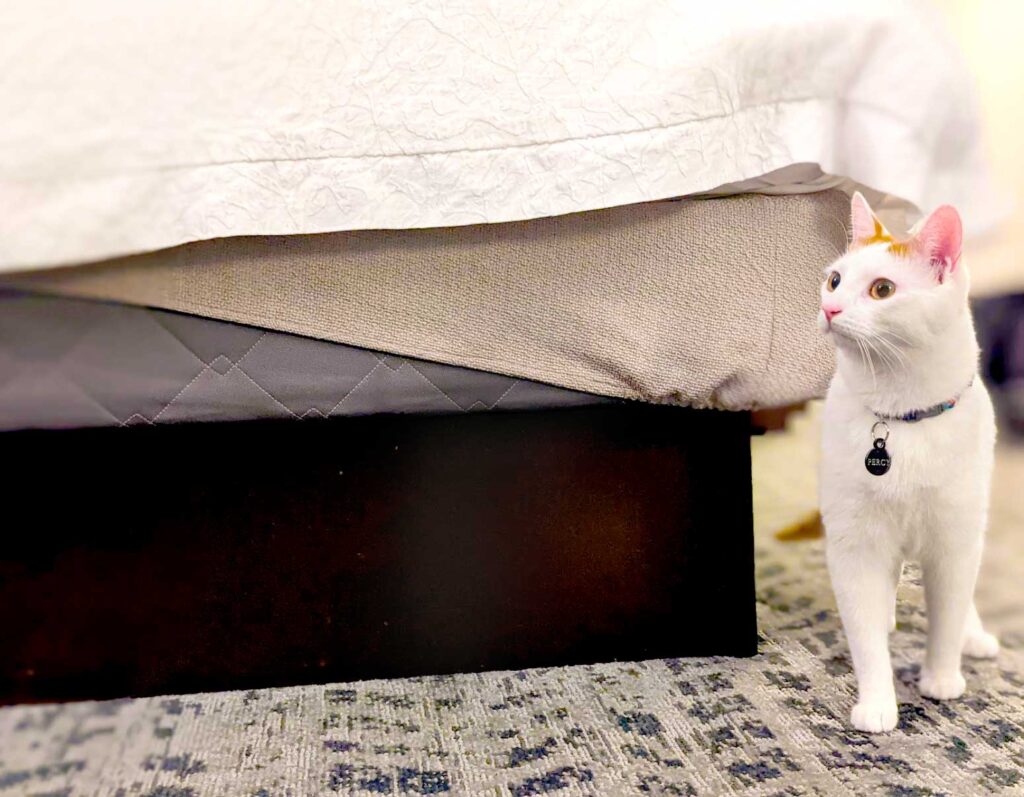
- 15 Important Cat Road Trips Tips For Staying In A Hotel With A Cat
13. Roadtrip With Cats: What Are The Best Places To Stop?
Depending on where you travel with your cat in the car, there may be road side rest stops. On route from Montreal to Florida rest stops right off the highway.
They had bathrooms and typically a large grassy area with picnic tables.
I found I could take my cat out to the grass on the leash and harness here (like this set on Amazon ). It’s a good spot to set up a bathroom break for your cat and offer water and food outside the car.
The only downside is that they may not have a gas station to fill up at. So you’ll still have to make another stop for that.
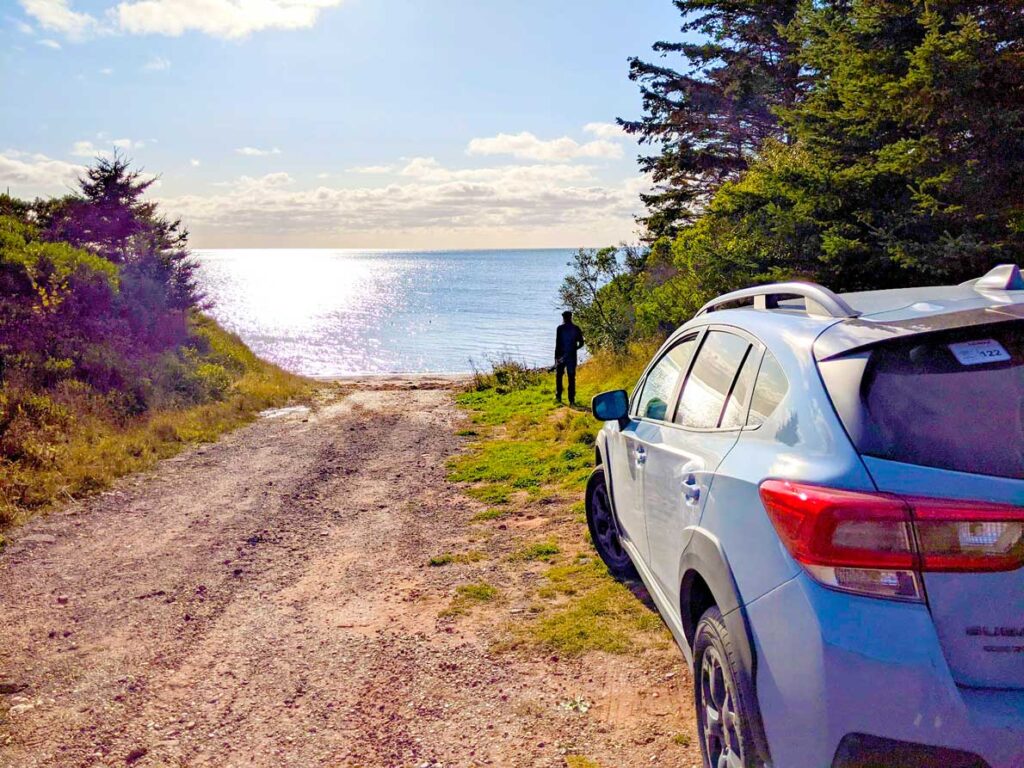
- Top 50 Long Distance Road Trip Tips For A Safe & Easy Drive
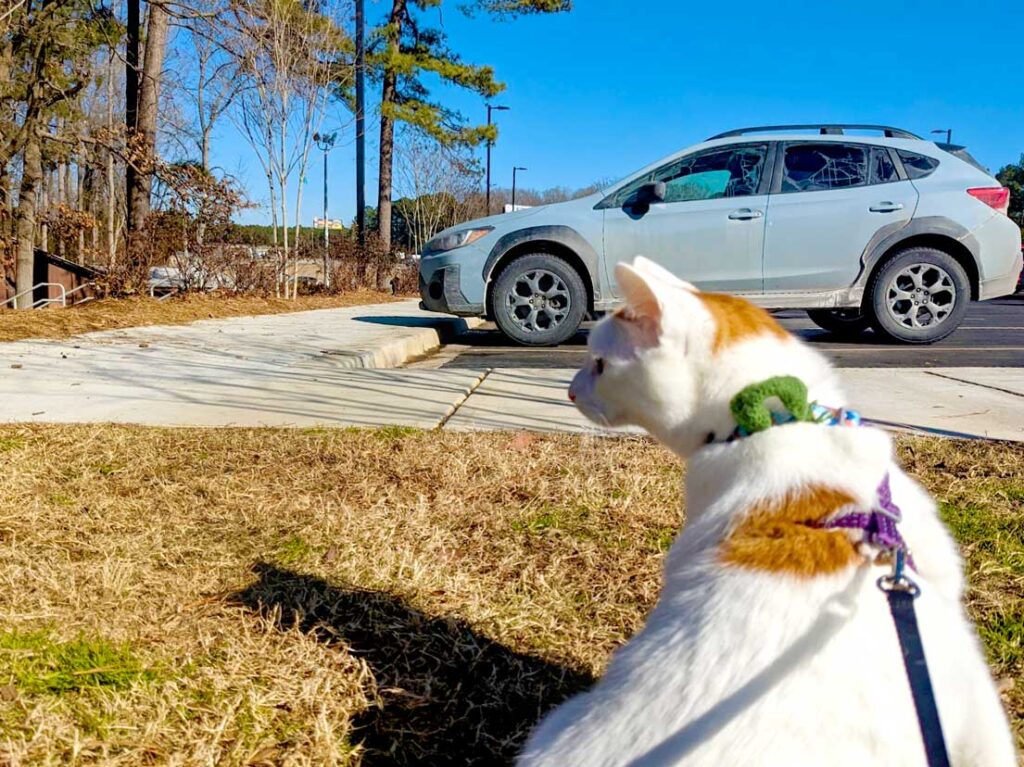
Quick Links – What You’ll Need To Travel With A Cat

Read More Related Posts
- What You Need To Travel With Your Cat In A Car Long Distances
Pin To Save Or Share This Post

Last update on 2024-04-09 / Affiliate links / Images from Amazon Product Advertising API
Pamela Schuman
Thursday 7th of September 2023
I am traveling from Washington to Indiana with four cats and I’m not sure how they’re going to do my one cat I drove from Indiana to Washington with when she was five weeks old that was it that was a breeze but she’s over a year now and the others are younger so I’m hoping my trip goes great. I’m thinking at least five days for overnights. What do you think?
Friday 22nd of September 2023
I hope your trip goes great too! It seems like you've planned a decent amount of time for the drive to allow for stops and shorter driving days if you need it. Take it one day at a time and see how your cats are doing, if you can try to take them in some short car rides before you head out on the big trip!
Good luck, happy cat travels :D
Saturday 19th of August 2023
Hello Meghan! 🐾
Enjoyed reading your helpful and practiced tips. I’m moving 1800 miles away at the end of Sept. Having tons of anxiety over driving or flying with my fur baby Templeton. 😻 He’s older and like most cats, doesn’t love car rides. 😾 Do you have any advice/articles on which is better - flying or driving? I’m sure it’s cat and owner dependent. The Vet said it’s going to be stressful either way, so get it over with quickly and fly with him. I go back and forth. I’ll need Valium! 😹
Oh no!! I'm sorry to hear that you're stressed about traveling with your fur baby but I totally get your stress.
I've actually never flown with my cat so I can't say from experience which is better. I would listen to your vet and get it over with if they don't like either!
Hope it goes well, best of luck!
Sunday 23rd of July 2023
Awesome article, great tips. I also read the article about hotels tips with cats. We're driving cross country with 2 cats and a new to them dog. These cats have never moved with us before. They will have each other to comfort each other. Lots of great tips and the links were very helpful!
Thursday 27th of July 2023
Thanks! Hope your cat and doggie travels go well!
Monday 3rd of July 2023
I'm contemplating a trip of approximately 1700 miles, traveling alone with my 2 cats. Really not sure I can do this. What is the most important thing you can advise me of.
Tuesday 4th of July 2023
It really all depends on your cats, my best advice is to get them used to the car as much as possible and start taking them with you any time you can before your trip! I would also say not to push it on the driving days as well. Start with shorter days and then if they're doing alright you can start adding time. Our cat was perfect for around 7 hours in the car and then by the 8 hour mark we noticed we would start getting antsy. So when we drove back home from Florida (about 1600 miles!) we made sure to never pass the 8 hour mark in the car.
Happy cat travels! Let me know if you have any other questions!
Monday 27th of February 2023
My Fuzzy beast, a 6 pound Ragdoll took to it as easily as my Alaskan Malamute x GSD, even sleeping in the back seat together, taking bathroom breaks in loose sandy soil. She approached new hotels with the same brief interest we all had, looked for the dog’s bed so she knew where she was sleeping that night if she wished … bugger all the dog. It wasn’t my magic touch though- I had a tuxedo who sat in the back window and moaned like he was going to vomit.
That's adorable! I like to think you still took some part in making it easy for your ragdoll to take to travel easier :D Just shows you how can really depend on the cat though sometimes! I hope it gets easier with your lil Tuxedo kitty!

- CAT BACKPACKS
- CAT HARNESSES
- ACCESSORIES
- TRAVEL TIPS & COMMUNITY
- BACKPACK & HARNESS TRAINING TIPS
- GET FEATURED
- PAWFILLIATE AMBASSADOR PROGRAM
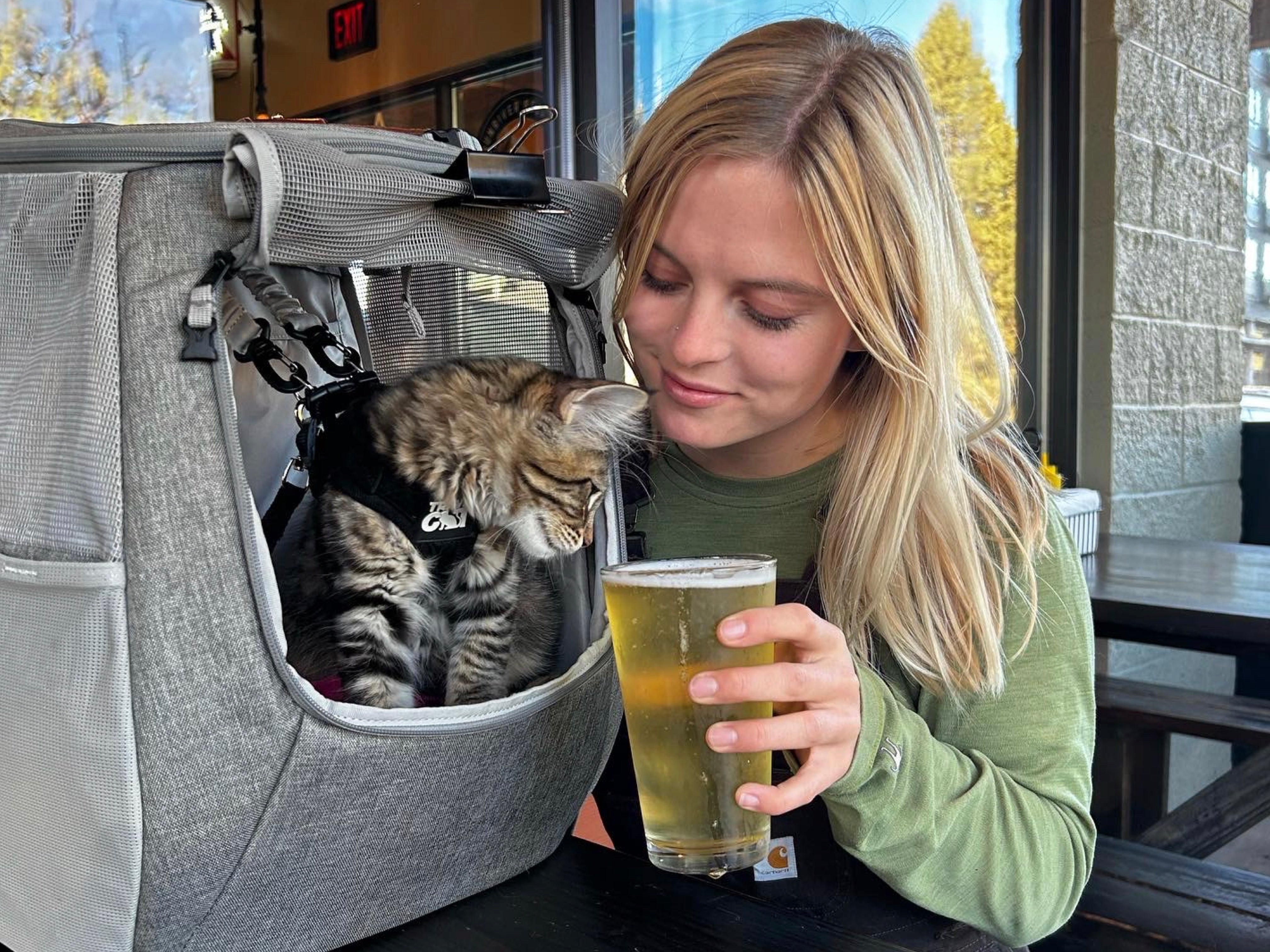
FUN PLACES TO TAKE YOUR CAT OUT
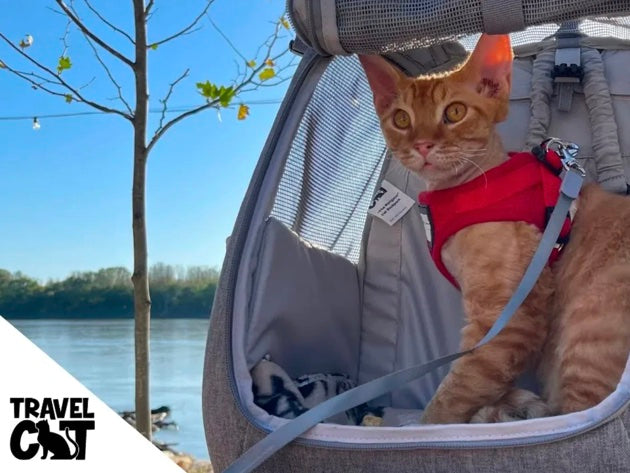
BACKPACK TRAINING ON-DEMAND
Your cart is empty
Article: Going on a Road Trip with Your Cat? Here's What You Should Know
Going on a Road Trip with Your Cat? Here's What You Should Know
Think it's impossible to take your fur baby with you on a road trip? Think again! Traveling with cats doesn't have to be stressful, and there are many ways you can prep in advance to make your road trip go smoothly.
While cats do like familiar surroundings and can have a hard time adjusting to too much change, there are things you can do before your road trip to make sure they are as comfortable as possible & you can have an enjoyable experience out on the road together. Traveling long distance with cats can seem intimidating at first, but this comprehensive guide to road-tripping with your cat has everything you need to know for your cat-venture, plus lots of cat car ride tips from fellow cat parents. Let's hit the road!
View this post on Instagram A post shared by Ash (@ashhh_the_cat)
Table of Contents:
Before the trip, packing the essentials.
Choosing the Right Cat Carrier
Features of a Good Cat Carrier
Where to Place the Cat Carrier in the Car
Train a Cat to Like the Carrier
Best Cat Carriers and Cat Backpacks for a Fun Road Trip with Your Cat
Litter Box, Scoop, and Litter Supply
Choosing the Best Litter Box
How will my cat use the litter box on a car ride?
The Best Portable Litter Box for Cats
Medical Documents
Cat Stress Medication & Anxiety Relief
Food & Treats
Feeding & Water Essentials
How do I travel with multiple cats or pets?
What not to do on your car trip.
What should I do if my cat gets carsick?
How do I entertain my cat during the trip?
View this post on Instagram A post shared by KittyMojito & Lynx (@kittymojito)
The best way to prepare for a long car ride with your cat is to help them get used to the car at least a few weeks before you plant to leave. Train them by letting them sit in the car for a little bit to get used to the smells & sounds, then begin taking small rides around the neighborhood, to your vet, or run errands together.
Make sure you have a cat carrier that they are comfortable in, and that is safe for traveling long distance with cats. Your cat carrier or cat backpack will work as a cat car seat, making sure that they have a cozy place to call home when you're out on the road. Now is a great time to also start leash training if your cat isn't already used to their leash. For some helpful tips on leash & harness training, see this article .
Visit a Veterinarian: Make sure your cat is up to date on all of their shots before your road trip, and get a general check up to make sure your kitty is good to go. Bring along any paperwork just in case of an emergency vet visit on the road.
Source a Cat-Friendly Hotel: If you're planning an overnight road trip, make sure that you are staying somewhere that will welcome your kitty. There are tons of cat-friendly hotel options to choose from, like La Quinta & Hilton 2 Suites .
Plan Pit Stops: Plan some stops along the way so your kitty can get out & stretch, use their portable litter box , or eat from "The Travel Buddy" Foldable Food Bowl & Mat.
Microchipping & ID Tags: It's always a good idea to microchip your pet, just in case of emergency. Always make sure your pet's ID tag has your contact information printed clearly on it, so they can be returned to you ASAP if they are to get lost.
Leash Training: Leash training & harness training your cat will make going on a road trip that much easier. Taking pit stops, walking into the hotel, or even having your kitty attached to their leash & harness while in the car will give you peace of mind.
View this post on Instagram A post shared by N E W T & E M U (@newttheadventurecat)
Tips from other cat parents:
"Harness Training! Good carriers that they are comfortable with. MICROCHIPS, and lots of patience!" @twintorties
"Practice before long rides. Build in stops to go to the litter box or eat. CBD oil is calming. Make sure you have a plan in case you need an emergency vet visit" @sherlock_thesiamesekitty
"We went for car rides before the big trip to get her used to being in the car for a long time." @massy_masc
"Start harness training young. Let them adjust to it. Don't force it. Patience!" @ubliani
"Don't be sad if the first time he's afraid. By the second time, your kitty will be good!" @mariuxitapia
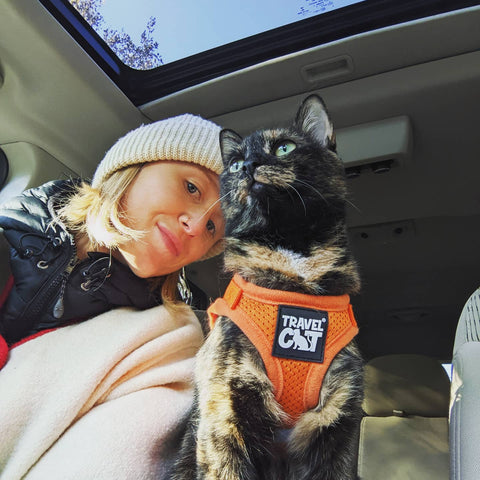
@camerousseau
Cat Carrier
Choosing the right cat carrier is vital to making sure your cat feels safe & secure on your road trip. Cat carriers give your cat a place to call their own while they are riding in the car, and while they're out and about on your adventures! Check out our many different cat backpacks here , all which are great for taking your cat in the car. We've got something for every Travel Cat!
Features of a Good Carrier -
- Strong - Obviously. You want your cat carrier to be made of high quality material! All of our carriers are made with top-of-the-line fabrics like oxford cotton & strong scratch-proof mesh.
- Well-ventilated - Your kitty needs a cat carrier that doesn't let them get too hot, and has plenty of airflow. All of our backpacks have multiple air holes or mesh paneling to make sure your cat gets all the fresh air they need!
- Size - Kitties are cute, in every size! Find the carrier that works best for your furry friend. We have cat backpacks for small, medium, and bigger boned cats that can hold up to 25lbs of floof.
- Comfortable - If you aren't comfortable wearing your cat backpack, your kitty isn't going to feel comfortable either. All of our backpacks have adjustable straps and are super comfy for both kitty & hooman.
"Take them on short walks in the bag and set them in the vehicle daily for 10-20 min. Maybe even drive around for a few min so they know what to expect during a car ride. Reward them with treats!" @ chernobylcat_n_mimo
Where to place the cat carrier in the car -
Cat carrier backpacks and cat car seats should be placed on a secure surface where they won't slide, like the floor between the passenger's feet, or seat of your car. Never put your cat carrier in the trunk of your car, as there is not enough ventilation for safe airflow for your cat. Keep their carrier secure by fastening with a seatbelt, or placing between things to keep it in place. Avoid putting your cat carrier in front of a direct air conditioning/heating unit so your kitty doesn't get have to brave the elements! Make sure to bring your cat's favorite blankets for an extra cozy ride.
"Make the Backpack the safe space. they will always have somewhere to return to." @jules.adventure.cat
View this post on Instagram A post shared by Lyra the Bengal Cat (@lyra_thebengalcat)
Train your cat to like the carrier -
Making sure your cat feels at home in their secured cat carrier is important before you go on any road trips together. Practice by keeping the cat carrier out & accessible to them at home, so they can hop in and out whenever they want. Then practice by taking them outside, then on short walks, then longer walks. For more in-depth advice, check out this article .
"Bimini falls asleep in his fat cat backpack, and enjoys some of the trip looking out his space bubble" @bimini.the.ragdoll
Best cat carriers and cat backpacks for a fun car trip with your cat:
- "The Fat Cat" Cat Backpack for Larger Cats is a great backpack for a kitty who might need a little extra room, or if you're bringing more than one cat along for the ride!
- "The Navigator" Cat Backpack for Adventure Cats is perfect for long car rides, because it has extra mesh paneling for optimal air flow, and it also converts into a normal carrier that lies on it's side, so your kitty can have extra space to stretch out in the back seat.
- "The Jackson Galaxy" Convertible Cat Backpack is great for car trips because it also converts to a carrier that lays horizontally.
"Transferred to his backpack when we made a stop and he did so well! No fights, no fits, so dreamy." @stephanielshulte
View this post on Instagram A post shared by Cali & Opie (@catventuresofcaliopie)
Travel Litter Box, Scoop & Litter Supply
Bringing a travel litter box along on a road trip is a must. Your cat needs a place to go, and you definitely don't want that place to be your back seat. Bring "The Porta Pawty" Travel Litter Box and use your cat's normal litter to keep their mess contained. This litter box zips up to keep mess from shifting around, and is seamless for an easy clean at the end of a long day on the road. Get your cat used to their portable litter box by starting to use it in your house, a few days before you set off on your trip. Put it in place of their normal litter box, using their normal litter to ease the transition.
"The Porta Pawty" Travel Litter Box

How will my cat use the travel litter box on a car ride?
Your cat might feel comfortable doing their business on the go, and if so, they could be let out of their carrier to go in their travel litter box if you pull over. But if your kitty prefers to go outside of the car, you might need to make a longer pit stop to set up their space. Since kitties like to eat & use the pawty shortly after, we recommend pulling over to do both safely & more conveniently. Thankfully, "The Porta Pawty" is super portable & easy to store away until you need it. Just unroll it, let your cat do their business, and zip back up to contain any mess once your kitty is done.
Best Portable Litter Boxes for Cats:
"The Porta Pawty" Travel Litter Box is what we recommend. See more of its features, here .
Portable Travel Cat Beds
If you're planning an overnight trip, having a place for your kitty to sleep is a must, especially if you're going to an unfamiliar environment. Your cat will want a place to call their home and get away for a snooze sesh every now and then.
Don't forget to pack their favorite blankets, and "The Meowbile Home" Convertible Cat Bed & Cave is just that - a scent soaker bed that will help your kitty feel more at home, wherever you go. A scent soaker is something with your kitties scent or your scent on it and will help calm cats for travel because they'll be in a familiar-smelling place. "The Meowbile Home" is super lightweight and easy to transport in its drawstring bag.
"The Meowbile Home" Convertible Cat Bed & Cave
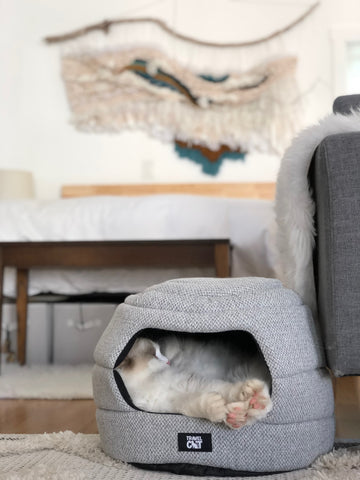
If your kitty needs some extra space to move around, try out "The Donut" Cat Bed & Cave . This bed is easy to transport and fits right on your car seat or in the back with the seats down, for a fun alternative to your cat backpack carrier. "The Donut" is not only a great place for a kitty snooze sesh, but it will also give your cat another way to play & entertain themselves on the road.
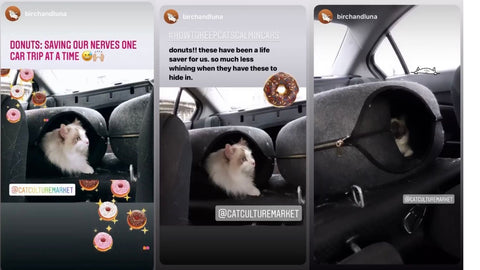
"Donuts!! These have been a life saver for us, so much less whining when they have these to hide in." - @birchandluna
Medication & Anxiety Relief
It is important to bring along any medical documents that your cat might need on your road trip, like vaccination certificates, etc. just in case of an emergency. If they are on any medication, make sure to have those documents & the appropriate dosage to last the entirety of the road trip (plus extra).
Prepare for your cat to feel some stress during the road trip, and if your cat is extremely prone to anxiety attacks, consider leaving them with a trusting friend or family member while you're gone. We do not recommend cat sedative for travel, but there are plenty of anxiety relief medications and solutions that would offer a safe alternative. Be sure to ask your vet what they would recommend you bring if your cat needs a little extra help calming down. We love Jackson Galaxy's "Easy Traveler" All-Natural Holistic Solution.
Food & treats are also a great way to calm nerves, and entice an otherwise skeptical kitty. Try using their favorite treats while training them to ride in the car as well, rewarding after they get in the car and at the end of the drive.
View this post on Instagram A post shared by Zedd the Plant Cat (@plantcat_)
A hungry kitty is not a happy kitty, and you don't want to drive with an unhappy kitty. Continue using your cat's normal food & eating schedule while on your road trip, in order to keep things as familiar to them as possible. Store your cat's food in ziplock food bags to make sure it stays fresh, & mess free.
Keep your cat hydrated throughout the duration of the road trip with portable water bowls, especially if you're traveling somewhere on the hotter side. Make sure to bring more than enough food for the duration of your trip, along with plenty of treats! Check out our cat travel accessories & food/water bowls , made to help your travels go a little smoother. Whether your cat likes dry or wet food, this silicone travel bowl is super easy to clean and store away when you're not using it.
"The Travel Buddy" Foldable All-In-One Double Bowl & Mat
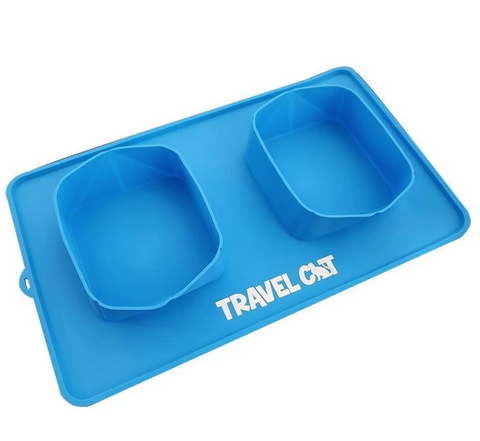
"The Go Anywhere Bowl" Collapsible Travel Pet Food and Water Dish
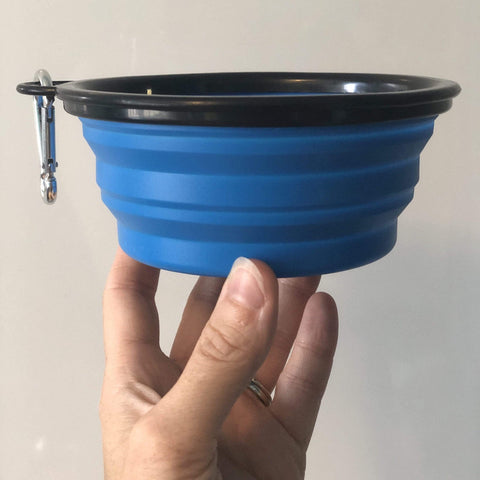
While your cat might enjoy peeking out the window for a bit, it won't entertain them for hours on end. Bring along your cat's favorite kickers, teaser wands, and other toys that will help them feel at home & entertain them while on the road. Check out these super fun & portable toys:
"The Rainbow Dancer" Cat Teaser Toy Wand

Traveling with Multiple Cats or Pets
The more floof the better! Going on a road trip with more than one furry friend might pose different challenges, but none that any cat-loving parent can't weather. Just make sure to have plenty of food, a carrier big enough for them or multiple carriers , and follow your cat parent instinct. Remember to take plenty of stretch/food/bathroom breaks, and bring treats galore. Having multiple cats come along might mean your cats can help entertain themselves, so the ride might be a little extra fun. Even if that means less - quiet 😹
If you're traveling with different types of pets, make sure your cats are well-adjusted or have time to meet & greet their road trip companions. If you're going on the road trip with some pet parents, try planning a little play date for your kitties and pets to meet before the big day.
"If traveling with dogs AND cats, put the cats in the vehicle first and let them be used to the environment prior to letting the dogs in." @chernobylcat_n_mimo
View this post on Instagram A post shared by Penelope and Juniper (@penelopelovesjuniper)
What not to do on your road trip:
Never leave your cat alone in the car. This is especially important on extremely hot or cold days. If you are traveling and want to explore a bit on your own or go out to eat, we suggest finding a cat friendly hotel to stay at for the night, or pet sitter in the area! If you need to go to the bathroom, either bring your cat with you in their cat backpack, or if you're riding with a friend, have them sit in the car with your cat.
Try not to let your cat out of their carrier. They might want some freedom & space to move around, which is why it's important to find a cat carrier that they are comfortable in. It is not safe to keep your cat out of their carrier while you are driving, in case of an emergency. They might protest at first, but try & build in plenty of walk breaks so they can stretch their legs, eat & use the bathroom, and give them lots of treats.
Don't leave the windows open too far, and always make sure they are locked. Having a cracked window might help keep your kitten calm, but there should never be enough space for them to escape. Always keep your windows locked, even if they are cracked a bit, so that curious paws don't lower them.
"Windows cracked (and *locked*) help keep kitties calm. Plus breaks for walks!" @birchandluna
Whether or not your kitty is an experienced car traveler, accidents happen. If they end up getting carsick, keep calm & give lots of comfort, clean them up, and try to clean their carrier as best you can. In order to make clean up easier, pack wipes just in case, and line your car & their carrier with towels or pee pads that you can easily remove. Unless your kitty is seriously ill, carry on with your road trip & don't let it ruin those awesome adventure vibes.
How do I entertain my cat during the road trip?
A bored kitty is a loud kitty 😹 Bring their favorite toys, treats, and make sure to take plenty of rest stops so they can eat, stretch their legs, & be stimulated by the scenery along your drive! If your kitty likes looking out the window, position their bag so they can peer out & check on their whereabouts while you're on the road. Depending on how long your trip is, they will probably sleep a lot too!
View this post on Instagram A post shared by Vincent_Dante_TheMaineCoons (@vincent_dante_themainecoons)
When You Arrive at the Destination
Yay! You did it.
Reward your kitty with lots of treats & kisses, and give yourself a pat on the back for a road trip well done! And maybe take a nap 😽 💤
We hope you enjoyed these tips & experiences from our community 😽
Disclaimer: You know your cat best. Please use caution & travel with your kitty's safety as top priority!
Leave a comment
This site is protected by reCAPTCHA and the Google Privacy Policy and Terms of Service apply.
All comments are moderated before being published.
SHOP CUSTOMER FAVORITES
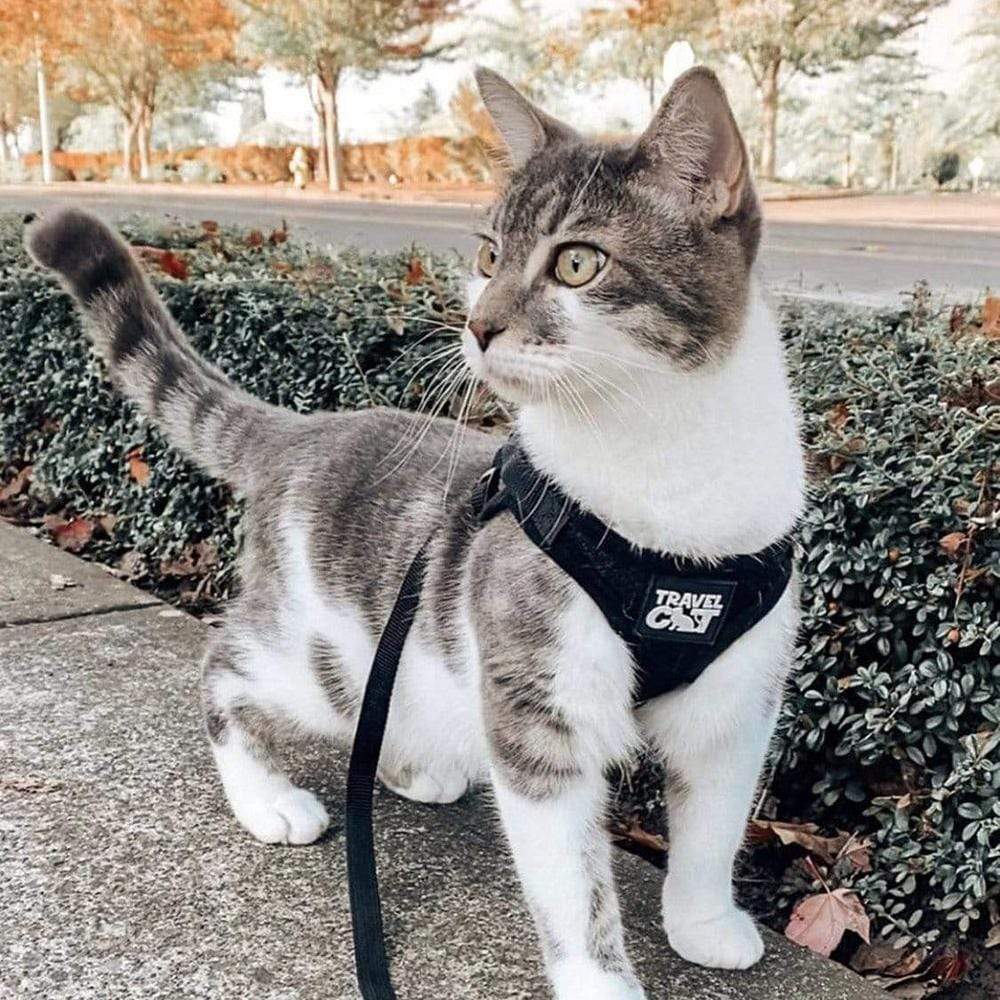
MORE CAT TRAVEL RESOURCES & FUN

TIPS for Harness and Backpack TRAINING CATS at the Travel Cat Summit
Shop the best gear & get more cat backpack and harness training resources: https://travelcatshop.com/ In this video from our Travel Cat Summit, we discuss tips for training your cat to travel...

How to Harness Train a Cat at the Travel Cat Summit
Shop the best gear & get more cat backpack and harness training resources: https://travelcatshop.com/ In this LIVE cat harness training session, we talk about how to harness train a cat. This...

Train Your Cat to be a TRAILBLAZER | TIPS on Hiking and Water Sports at the Travel Cat Summit
Shop the best gear & get more cat backpack and harness training resources: https://travelcatshop.com/ Hiking with your cat can be an enriching experience (when done properly). In this session...

Mastering Cat Comfort: Essential Tips for Long Car Rides
Note: We may earn a commission from helpful, relevant links in our content. No cost to you . See our privacy policy .
Embarking on a road trip with your feline friend?
Congratulations on choosing to experience scenic routes and thrilling landscapes from the comfort of your car. It’s a fantastic way to bond and make memories.
However, it’s not without its set of challenges. The constant motion, confined space, and unfamiliar surroundings can be stressful for your furry companion. It’s like having a toddler on board, only furrier and with sharp claws. I get it. I’ve been there, too.
But I’ve got you covered. In this guide, we’re going to share tips, secrets, and strategies to make your long car ride with your cat as smooth as possible. Whether you’re on the road for 12 hours or simply going for a long drive, these tips will come in handy. Buckle up, and let’s get started!
How to Prepare Your Cat for a Long Car Ride?
Preparing your cat for a long car ride is a lot like prepping a human – you need to address their comfort, safety, and needs, and sprinkle in a little entertainment.
Begin with Carrier Introduction . Start early by helping your cat get used to their carrier. Leave it open in their favorite spot, toss in some comfy bedding, and add their favorite toys. Let them explore it at their own pace. This helps to create positive associations with the carrier.
A Trial Run Can Help . Before you embark on a long journey, consider a few shorter trips to help your cat acclimate to the car ride experience. Start with a quick drive around the block.
Visit the Vet . Ensure your cat’s vaccinations are up to date, and that they comply with legal requirements (more about this in our cat travel vaccination guide ). In addition, if your kitty gets carsick, your vet can prescribe medication to help with motion sickness.
Get a Pet-Friendly Map . If you’re planning a long trip, there might be places you’ll stop for a break that may not be pet-friendly. To avoid any hassle, consider getting a pet-friendly map, an underrated tool that outlines pet-friendly restaurants, parks, and hotels along your route. Websites like PetsWelcome can help you here.
Pack a Comfort Kit . Pack a small kit with your cat’s favorite blanket, toys, and a piece of clothing with your scent on it. The familiarity of these items can help soothe your cat and make them feel safe in the unfamiliar car environment.
Remember, a little preparation can go a long way in ensuring a stress-free journey for both you and your cat.
Essential Items for a Cat’s Car Journey
Packing the right items can make a world of difference for your cat’s comfort and safety during the journey. Here’s a handy list of items you shouldn’t leave without:
- The Carrier . Your cat’s home-away-from-home, the carrier, is the most critical piece of equipment. Make sure it’s well-ventilated and securely fastened in the car. The Petmate Two Door Top Load carrier is a top choice due to its sturdy build, ample ventilation, and secure latch system. It’s like a traveling home for your cat.
- Water and Snacks . Always carry fresh water and their favorite snacks. Dehydration is a common issue during long trips, so frequent water breaks are essential. The Lixit Top Fill Water Bottles are excellent for providing fresh water throughout the trip.
- Litter Box . A portable, easy-to-clean litter box is a must. Look for one that’s leak-proof and easy to pack away when not in use. Consider the PetSafe Disposable Cat Litter Box , which is compact, leak-proof, and easy to clean.
- First Aid Kit . This should include basic first aid items and any medication your cat takes regularly. Don’t forget the motion sickness meds if your kitty gets queasy on the road. The AKC Pet First Aid Kit includes most basic first aid items, including antiseptic wipes, gauze, and a pet safety guide.
- Comfort Items . Your cat’s favorite blanket or toy can provide a sense of familiarity and security in an otherwise unfamiliar environment.
- Identification . An updated ID tag and a microchip are crucial in the rare event that your cat somehow escapes from the car or carrier. The GoTags Personalized Cat Collars allow you to engrave your contact info directly onto the collar.

How to Handle Pit Stops with Your Cat?
You might think pit stops are nothing special, but if you don’t pay attention, your precious furball might easily get into a dangerous situation.
First, keep the carrier secure even during breaks as sudden freedom can cause them to bolt or hide in unfamiliar places.
Whenever you exit the vehicle, ensure windows are securely shut, and doors are closed to prevent accidental escape. Use these breaks to offer water and a chance to use the litter box inside the car.
Do not let them roam outside unless they are leash-trained and even then, only in safe, quiet areas.
What About Night Travels, Any Tips?
Night travels can be a game-changer, especially for cats who are nocturnal by nature.
Here’s a tip you might not have heard before: use a nightlight in the carrier . It provides just enough illumination for your cat to see without being as disturbing as the car’s interior light.
One night, during our trip across the state, I noticed my cat, Smokey, growing increasingly anxious as the darkness fell. The usual soothing words didn’t work. Then it struck me: back home, he never had to deal with absolute darkness; we always had a little nightlight on. I quickly plugged a small, battery-powered nightlight into the car’s USB port, and put it near his carrier. The change was immediate. Smokey settled down and seemed to draw comfort from the soft glow. It was a simple solution, but it made our night journey significantly more peaceful.

Key Tips for Comfort and Safety on the Road
Once you’ve packed your cat’s essentials, here are some pointers to ensure your cat is comfortable and safe during the journey:
Drive Smoothly . Cats are sensitive to motion, so avoid sudden starts, stops, or sharp turns whenever possible. Smooth, consistent driving can help ease your cat’s nervousness.
Secure the Carrier . Make sure the carrier is fastened securely. It shouldn’t slide or move around when you’re driving. Place it in a spot where your cat can see you, as your presence can have a calming effect.
Keep Temperatures in Check . The temperature inside your car should ideally be kept between 70-75°F (21-24°C), a comfortable range for most cats. Overheating can be harmful to cats or any other pet, so use the air conditioner if needed, and avoid parking in direct sunlight. Temperatures get high really fast if you leave your car in the sun.
Related : Do cats like Hot or Cold weather?
Stick to the Schedule . Maintain your cat’s routine as much as possible, including feeding and litter box times. This will help them stay relaxed and reduce stress.
Noise Control . Keep the noise level down. Loud music or road noise can stress your cat . If they seem agitated, consider playing soft, soothing music to help calm them down. There are many sounds you can play to calm your cat.
Unique Tip – Talk to Your Cat . Yes, you read that right. Cats find comfort in familiar sounds, and your voice is one of them. Talk to them during the ride, reassure them, and let them know they are safe. If you find that boring, talk to someone else or just sing to yourself.
Remember, the journey is just as important as the destination, especially when it comes to the well-being of your feline travel companion.
Can I feed my cat during the car ride?
While feeding your cat during the car ride, ensure it’s done in small portions to prevent nausea. It’s advisable to stick to their regular diet to avoid any digestive upsets.
What if my cat doesn’t like being in a carrier for so long?
If your cat doesn’t enjoy being in a carrier, consider conditioning them with short trips before your long journey. Also, make the carrier comfortable with familiar scents, toys or blankets.
How often should I stop for breaks on a long car journey?
For a 12-hour car journey, ideally, you should take breaks every 2-3 hours. This would provide your cat with opportunities to drink water and use the litter box.

What should I do if my cat gets carsick?
If your cat gets carsick, consult with your vet before the journey. They can recommend motion sickness medications suitable for cats. During the ride, keep the car well-ventilated and maintain a smooth driving style to reduce nausea.
Alex, a passionate animal lover, has experience in training and understanding animal behavior. As a proud pet parent to two dogs and three cats, he founded AnimalReport.net to share insights from animal experts and expand his knowledge of the animal kingdom.

Leave a Comment Cancel reply
Save my name, email, and website in this browser for the next time I comment.

Road Trip With a Cat | 11 Tips for Car Travelling With Your Furry Feline
By: Author Amanda OBrien
Posted on Last updated: February 17, 2024
When embarking on a trip of a lifetime, why leave your cat alone when you can bring your precious cargo along for a road trip with a cat? Whether travelling for an hour or two or looking forward to the ultimate journey from San Francisco to Los Angeles , road trips are the epitome of freedom.
Unsure how to take a road trip with a cat in style, comfort, and with few hiccups? From a road trip packing list to a cheat sheet of cat-in-car problems and solutions, this guide will ensure a less bumpy ride for you and your fur baby.

Image by Ivan Rudoy on Unsplash
11 Tips for a Stress-Free Road Trip with a Cat
While you’ll be tempted simply set sail on your trip through winding roads, a game plan is essential to ensure no hitch in your wagon. Take a look at these key components to consider before going on your mobile adventure with your feline.
1. Determine the Duration

Image by Ali Kazal on Unsplash
From planning bathroom breaks to packing enough food (pet and others) for your drive, the duration of your trip is important to note for a variety of reasons. When travelling long distances, it’s important to stop every few hours in case your kitty prefers eating, drinking, and going to the bathroom while the car isn’t moving.
2. Talk to Your Vet About Health Conditions
By discussing your pet’s health history and illnesses, you’ll be able to go into your trip with all the necessary information to help your cat travel comfortably and safely. Going to the vet is often seen as a new and scary venture for a cat (much like the uncharted territory of a road trip), their behaviour could be quite telling.
Are they skittish by sudden movements? Do they get anxious about new experiences? There are a number of factors that could lead to vital pet medication that need to be packed for your getaway:
- Cat sedative or anxiety medication – Cats have a number of ways to indicate anxiety, such as a shaking tail. If your cat is known for troubling anxious behaviour, talk to your veterinarian about anxiety medication options to keep your kitty feeling relaxed.
- Necessary medication – If your cat has any medical conditions (such as seizures or diabetes), it’s important to pack enough medication for your trip. This is why calculating the duration of your journey is essential to confirm you have enough pills and potions to keep your kitty healthy.
3. Do a Few Test Drives

Image by Ankhesenamun on Unsplash
Much like a long-distance marathon, practice makes perfect when trying to get your cat comfortable with car rides. Make sure you take time to get your pet comfortable with riding along roads, so it’s not the first time they take a drive in your metal steering steed.
By taking your cat along on short errands and small drives and presenting them with a tasty nibble after, you’ll be able to create a positive association with the carrier and car. In time, your kitty will become a curled croissant and see a car trip as the perfect nap time getaway.
If you notice your cat is restless, panting, and frequently vocalising, this could indicate that your kitty is just not a fan of travelling by car. This is where you can make arrangements with your veterinarian for feline stress relievers.
4. Ensure Safety Precautions

Image by Cintya Marisa on Unsplash
Before going on your road-worthy adventure, a tough choice is to decide whether you’re planning to have your cat roam free or in his carrier. However, it is important to note that a free-roaming cat can be very dangerous when travelling long distances.
From distracting the driver to escaping when car windows are opened, free roaming is often only recommended if your cat is well behaved or you have a traveller sitting with them. A cat carrier can be considered the safest option, but can be an anxiety-inducing experience if your pet does not enjoy confined spaces.
You have a few options if your cat gives the small space of a carrier two paws down. First, you can slowly but surely help your cat become accustomed to his little room. The power of cat treats and cat toys placed in the carrier will soon transform a perceived prison into a pampering palace.
If this does not work, you can always opt for a more open seating concept to allow your cat to feel less constricted. This includes cat booster seats and harnesses to ensure your pet feels part of the conversation and is still nestled in a sense of safety.
5. Book Pet-Friendly Accommodation

Image by Elisa Schmidt on Unsplash
When riding on the road for 2-3 days with your long-tailed pet, booking accommodation on your travels is a good idea to get a few hours of shut-eye. It’s important to ensure you’re driving with a decent amount of sleep to keep your head clear for your travels.
We suggest you check your accommodation website before booking your stay to choose a place that will make arrangements for your furry prince or princess on the premises.

6. Do Research on Vets on Route
There’s nothing worse than your furry loved one being in pain and not knowing how to identify the issue. From swallowing choking hazards to pesky bee stings when the car window is open, it’s always good to prepare for the worst on the road.
By identifying many vet clinics on your road trip route, you’ll have a game plan to follow when your cat is in distress.
7. Get a Cat Tag

Image by Aleksandr Nadyojin on Pexels
While on your road trip, you’ll be bound to stop for various reasons, including filling up on gas and bathroom breaks. Whether you choose to leave your cat in his carrier with someone or take him outside, there is a chance your furry travel companion can orchestrate an escape.
This is why putting a handy information tag on your cat is very important to ensure a speedy rescue mission can take place to retrieve them. Not only is it a nifty way to jazz up your cat’s look, but it lets people know this kitty has a loving home if found. A trusty tag on a cat c o llar should include the following necessary written data:
- Name – This might seem like an obvious one, but it’s a necessary piece of information to identify your clawed compadre quickly if they get lost.
- Your contact details – Whether a phone number or an email, your reachability can make or break your search efforts if someone finds your kitty.
- Address – This factor is more relevant on short road trip journeys, which will allow animal services to identify that this stray fluff ball does indeed have a home.
- Microchip – A real time saver when your pet is a frequent flight risk, microchipping your cat is essentially a digital cat tag. This device is a tiny computer chip inserted between their shoulder blades that will display a unique serial code with information to identify the tagged pet.
8. Make a packing plan
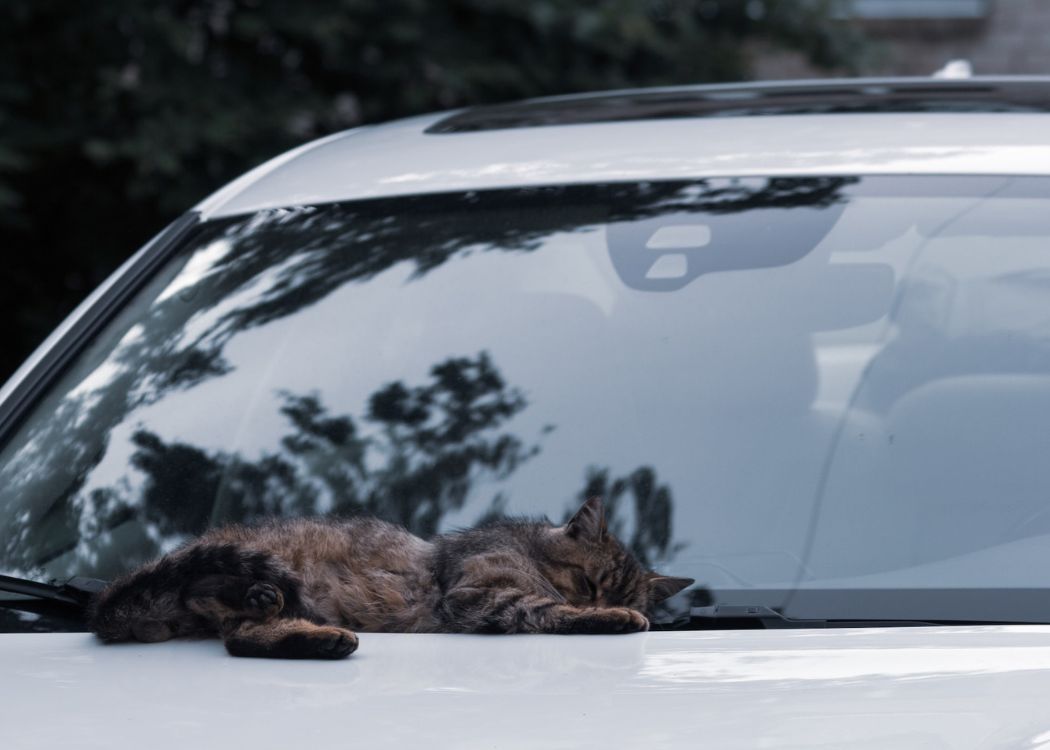
Image by Viktorija Stankevic on Unsplash
With the cat road trip preparations under the belt, the next step is a handy luggage list to make sure you remember everything you need for the journey. While you’re sure to be more than capable of stocking your suitcase, it’s up to you to include the necessary items and accessories for your cat.
- Carrier (with blankets and toys) – Your cat will likely have a tendency to roam the car interior, which makes a cat travel carrier so important. Not only is it a comfy place to sleep, but it also protects your pet from serious injury in a motor accident. Try to get them to sleep in their carrier a few nights before the trip to make sure they associate their carrier with a comforting memory.
- Blanket and toys – By sprinkling your cat carrier with remnants of the home, you’ll allow a sense of comfort and security for your pet to cling to in times of stress. Bring your cat’s favourite toy as a safety blanket (pun intended).
- Travel litter box – If you prefer your car to stay clear of cat excretions, a travel litter box is needed to allow your cat to go on bathroom breaks.
- Treats, food, water, bowls – Nothing causes fear in a cat owner quite like a hangry ball of claws and insistent meows. To keep your kitty hydrated and well fed, you’ll need to pack food and water to keep those stomach rumbles at bay.
- Pet wipes – Accidents tend to happen when on the road for an extended period of time. From vomit to a nervous bladder, you’ll be happy you’ve packed pet wipes to clean any unwanted spills and a dirty kitty.

Image by Maksym Tymchyk on Unsplash
9. What to do if your cat is feeling Too Hot
When travelling in hot and dry areas, your cat can experience elevated levels of heat, which can cause them to feel uncomfortable and uneasy. To prevent your kitty from overheating, you can place a pet cooling mat under them to ensure you have a cool cat on board.
Other solutions include placing a water bowl nearby to make sure your cat stays hydrated in the heat. If needed, you can also spray a small amount of water with a spray bottle on their fur for your cat to cool down faster.
How to Spot Overheating/ Dehydration
- Panting and breathing fast
- High heart rate
10. What to do if your cat is feeling Too Cold
Cars have a tendency to get chilly when the sun sets, so it’s essential to have some toasty tools handy to keep warm on your trip. Whether it’s blankets or a heating pad, your cat will be thankful for a bit of warmth when they have the shivers.
How to Spot a Cold Cat
- Cold body, nose, or tail
- Shallow and short breaths
- Stiff joints
11. What to do if your cat is feeling Car Sick

Image by Ana Elhardt on Unsplash
With sharp turns and sudden stops, it can be a motion overload for kitties not used to driving in the car.
As a precaution, you can take away your cat’s food bowl the night before your travels to enhance your chances of a vomit-free trip. But keep in mind that little to no food in their stomach will also increase the chances of your cat feeling nauseated.
If you know your cat has a motion sickness issue, you can ask a vet for a prescription to ease your kitty’s nausea symptoms.
How to Spot Nausea
- Excessive licking, chewing, or vocalisation
- Loss of appetite
Final Thoughts on a Mobile Trip With Your Purry Pet

Your luggage packed, the wind blowing in your hair, and look from your purring pal – by adding a bag of meows toe beans to the mix, you’re in for an adventure.
With a seemingly endless supply of pet essentials and a keen eye for noticing strange behaviour from your cat, you’re ready to hit the road with confidence. Unfortunately, you can’t prepare for every snag, but experiencing some of the world’s bucket list locations with your cat at your side will be well worth it.

Amanda created and owns The Discerning Cat. A lifelong cat lover she is the proud parent of two Siberian cats, Alexei and Vladimir. She is passionate about understanding cats and different cat breeds.
This site uses Akismet to reduce spam. Learn how your comment data is processed .
Hepper is reader-supported. When you buy via links on our site, we may earn an affiliate commission at no cost to you. Learn more .
Road Trip With Cats: 15 Expert Travel Tips
By Chris Dinesen Rogers
Updated on Mar 29, 2024
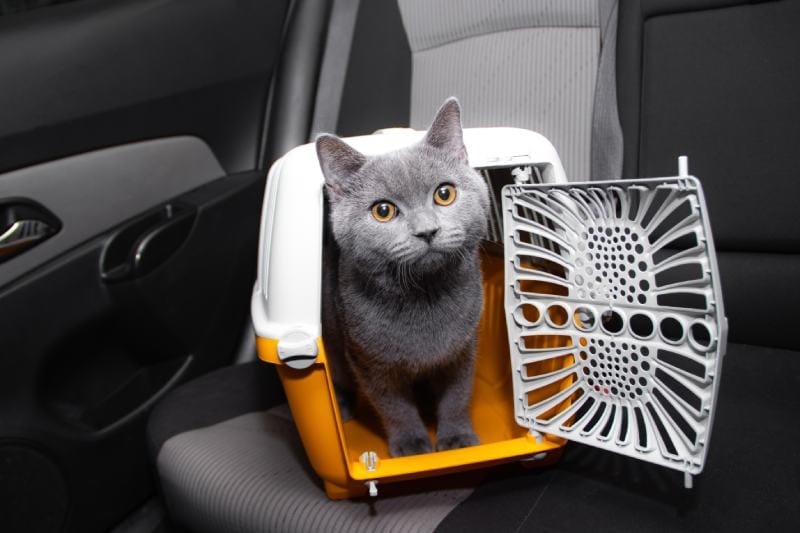
About 46.5 million American households have invited a cat into their lives. Many people don’t consider their pets as mere animals. Rather, they are members of the family. Therefore, it makes sense that some may want to travel with their kitties, whether it’s for a weekend jaunt or a snowbird’s move to a winter home.
Cats like things to stay the status quo. Traveling is out of their wheelhouse unless you take measures to make it less stressful for your pet. That means getting your cat used to the idea of leaving home and enjoying the experience.
The 15 Expert Tips For Road Trips With Cats
1. check into travel restrictions at your destination.
Do yourself a favor and find out if there are any travel restrictions where you’re headed. Most municipalities don’t regulate pets beyond licensing and similar requirements. However, you must also consider HOAs, resorts, and the odd city law that could disrupt your travel plans. If you plan on a multiple-day journey, check any rules that may pertain to your situation.
2. Buy the Right Carrier for the Trip
Erring on the side of caution and getting an overly large carrier isn’t a bad thing. It’ll give your cat more room to stretch out and move. Some carriers are appropriate for day trips. You’ll also find larger ones that can make longer journeys more comfortable. Mesh-sided products are optimal for air circulation and are lighter in weight.
3. Microchip Your Cat
If your cat isn’t microchipped, you should seriously consider getting it done. It gives your pet a permanent ID. While you don’t want to think about a worst-case scenario, a frightened animal can escape. The fact remains that about 36% of lost cats either die or are never recovered. Think of it as pet insurance. We hope you never need to use it, but it can give you peace of mind, nevertheless.
4. Purchase a Disposable Litter Box
You undoubtedly take pit stops when you need to do so. Your cat needs the same relief. Disposable litter boxes are an ideal choice if space is a consideration. You can even put them in your pet’s carrier if it’s big enough to accommodate the extra space. It’s one way to make your journey less stressful for your kitty by making them more comfortable on the road.
5. Feliway Is Your Friend
Products like Feliway replicate feline facial pheromones. When your pet rubs against you, they’re marking their territory. It can reduce stress because the animal associates the carrier as a safe place. Change and the unknown upset cats. A familiar smell can make your kitty relax and calm their fears of traveling to a new location.
6. Discuss Prescription Medications and Vomiting Prevention With Your Vet
Vets often view prescription medications as a last resort. It’s better to find other ways to calm your cat than drugs. They bring a host of other issues with potential interactions and varying tolerances. Nevertheless, you know your cat best. If the trip is liable to upset them unduly, it’s worth asking about drugs to keep them calm and prevent vomiting.
7. Consider Buying a ThunderShirt
Many pets experience noise sensitivity to loud sounds like thunder. Weighted blankets or shirts like the ThunderShirt may offer a calming effect for some animals. Research has shown positive results with dogs. It may have a similar response in cats. The blanket can replicate a box , which felines gravitate to when stressed.
8. Get Your Cat Used to Their Carrier
It’s unreasonable to put your cat in a carrier for the first time and expect them to accept it. Cats don’t like restraint. It takes away their control over an uncomfortable or frightening situation, exacerbating their stress. Therefore, it makes sense to let your at explore its temporary home on their terms at their pace. Let your pet explore the carrier and get used to it before you must use it.
9. Habituate Your Kitty to the Being in a Vehicle
The same advice applies to being in a vehicle. We take it for granted to travel by road. It’s a whole new experience for a pet. That’s why it’s imperative to get your cat used to the experience gradually with short trips . We recommend making it a positive experience. Treats work wonders to make even the scariest event seem less frightening.
10. Cover the Sides of the Carrier With a Sheet or Towel
One of the reasons cats gravitate to boxes is the security of walls around them with just the opening for them to view the outside. Draping a carrier with a sheet or towel can create the same effect. Ensure proper circulation exists to prevent other issues. You may find that your kitty will seem calmer and even snooze while you drive.
11. Put a Piece of Your Clothing in the Carrier When You Travel
Cats get emotionally attached to their owners. They constantly reinforce these bonds by rubbing up against their owners to remark them as their own. When traveling, you are the only thing your kitty recognizes. Therefore, it makes sense that your senses may have a calming effect on your pet. Make sure to pick something you won’t mind tossing out since a feline may urinate if stressed.
12. Bring a Copy of Your Vet Records With You
Murphy’s Law tells us the unexpected will happen at the worst time. That includes a situation with your cat. Vets will request pet records before treating an injury or illness. They need a complete health history to make the right decisions. However, if something happens when you can’t get them, it can cause a treatment delay. Make it a point to have the most up-to-date records with you before you travel.
13. Ensure Your Cat Is Up to Date on Their Vaccinations
Likewise, ensure your pet is up to date with any required vaccinations. The last thing you want is to pay a premium for these services at an emergency vet clinic if something happens. That’s especially true with your cat’s rabies vaccination. Some officials won’t accept a tag as proof of the vaccination.
14. Get a Certified Health Certificate From Your Vet
Some accommodations or places require certified proof of your pet’s status with a health certificate. Airlines often make it mandatory if air travel is a part of your journey. Bear in mind they have a limited validity period that varies. Check with your destination or carrier to find out the requirements to make sure it’ll work.
15. Book Pet-Friendly Accommodations
We strongly urge you to verify whether your accommodations are pet-friendly instead of leaving it to chance. You may incur additional fees if you fail to disclose the fact you’re traveling with a cat.
Traveling with a cat can be a rewarding experience for both of you. However, it takes some prep. You must give your cat time to get used to traveling and novel experiences. It helps immensely if you start a pet young instead of working with an older animal. The key is making it a positive experience to offset a feline’s natural fears of something new.
Related Read:
- What Vaccines Do Indoor Cats Need? Our Vet Answers
- Best Pet-Friendly Hotel Chains in the US
- https://www.americanpetproducts.org/press_industrytrends.asp
- https://lostpetresearch.com/2019/03/lost-pet-statistics/
- https://pets.webmd.com/features/pet-pheromone-products-for-behavior-problems#1
- https://www.sciencedirect.com/science/article/abs/pii/S1558787812001190
- https://www.sciencedirect.com/science/article/abs/pii/S0168159114002366?via%3Dihub
Featured Image Credit: alenka2194, Shutterstock
Related Articles
Further Reading
7 Best LED & Light-Up Cat Collars in 2024 – Reviews & Top Picks
Apr 3, 2024 - 7 min read
21 Cat Breeds That Like Water (With Pictures)
Feb 26, 2024 - 11 min read
What Kind of Cat Is Pete the Cat? Famous Cat Breeds Revealed
Jan 17, 2024 - 3 min read
Vet Articles
Latest Vet Answers
The latest veterinarians' answers to questions from our database
7 Neurological Issues in Dogs & Common Signs to Keep in Mind (Vet Approved)
Answered by Dr. Chantal Villeneuve, MS BVetMed (Vet)
Can Dogs Eat Barley? Our Vet Explains The Nutrition Facts
Answered by Dr. Luqman Javed, DVM (Vet)
Can Betta Fish and Goldfish Live Together? Fish Compatibility Explained By Our Vet
Dog Ear Hair Plucking: Our Vet Answers Concerns & Alternatives
Answered by Dr. Karyn Kanowski, BVSc MRCVS (Vet)
Betta Fish Gill Flukes: Causes, Signs, Treatment & Prevention
How to Help an Abused Dog Recover: 8 Tips & Tricks
Answered by Dr. Sharon Butzke, DVM (Vet)
Cat food recalls
Have a cat? Stay on top of cat food recalls here >
Dog food recalls
Have a dog? Stay on top of dog food recalls here >
Have a question? talk to a vet online for advice >


The 6 Best Cat Carriers for Long Car Trips
We take reviews seriously . This article has product links we may be compensated for as an affiliate, at no extra cost to you.
The Sleepypod Mobile Pet Bed & Carrier is the best cat carrier for long car trips because it’s secure yet comfortable, inspires calmness in my cat, and make me feel confident driving with it.

Sleepypod Mobile Pet Bed & Carrier
- Crash tested and certified by the Center for Pet Safety
- Dedicated seat belt loops
- Unique and tasteful look
- High end build quality
- Top entry for easy access
- Use as a cat bed, carrier, and cat seat
My cat is lukewarm to travel because she flew from her breeder to me as a kitten. So I know all about looking for the perfect carriers that will not stress out your cat.

But the best one for my cat may not be the best for you, which is why I selected other great models from other categories. Then at the end, a complete buyer’s guide.
There are the products we review in this article:

Sleepypod Mobile Pet Bed & Carrier
- Carrier Type: Soft sided carrier
- Why It Works for Cars: Crash tested + certified, seat belt attachment, airy and comfortable
- Nylon, Polyester construction

Sherpa Original Deluxe Pet Carrier
- Carrier Type: Soft sided
- Why It Works for Cars: Seat belt attachment, high visibility & ventilation
- Polyester, Mesh, Fleece, Synthetic Fabric construction
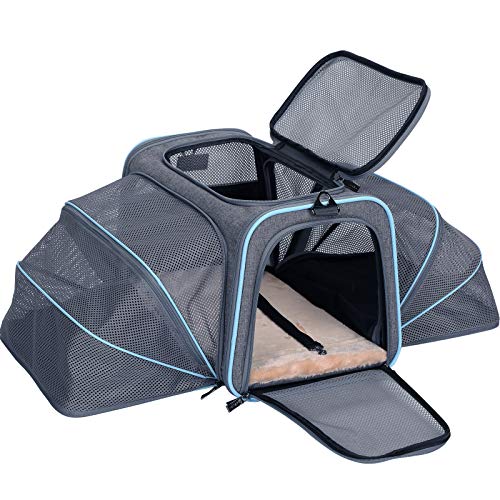
Petsfit 2 Sides Expandable Carrier
- Carrier Type: Soft sided
- Why It Works for Cars: Expands in back seat, zips up when transporting
- Polyester, Oxford cloth construction

SPORT PET Car Kennel
- Carrier Type: Soft sided carrier, Kennel
- Why It Works for Cars: Roomy, metal entry gates, headrest attachment
- Plastic, metal, fabric construction

One for Pets Portable 2-in-1 Double Pet Kennel/Shelter
- Carrier Type: Soft carrier, Kennel
- Why It Works for Cars: Roomy, seat belt attachment, flexible configuration
- Polyester construction

Petmate Two Door Top Load
- Carrier Type: Hard sided
- Why It Works for Cars: Extra secure, easy to clean, wire mesh door
- Plastic, Stainless Steel, Metal construction
The Best Cat Carrier for Long Car Trips (Soft)
Super popular cat carrier for long car trips (soft), also great carrier for long distance travel (soft), best cat carrier for car travel (backseat style), best cat carrier for two cats on long car trips, best cat carrier for long car trips (hard), best cat carrier for long car trips (runner up hard), looking for the best cat carrier for long distance car travel with a litter box, the petluv happy cat premium cat carrier – what do i think, what are the best cat carriers for car travel, how to travel long distances with cats in a car, road trip with your cat – choosing the best cat carrier for long car trips, how do i keep my cat calm when traveling, is there anything i can give my cat to keep her calm, frequently asked questions.
Our overall soft winner and best cat carrier for long car trips is this versatile model that checks every box and looks great too.
Cats develop aversions to carriers because they are carriers, only associated with vet visits and other unpleasantness. The Sleepypod functions as your cat’s regular bed, their carrier when it’s zipped up, and their car seat when secured to seatbelt loops.
But this flexibility is not the reason it’s the winner. So why is it the winner? In a word – safety.
This carrier is designed to provide optimum safety and comfort using crash test research! Few other carriers or companies do this. Sleepypod actually crash tests its carriers (static material tensile testing and dynamic crash testing) at NHTSA contracted facilities.
But beyond being a safe carrier, the Sleepypod features durable construction and an easy top-entry design. The outside is made from luggage-grade nylon, which makes it easy to clean and maintain.
With a removable, yet secure, mesh dome, your pet will feel cozy without losing ventilation. Zip the domed cover off at home to help your cat acclimate itself to the carrier before a long trip. This is one carrier/bed you leave out all year.
The inside features plush bedding. It’s removable and machine-washable, so you can provide your cat with a comfortable spot at home or on the go. It also features a water-repellant cover in case of travel accidents.
For car trips, the Sleepypod carrier can be secured to the seat using hook and loop points that pair with your car’s seat belt.
And once you get to the destination, simply grab the padded carry handle, and safely transport your cat out of the car to a secure environment.
Overall a fantastic and safest carrier on this list with one obvious negative – the price.
The Sleepypod is available in 6 fresh colors and mini and medium sizes.
Rating Breakdown:
- Car Safety 10/10
- Comfort 10/10
- Accessibility 10/10
- Style 10/10
- Overall Rating 9.2
What We Liked:
- Crash tested
- Dedicated seat belt attachments
- High quality materials inside and out
- 2 sizes to fit any sized cat
- Water-resistant liner
- Easy carrying handle and adjustable shoulder strap
What We Didn’t Like:
- Not suited for air travel

Sherpa Travel Original Deluxe Pet Carrier
- Stylish, comfortable, and practical cat "dufflebag"
- Secures to your car's seat belt, with locking zippers
- Big, well-ventilated mesh windows provide good visibility
Our runner up is this ultra stylish, comfortable, and practical cat dufflebag.
The Sherpa Travel Original Deluxe Pet Carrier meets airline requirements, and more importantly, can secure to your car’s seat belt. So it’s perfect for international flights or a long drive to the city.
This is a lightweight option that also keeps its structure. Its design has a spring wire frame that makes the body of the carrier pliable yet firm. And when holding the carrier, you don’t feel like its shape is going to collapse, even with cats the size of Maine Coons!
Your cat can enter from the side or simply be dropped in from top. For security, the zippers in those places lock. But, your cat is always close to you through the large, well-ventilated mesh windows that provide good visibility.
In addition to being ergonomic, this carrier is easy to move around with help from a non-slip carrying strap that rests nicely on the shoulder.
You can easily reach into the little storage pocket on the side to grab your cat documents or gear with one one hand.
Lastly, you can also pull out the interior faux-lambskin liner and pop it in the washing machine. It comes available in many tasteful colors and small, medium, and large sizes.
- Car Safety 7/10
- Overall Rating 9
- Top and side entry
- Lightweight
- Seat belt strap secures to seat
- Maintains its shape while being pliable
- Odors may linger in material
- For those unsure how much visibility and privacy your cat wants
- Has unique side pockets that can fold out and expand the space
- High-quality locking zippers with two shoulder straps for ergonomics
The Petsfit 2 Sides Expandable Carrier is a quality, feature-packed carrier that is best for cat parents unsure of how much visibility and privacy your cat wants.
As our third best cat carrier for long car trips, this soft model has unique side pockets that stick out like little mesh balconies, that allow you to customize the way you use this carrier.
When you’re walking to or from your cat with your cat, everything can stay zipped up and private. However, you can fold out the expanded mesh compartments once you are in the comfort of your vehicle and give your cat a taste of the road.
This carrier also earns points for its really firm and soft exterior made from Oxford cloth. The Oxford material actually gives this carrier a really preppy, sporty look that’s unique among pet carriers.
I also like the security of high-quality locking zippers, and that there are two handles shoulder strap for good ergonomics. It’s also got entrances on the top and front so entry is stress-free for Kitty.
- Customizable and expandable depending on circumstance
- Shoulder strap and handles
- Top and front entry
- Self-locking zippers
- No attachment for seat belt
- For cats fine with car rides and wanting real comfort
- Rectangle design create a travel tube across your entire backseat
- Has secure metal entry gates, but fabric inside is not clawproof
If your cat is fine with car rides and you want maximum comfort for them in the backseat, the SPORT PET Car Kennel is for you.
And it’s perfect for cars: using a unique rectangle tube design, this carrier easily secures to the rear seat to create a travel tube across the entire backseat area.
It attaches to the head rest and can be looped in with seatbelts for overall safety!
While this carrier system is made from secure, claw-proof fabric, it’s not meant to take abuse from difficult cats. Entry gates are metal, however and pretty much escape proof. The fabric is very well vented and cozy.
With the large size, this is also one of the best cat carrier for long distance travel with a litter box! Just add some blankets, a travel litter box , and your cat is set for a cross-country move (with ample breaks of course).
When the trip is over, the SPORT PET Car Kennel collapses accordion-style into a compact square for storage.
Note that you will need to use a separate carrier to transport Fluffy from your home to this kennel. This product’s bottom is quite soft and not load bearing, it’s only to be used in the car.
This kennel comes in a large 45-inch or smaller 31-inch carrier option .
- Accessibility 8/10
- Overall Rating 8.2
- Extra safe , attachment to the back seat headrests and seat belt
- Metal mesh entry gates
- Super roomy and lightweight
- Very breathable
- Folds easily for compact storage
- Can’t be used as a regular soft carrier to and from your car
- Let your cats recharge alone or have companionship on a long trip
- Complete transportation system with built-in seatbelt attachments
- Well ventilated and has multiple entrances
Personally, I consider it cruel to squeeze two cats (or more) into a single carrier on long road trips. Not only would space be an issue, it probably would cause mental distress because cats are not social animals all the time.
Luckily, we have options like this beautiful double-pet model, our best cat carrier for two cats on long car trips! This ensure that your cats can enjoy a little company on the road without feeling claustrophobic.
Unlike to the above PET SPORT Kennel, this is more than a carrier, it’s complete transportation system. You can transport your cats from your house to the car using the top handle. You then secure it via built-in straps to seatbelts and it’s ready to go.
Functionally, the One for Pets Portable 2-in-1 Double Pet Kennel/Shelter is well ventilated, offers multiple entrances, and includes washable mats. Your cats will be plenty comfortable and visible via the breathable mesh.
And during the trip, you can turn the two compartments into one large area for some cat social time by unzipping the central zipper. Let them be with each other for a bit, and if needed, you can zip it back up again for alone time.
After the trip, the kennel easily folds up into a carrying case. Or just leave it up and out, since many cats will prefer being in it, and it works as a spacious kitty condo as well!
- Car Safety 9/10
- Overall Rating 9. 2
- Secures to the length of your back seat
- Removable divider wall for social time and private time, 3 configurations
- Very lightweight for the size
- Makes a great cat condo
- Comes with removable pads
- Affordable hard sided carrier for cats who might bite and scratch
- Extra secure with a steel mesh entry door
- Sides and back ventilated but obscured for privacy
The Petmate Two Door Top Load carrier is the overall best cat carrier for long road trips in the hard category due to its easy to use nature, affordability, and security.
True to the top load in its name, you pop the top door and simply drop in your kitty if the front gate a no-go. That way you don’t force and push her in.
That door, by the way, squeezes open using a really ergonomic setup with the latch and handle. It’s also made of steel mesh to withstand scratches and bites.
This carrier is made of hard plastic, and you secure the top and bottom halves together with screws for extra durability.
I also like the way this carrier provides a nice mix of ventilation and coverage. If your cat likes privacy, they’ll dig the way the sides and back are covered. That means that your cat can look out the front “window” without feeling frazzled by exposure at all sides.
This crate-style carrier comes in 2 sizes and is sturdy enough cats up to 20 pounds, but can seem a little too snug if your cat is extra fluffy.
- Comfort 7/10
- Price 10/10
- Overall Rating 8.6
- Top loading
- Wire mesh door and secure hard plastic construction
- Made in the USA
- Fun and vibrant colors
- Easy to open, close and latch.
- For small to medium sized cats only
- Need to add blanket or mat for hard floor

Amazon Basics 2-Door Top Load Cat Carrier
- Affordable & popular hard carrier, inspired by the Petmate
- Extra safe with a metal entry, top and bottom secured with latches and/or screws
- Convenient top entry opens to left or right
This is a great hard carrier that provides a practical, affordable experience (if not a little familiar). The Amazon 2 Door Top Load is obviously inspired by the Petmate Top Load, and performs just like it.
This carrier has doors and latches that are super easy to open, close, and secure. You can even open the top one-handed. Which handed? Doesn’t matter because the top entry opens two ways!
The top handle feels secure vs other carriers.
This carrier is more vented than others hard carriers, with little windows in every direction. Another big bonus of this carrier is that the top and door is removed easily to leave you with a cute cat bed for use at your destination.
- Sturdy and build-quality
- Steel wire 2-way opening door
- Easy open latch
- Tons of ventilation
- Comfortable handle
The best cat carrier for long distance car travel with a litter box available on the market is the Necoichi Portable Stress Free Cat Carrier , it comes with a foldable pop-up litter box.

It is large and comfortable enough for cross country trips, with mesh sides to promote airflow, and has a waterproof liner in case of accidents! You can secure it to seatbelts for safety too.
The included litter box is a good size with high sides and works for normal sized cats. After use, it folds up small and snaps tight.
After you are done traveling, you have the option of folding it up and putting it away.
Add a Disposable Litter Box for Large Cats
For large cats, I recommend buying Kitty’s Wonderbox Disposable Litter Box .

They are bigger than the included pop-up litter boxes, and they’ll fit in roomy cat transportation tube like the Petego Pet Tube Kennel or One for Pets Portable 2-in-1 Double Pet Kennel/Shelter .
The PetLuv Happy Cat Premium Cat Carrier is an extremely popular soft collapsible carrier and it deserves its reputation!

We love this carrier because of the frame’s quality construction, flexible privacy features, and thoughtful elements like locking zippers and a thick shoulder strap for you.
Its four large windows offer three different privacy configurations. You can roll up the windows completely, leaving your cat open air.
Or leave the mesh screen down to let them see the environment. And if your cat’s excitable or in a place where privacy is required, roll down the flaps so the carrier is fully closed.
An included plush pillow inside carrier calms any cat, and you can even secure it to seat belt loops for car travel. After finished with the trip, fold the carrier and put it away!
All of my picks above can be the best cat carrier for car travel for your cat. I’m really partial to the Sherpa Travel Original Deluxe because of everything I wrote above.
Long car trips can be more challenging than short ones, so of course any of my best picks can work!

On the road, it’s wise to stop every two hours to give your cat a break. Take them outside on a leash , if they are trained to do so and let them stretch their legs!
A good journey with your cat begins even before the carrier. It starts with your mindfulness of your pet’s needs. It’s important to remember that a good cat carrier isn’t a substitute for proper cat-friendly traveling practices.
A car should also offer comfortable temperatures with opportunities for ventilation. Do use a window shade if you’ll be driving in direct sunlight for long hours.
Now let’s talk about selecting the best car carriers for long car trips. What is the safest one for your cat? It’s highly dependent on your cat and you, so don’t skip this part.
The Best Cat Carrier for Long Car Trips – Hard or Soft?
The temperament of your road kitty indicates whether the best cat carrier for long car trips is hard or soft. My Maine Coon is pretty chill once inside the carrier, so a soft one will do.
Soft carriers are definitely more comfortable for your cat and can do things like fold flat, carry documents, and be easier to secure to car seats.
Visibility tends to be better with too, since you can see through mesh. This goes both ways – you want to be able to make sure your cat is looking good with just a quick glance when you’re driving.
For difficult cats who bites or scratches his carrier, then a hard plastic one takes abuse better and is ultimately more secure. The best hard models have plenty of ventilation and have multiple entrances for easy access.
Hard carriers are easy to clean if your car has accident. And in case of a driving accident, a hard carrier would probably be safer, but there’s no real way to definitively tell.
Size of Best Cat Carriers for Long Distance Travel
You know how cats love a snug, tight space when relaxing at home? They also prefer that same type of security on the road. Don’t get a carrier so large that your cat slides around whenever the car made a sharp turn or pivot.
The best cat carrier for long distance travel is about 1.5 times the size of your cat . Just make sure there’s enough room for your cat to spread out and turn around fully. Sometime, you want room to fit water and food in there too.
You buckle up, right? Your cat should too. The safest cat carriers on long distance travel can be secured to seat belts via straps or similar mechanism.
If that’s not a feature in your pick, just make sure that your carrier is firmly placed in the back seat. Don’t put your cat at risk by letting their carrier slide around loosely in the front seat or car floor.
Ventilation
You also need to make sure that your carrier has enough ventilation. Cars are stuffy enough as it is without being inside a carrier. This is one area where soft carriers have hard carriers beat.
Though many hard carriers now have vents on all sides now except the floor. Hard carriers with a top entrance also let in more air and light from the ceiling too, kind of like a cat skylight.
But do keep in mind not all cats want this extra light sensory input. So if your cat is excitable and you’re in an intense place, you can place a towel on the carrier to block visibility to keep them calm.
During this whole process, have you ever asked yourself, how do I keep my cat calm when traveling? Traveling can be stressful for humans but imagine it from a cat’s perspective.
Your cat probably does not understand why you are going somewhere or how long it will take. Depending on their personality, you might need to find some creative ways to keep them calm and unbothered by the stress of traveling.
You can be traveling by plane, car, or train, and it will be a scary and uncertain situation for a cat. They may hear loud noises, be bumped around, and must stay in a confined space for a length of time.
Take care to make the experience as free of stress as possible with these easy, commonsense tips.
1. Find the Right Carrier
Pick out a carrier that makes sense for your cat’s personality and the type of travel. Will your cat prefer a soft or hard carrier? A very anxious cat might claw or bite at a soft-sided carrier. If your cat needs more security then a classic, hard-sided model might be the right cat carrier for car travel.
2. No Breakfast
The day you are set to travel, it is recommended to not provide your cat with their normal breakfast. Nausea and vomiting are caused by anxiety and stress and can be exacerbated by a heavy breakfast.
Give them a nice meal when you get to your destination.
3. Use Pheromones
Calming pheromone treatments are an easy, natural option to help keep a cat calm. There are both sprays and calming collars that release pheromones that mimic your cat’s natural pheromones.
4. Maintain a Comfortable Temperature
If traveling by car, remember to always maintain a nice temperature inside.
If you have gone to the trouble of getting your cat to feel safe and at home in their carrier, you do not want them overheating or becoming too cold. They will begin to associate the carrier with an uncomfortable situation.
5. Secure the Carrier
Do not place the carrier in a precarious spot. If traveling in a car, place it securely on the floor or on a seat where it cannot slide. You do not want your cat to receive injuries due to sudden stops.
6. Pay Attention to Your Driving
Drive slowly and smoothly to prevent bumping your cat around in their carrier. The less tumultuous the trip, the happier your cat will be by the end.
7. Try a Thundershirt or Weighted Blanket
Thundershirts or weighted blankets can help manifest the release of endorphins. These items can replicate the feeling an animal gets when they receive a hug from its owner.
If your cat is very touch-oriented, a Thundershirt might be an excellent choice to keep them calm when they cannot be sitting with you.
8. Stay Close to Your Cat
If possible, pick a spot to place your cat’s carrier where they can always see you. You do not want them to feel alone in an unfamiliar setting. Sometimes cats may begin to exhibit separation anxiety when placed in uncertain situations.
9. Talk to Your Cat
When your cat starts talking to you, respond! Many cats start to get vocal when they get anxious, so your job is to mitigate the source of the anxiety.
Talking to my cat, Chelle, when we are traveling helps let her know that I am still there. She recognizes the sound of my voice, which is soothing to her.
If you are worried about a long trip or feel that your cat needs something to physically calm them down, consider some type of sedative.
A proper sedative is a kind of medication you need to request from a veterinarian. Your cat’s veterinarian may offer sedatives to you if you let them know that you are traveling with your pet. If they feel like a sedative is not a safe option, they will make sure to let you know.
Natural Sedatives
If you do not want to mess around with veterinarian-prescribed sedatives, consider a natural form. Plants and herbs like catnip, valerian, passion flower, chamomile, and ginger all have a calming effect on cats. Always do a test run at home to make sure the natural alternatives aren’t toxic or actually turn your cat hyper.
What is the safest cat carrier for car travel?
The safest cat carriers will always have a few of these essential features. If a carrier does not have them, then consider another one.
If safety is your main concern, a hard-sided carrier is the ideal. While a soft-sided carrier might be more comfortable and lighter, it does not offer the same protection.
Hard sides indicate a sturdier, more durable construction. There is typically little to no fabric used, which means it will not wear easily. Fabric is also more prone to damage from claws and sharp, little teeth. A hard-sided carrier will last longer.
Less fabric means less zippers, too. Zippers can break or stick, making it difficult to get a cat in or out. =A hard shell in a hard carrier is also safer in case of a car accident.
Hard carriers are more escape proof, which means your cat cannot bite or claw their way out of them. At the same time, there are usually more than one door, so getting your furry friend in or out is easier, especially if they are squirming.
Designed with Safety in Mind
Look for important safety features when shopping around at cat carriers. The best cat carriers for car travel on the market will include these essential features.
A well-designed carrier will come with seat belt loops. These loops can be used to secure the carrier to the seat. In case of an accident or sudden stop, the carrier will stay in place.
Metallic mesh gates are a great addition, especially for a comfortable carrier. Mesh allows for ventilation and breathability for your cat. Plus, mesh gates that have secure closures.
A leash attachment makes it easier to travel in the car with a cat. You can open the carrier door at stops without worrying about them running off.
Also check for crash testing. Some cat carriers are designed to perform very well during stressful situations. For example, the Sleepypod carrier went through multiple tests. It boasts many accidents that resulted in no injuries where their carrier was used.
Appropriate Size
A cat carrier used during car travel is typically slightly larger than one you would buy for another purpose. A large size is necessary if you anticipate having your cat spend plenty of time in it.
However, make sure it is not so big that your cat slides around. Depending on the size of your cat, they should feel snug but able to turn and move.
Good ventilation will keep your cat happy and healthy. If your carrier is not well-ventilated, you can risk injury to your animal during long trips. Sometimes the carriers with the best ventilation also help your cats feel more secure, because they can see their surroundings.
If you are concerned about comfort, consider the benefits of hard or soft-sided carriers. Hard-sided carriers offer more stability, but can be uncomfortable for long trips.
Many soft-sided carriers are designed to be sturdy and safe. Pay attention to the base when purchasing a soft carrier. The base should not be flimsy or bulge under the weight of your cat.
How do you take a cat on a long car trip?
Taking your pet with you for a road trip is always about the preparations you make. So, here are tips on what to do before and during the journey:
Before The Journey
- Get the right carrier. A perfect cat carrier for the car is spacious yet snug, well ventilated, and safe and secure.
- Make sure your cat is well acquainted with the carrier and it’s somewhere they don’t mind spending time. Leave it out in the house, do not just take it out whenever it’s time for a car trip, this associates a negative experience with the carrier.
- Another important step to transporting a cat in a car is to prep the car. Get your cat familiar with the car and it’s smells, sounds, and temperature.
- Pack a travel litter box and a bag of clean litter.
- Don’t feed breakfast on the day of the trip
- Don’t forget the water and treat!
During The Journey
- Avoid making multiple stops.
- Never leave your pet unattended in the car.
- If the journey is long, secure a leash to your cat’s collar to the carrier and you can let them out for water, a snack, or to use the litter box.
- Place the cat carrier on the floor or back seats away from the airbag’s path in case of an accident.
- Always have the carrier secured with either a safety belt or nestled somewhere that will prevent moving around.
- Ensure wherever you place the carrier, it should experience a good airflow.
These tips are not only for long road trips alone but also for short trips like a 2 hour car ride with cat. Also, it would be best to make your pet carrier comfortable and cozy by placing their favorite toy, blanket, or safety item in there.
Will your cat prefer a hard or soft carrier? It depends. Are they prone to getting sick or have an accident? If this is your cat, a hard carrier is definitely the way to go as it’s simple to clean up. Refraining from feeding breakfast should help here, it’s why we do it!
How do you transport a cat on a long car ride?
First, cats should never be placed in a front seat. It’s essential to have a comfortable, safe cat carrier with enough room for your cat to relax and sleep in the back seat. The best cat carriers for long distance travel must have ventilation!
Purchase any of the best cat carriers for long car trips above. Allowing your cat to become familiar with a carrier ahead of a trip is a good idea. Generally, you’ll want to give your cat a chance to sleep and relax in the new carrier at your house. Always stop if your cat appears distressed.
Do cats travel well in cars?
Yes, most cats are content to travel in cars as long as the temperature and settings are comfortable. However, it’s really a matter of your cat’s personality and past experiences.
Select cats just hate traveling no matter what cat carrier for long distance travel you choose, and you may need to use calming agents like Feliway.
Remember that cats need regular access to all of the same comforts of home in terms of food, water, human attention, and litter boxes.
How long can a cat ride in a car?
You may have no choice other than to take your cat along on a long road trip if you’re moving across states. Technically, there is no limit to how long a road trip with a cat can be as long as you drive in chunks.
However, it is generally advised that you stop every two to three hours to check on your cat’s comfort or use their litter box. Don’t allow your cat to go for long stretches without water. The best cat carriers for long car trips always have your cats comfort in mind.
Cats on road trips – what could go wrong?
It isn’t wise to assume that every journey with your pets will always end up as you had planned, so it’s important that you be well versed in animal first aid whenever you are traveling with our little feline friends.
Also, if your cat is taking any medication, it’s best if you remember to pack them and always have your vet’s number on speed dial in case of an emergency that you can’t handle.
How to travel long distance with two or multiple cats?
When traveling with two or multiple cats, you must ensure that the carrier you own can be separated or is partitioned. Cats are not all social all the time, so the option to create private time is a gift!
Also, ensure that the carrier can handle the cats’ weight and should have sufficient space and be well ventilated.
Having your cat as a travel companion can be lots of fun, but it will entirely depend on your preparations. Before planning a road trip for you and your pet, always consult with your vet.
What is the best way to transport a cat in a car?
A cat carrier is the only way to go when taking your cat to the groomers, vet visits, camping, somewhere to play, or any other place where you will be away from home for an extended period.
1. Introducing the Carrier to Your Cat
If your cat is not used to a carrier, it may take some time for them to get used to it. You may need to provide your cat with some time in a carrier for a few days before you take them with you on trips and car rides.
The first step is introducing your cat to the carrier. You can do this by placing familiar belongings, treats, or toys in the carrier and giving your cat a chance to explore and play there.
Ensure they have enough space inside the carrier so they don’t feel cramped or confined while familiarizing themselves with it.
Your carrier should allow enough room for your cat to lie down, turn around, and stand. However, it should not be too big as it will help prevent your cat from sliding around. Make sure the carrier has safety features like seat belt loops and a leash attachment.
2. Make Sure Your Cat is Comfortable In The Carrier
One way to help your cat feel comfortable in their carrier is by heating it before you place them inside. Be sure to regulate your car’s heating or air conditioning system appropriately.
During cold seasons, you may need to keep the car’s temperature set right so the cat can stay warmer in their carrier. Being too warm can also be stressful for cats, which can cause panting and breathing issues.
Keep the car’s temperature level where your cat will feel comfortable. Consider the radio and your sound system as well, keep it low or off as loud music or sounds can stress out your cat even more.
3. Pheromone Sprays
As you transport your cat, they might become nervous or agitated. To prevent this from happening, consider the use of pheromone products.
This will help your cat feel relaxed and more comfortable with its carrier. You can either spray the inside of the carrier and give it time to rest before letting your cat in, or spraying a towel and draping it over the top or openings of the carrier.
There’s no better time to reward Fluffy with extra delicious treats. Letting them associate good things with the carrier and for good, calm behavior during the car ride.
5. Safety First
Avoid speeding. This applies in general but especially when traveling with your cat in a car. Additionally, never leave your cat alone in the car while you leave.
Can you transport a cat in a car without a carrier?
No, you should not transport your cat in a car without a carrier. Whether you choose a hard plastic or a soft-sided carrier, the key point is keeping your cat safe during the drive.
Many of the carriers available have safety loops to secure the carrier to the seat, much like a seat belt.
Are there alternatives to carriers?
The best and safest option for keeping your cat comfortable is using a carrier. While many people try to improvise and make other devices such as cardboard boxes, these are ultimately not safe and escape proof.
Escape artist cats can wiggle out while going to your house to the car, or even inside the car, causing distracted driving which can turn into a cad situation.
Do cats prefer soft or hard carriers?
Picking between a soft and hard carrier might not be cut and dry. Keeping their cat happy is a big job for many cat owners.
Some cats are laidback and go with the flow, but other cats are more difficult. Consider your pet’s well-being when deciding between a soft and a hard carrier.
Benefits of Soft Carriers
- They are more comfortable for cats. Making sure your cat is cozy and comfortable is huge part of taking your cat on a long car trip (or plane ride).
- The soft sides and bottom are frequently padded and are very breathable.
- Commonly made of nylon, soft carriers are extremely lightweight, which makes them portable. Carrying your cat to and from the car is easy. The soft sides are also flexible enough to be collapsible and storable when not in use.
- Soft carriers also come in many unique designs. You can find tote bag carriers, nifty backpacks, or even body slings.
Disadvantages of Soft Carriers
- Unfortunately, the benefits of the lightweight nylon material can be a disadvantage if you have an aggressive kitty.
- Claws and teeth can cause damage over time to soft carriers. Soft carriers can also be damaged from messes. You cannot easily clean the material of a soft carrier, and bad odors can linger.
- Soft carriers do not offer the same protection as hard carriers. Your cat will feel every bump through the soft sides.
Benefits of Hard Carriers
- The tough plastic of a hard carrier is both sturdier and more secure. Transporting your cat in one of these carriers allows you peace of mind in case of accidents or falls.
- The mesh grate doors, typically made of metal, cannot be bitten through, or torn. Your cat will not escape when you take your eyes off the carrier for a moment.
- Hard carriers are more difficult to damage, whether from claws or messes. The plastic sides and bottom can be wiped down with a sanitary wipe and they will not retain odors.
Disadvantages of Hard Carriers
- Hard carriers can seem unwelcoming. You might need to add a blanket or bed to ensure your cat’s comfort. The hard, sturdy sides make it bulky and difficult to carry.
- Unlike soft carriers, you cannot collapse the sides to store them in your home. You must have a space ready to store it when it is not in use.
- You also will not find a lot of variation in the design of hard carriers. Most hard carriers have a very basic design and perhaps some fun colors.
Are Soft or Hard Cat Carriers Better? It Depends!
Choose a carrier type based on your needs and you cannot go wrong. Will the trip be a short one around town or a more involved one involving flying? If flying, always check and double check your airline’s requirements for pets onboard.
Think about the temperament of your cat, too. A cat who is stressed during any type of travel might be better in a hard carrier, which they cannot bite or claw through.
But some cats need to feel cozy and comforted when being transported outside the home, which calls for a soft carrier. Using a carrier Fluffy likes and is familiar with can keep your cat calm while traveling.
The length of a trip is also important. A cat prone to accidents should either be provided a tiny litter box or be placed in a hard carrier that is easy to clean.
Storing a bulky carrier is not ideal for all pet owners. If you have the space, you do not have to worry about buying a hard carrier. But for cat owners with limited storage, go for a collapsible soft carrier.
How helpful was this post?
Click on a star to rate it!
Average rating 5 / 5. Vote count: 4
No votes so far! Be the first to rate this post.

I’m Gary Hu, a proud cat dad to a 15 lb Maine Coon. Have taken care of outdoor and indoor cats for over 10 years, and learned tons on behavior, habits, health, and products. I help new Maine Coon (or any other cat) parents with common questions and issues based on real, practical experience.
Maine Coon Hawaii
95-390 Kuahelani Avenue
Mililani, HI, 96789
(808) 217-1876
Phone: (808) 217-1876
Affiliate Disclosure
Terms & Conditions
Privacy Policy

Shop Today's Specials on Carriers & Travel!
From our #1 ranked online pet store.
- 365 day returns
- 24/7 support
- Discounts on new customers, Autoship, 1-3 day delivery & more!
- Ongoing discounts for new customers, Autoship, 1-3 day delivery & more!

We Drove Cross-Country With Our Cat (and Nobody Died)
Here's how we survived with our limbs intact.
“Dogs have owners; cats have employees.” So goes the conventional wisdom.
Vagabondish is reader-supported. When you buy through links on our site, we may earn a small affiliate commission. Read our disclosure .
So, when we decided to take our “boss”, Lizzi, on a three-month road trip of the U.S. East Coast, people told us we were crazy. They weren’t wrong. Frankly, we had no clue how to travel with a cat in a car long distance.
Anyone who’s ever tried taking their feline for even a five-minute car ride knows the struggle. Now, imagine bringing them on a seven-hour drive. It can be … stressful . But, our current living situation left us no choice. So, we prepped and researched and did the best we could to make things as comfortable for everyone as possible.
Fast-forward to the middle of our road trip. We’ve been traveling with our calico kitty for almost two months now, and we’ve learned quite a bit about what works. Here are our favorite tips for keeping your (and your cat’s) sanity on a long-term road trip without anyone ending up in the hospital.
How to Travel with a Cat in a Car Long Distance (with a Litter Box)
Prepare for your road trip with a dress rehearsal.
Of course, the best way to see how your cat will react on a long distance car ride is to actually put them in the car and go somewhere. It’s one thing to drive them quickly to the vet and back. But, you want to see how they’ll react on a long distance road trip.
We took a few short trips near home to see how Lizzi dealt with it. Almost any cat will be stressed, especially at first. Lizzi was no different. We let her out of the carrier in the car, she paced, she panted, she cried. She wasn’t happy. But after about an hour, she began to calm down.
Now, she still paces, pants, and cries on travel days but only for a short while. Then, after about 20 minutes, she usually settles down on top of our belongings in the back seat and just chills out. Or, at least tries to chill out.
Shop the Right Cat Carrier or Cat Crate
Most cat owners rarely consider their cat’s carrier or crate. It’s not something most people use often. But, your cat will likely spend more time in and out of it on the road than ever before. Make sure it’s sized properly for your kitty.
We had a soft-sided mesh carrier which worked fine. But, we ultimately switched to this hard-sided carrier with a removable fluffy liner, and Lizzi is much happier with it. We bring it into our Airbnbs and she’ll oftentimes curl up inside of it and sleep.
Of course, depending on your cat’s temperament, you may not need a cat carrier at all. We probably don’t as Lizzi is fine being picked up, held, and carried. But, we opted to use one anyway for the added security of knowing that she won’t get spooked once we stop somewhere and run off.
Take Your Cat to the Vet
This one’s a no-brainer. Before leaving home, make a stop at your local vet. Make sure your kitty is healthy enough for travel. Shots up to date? Any obvious health signs that should be investigated before hitting the road? Do you need to load up on prescription meds to last the duration of your trip? Any special dietary needs to tend to (e.g. does she need special food that may be hard to find away from home)?
Get Your Cat Microchipped
Aside from occasional breaks on our apartment balcony, Lizzi has been an indoor cat her whole life. I’m not sure she’d last ten minutes outdoors. Either something would eat her (she’s awfully plump) or someone would steal her (she’s far too pretty). Or she’d just plain wander off and get lost.
This last reason is why we paid to have her microchipped. The service is available at most vet offices these days, and it costs around $50. But, the rice-grain-sized chip isn’t even noticeable by her or us. And it’s serious peace of mind on the off-chance she goes missing while we’re on the road.
Find Familiar Objects for Your Cat’s Road Trip
Cats are creatures of habit. Making their environment as comfortable and familiar as possible is key. We packed Lizzi’s favorite blankets so we could lay them out at Airbnbs for her to curl up on (this has the added benefit of protecting our hosts’ furniture). Anything — toys, chews, scratching posts, etc. — that already has your cat’s scent on it is a good thing.
Slow Travel: Long Days, Less Days
Cats adapt slowly to new environments. They need to get their bearings, orient themselves, and ease into feeling comfortable with the new smells, sights, and sounds around them. This is especially true when you take your cat on a long distance road trip, and their new world becomes the backseat of a car moving at highway speeds.
For our road trip, we opted for fewer travel days but each day is a bit longer. We found about six hours is Lizzi’s max in the car. Any longer and she gets very stir crazy and irritable. Moving around less also means that we’re staying in each destination a bit longer which gives her more time to acclimate to each new living space along the way.
Keep Calm and Carry … Cat Treats
You may think you know your cat. But stress can make cats behave in (even more) mysterious ways. Lizzi is pretty chill, especially by cat standards. But she hates — hates — being in her cat carrier. And in the car. And especially in her cat carrier in the car .
Before recent trips to the vet, we discovered half of an all-natural calming treat helped ease her state of a mind. We’re not keen on medicating her to the point where she’s “stoned,” but we’re less keen on her being needlessly terrified for six hours. We found those same treats help relax her for car rides. Especially during the first 1-2 hours where she’s likely to be the most stressed.
Also, if you have any issues giving your kitty medication, we highly recommend Greenies Feline Pill Pockets . Lizzi needs a pill every day to keep her hyperthyroidism in check, but we could never get her to take it. We tried crushing it up in her wet food, but then we never knew how much of the medication she was actually getting. These Pill Pockets were a game-changer!
How to Take a Roadside Lunch Break
We were positive Lizzi would have no interest in food while on the road trip. But, since we have to stop every day to give her her medication, we found it an ideal time to attempt a bit of dry food as well. We’ll typically stop half-way through our travel day to grab some lunch for ourselves. This is when we’ll pour a small serving of dry food into her familiar food dish and let her snack a bit. She rarely eats much when we stop, but something is better than nothing.
Water has been another story. She really won’t drink in the car. But, most of her daily water intake comes from eating wet food (which we give her in the morning and at night), so that doesn’t seem to be an issue.
… and a Pee Break Too
Of course, the most challenging part of long-distance road tripping with a cat is how to handle the dreaded bathroom break. Dogs are easy; the world is their bathroom. But cats need the right setting: the perfect lighting, some votive candles, Yanni music, and, of course, a litter box.
To be honest, we had no idea how we’d handle this in the beginning. We wung it for the first few weeks, and hoped for the best. We figured she doesn’t pee more than 1-2 times a day at home anyway so a few hours in the car would be a cakewalk for her.
Then an idea hit us … our clothes were packed into a single, large suitcase in the backseat. It was easy enough to stop in a shady spot at a truck stop or service plaza, then pull the entire suitcase out and leave it next to the car. In the space left by the now-removed suitcase, we put a disposable litter box and poured a bit of litter in the bottom. To our amazement, Lizzi the (now expert) Travel Cat hopped in and peed almost immediately!
Once she’s done, I wrap a plastic litter box liner around the entire litter box and stow the whole thing back in her travel tote. Then, I put the suitcase back in the backseat, and we’re on our way.
Keep It Cool
It goes without saying that you should never leave an animal in a sealed-up car, period. On travel days, one of us is always in the car with Lizzi with the air conditioner running. So she stays calm, cool, and safe.
… and Keep Your Cool
Like dogs, cats naturally soak up stress from their bosses (er … owners). If you’re wigging out and screaming in traffic, your cat will sense that and, in turn, stress out more. Maintain your composure, talk softly to them occasionally to remind them you’re there, and soothe them as best you can.
Some cats may want extra affection while traveling which is why it’s ideal to have a co-pilot, while others may want to be left alone. You just need to see what works best for your kitty.
Clean-Up Duty
One of the dirtiest parts about traveling with a cat is clean-up duty. No matter where you’re staying — at a hotel, Airbnb , or campground — you’re going to want to clean up after your cat at checkout. We packed a washable rubberized mat to place under Lizzi’s litter box. It’s a snap to pick up and shake out over the trash when we’re ready to leave. Plus, we can hose it down in the shower if it gets a little funky.
We also packed an arsenal of cleaning products including this ultra-portable, stand-up Shark Rocket vacuum and a Swiffer kit. Since we’re mainly staying in Airbnbs for this road trip, we want to be the best guests we can be. And that means leaving our accommodations better than we found them.
Settle In and Settle Down
When we get where we’re going, our routine is to bring the cat and all her accouterments (which is a shocking amount of things!) inside before doing anything else. Lizzi is so habituated to life on the road now that, once we stop and I call her to her carrier in the back seat, she climbs right in.
Once inside, we set up her water, food, and bathroom immediately so she can start settling in as quickly as possible. Then we tend to all the other things we need to do at each stop.
The Bottom Line
There are, of course, no set rules for how to travel with a cat in a car. Your mileage with these tips may vary. Dogs are more predictable, laid-back, and easy to travel with in general. Cats are temperamental, finicky creatures by nature. Some, none, or all of these tips may work for you. If you’re heading on a long-distance road trip with your cat, I hope for your sake it’s smooth sailing.
It’s all still a work-in-progress for us. As we’re gearing up for an even longer fall road trip, we’re keen to hear other travelers’ experiences. So, fellow pet owners, what are your tips for how to travel with a cat in a car? Let us know in the comments below what did and didn’t work for you!
After two short months on the road, it seems Lizzi has become the model of how to travel with a cat in a car long distance!
Packing List for Traveling with Your Cat in a Car
These are the best cat-friendly products that we relied on most during our long-distance road trip.

Petlinks Purr-FECT Paws Cat Litter Mat
A flexible, easy-to-clean rubber mat that helps reduce scattering of litter — great for Airbnb stays!

Kitty’s WonderBox Disposable Litter Box
These were probably the single best thing we bought for our road trip with Lizzi! They help control odor, they’re ultra-durable, and they don’t leak. In our experience, each one easily lasted a few weeks, so a 3-pack was good for 1-2 months of travel.

Foldable Travel Cat Carrier – Front Door Plastic Collapsible Carrier
We upgraded from her soft-sided carrier to this hard-sided one. It folds down semi-flat and it’s super easy to wipe clean inside and out. Plus, it came with a soft , comfortable pad that Lizzi loved to sleep on in the car.

Purina Tidy Cats LightWeight Instant Action Clumping Cat Litter
Lizzi’s tote of road trip essentials was surprisingly large! This ultra-light cat litter helped keep the weight of her “stuff” to a minimum. Plus, it works great!
Thank you for sharing your travels with your cat. I found it very helpful for our upcoming trip in our SUV to North Carolina with our 2 cats.
Thank you! I’m thrilled you found the post helpful. Traveling with a cat is infinitely more difficult than with a dog. But, we still loved our trip!
Best of luck with your upcoming journey!
Bless you! I am in the process of driving 16 hours with my cat – and your “how to make a car litter box” saved me many anxious minutes.
Things I can add:
If you are traveling alone, gas stations are chill about you having the cat in a carrier. Usually.
Pet stores are your best friend because you can use the restroom and water your cat and let them run around the restroom.
If your cat is placid enough, you can get them to use a leash and harness. That harness was very helpful when the cat tried to make a break for it out of the car during roadside stops. The leash was great too for those spots, and she was able to stretch her legs at the pet stores on her leash.
I got one of those car seats for small dogs and tethered her to it. She loved it, except for when she wanted to be sleeping in her carrier in the backseat. She had to be in her car seat for city traffic and the drive throughS LOVED it.
Thank you for this! My husband and I are planning a move to Missouri next year and the most stressful part of the entire thing has been thinking of how the heck we’re going to transport our cat. This definitely makes it feel more manageable.
Hey Vanessa, have you made your big move yet? I’m curious how you got along on the road with your kitty?
Let us know! -Mike
Hi Vanessa, I am currently in Florida and unfortunately have to move back to Missouri sometime between June and July. I saw you mention you were traveling to MO. Just wanted to get your feedback as well. I’m not sure how long of a drive you have. My drive is between 17-23 hrs. Unforatunly my cat is 16 years old and panics in the car(don’t mean to get grafic) just across town to the vet and were he panics so badly he gets automatic diahria, wets himself and goes into a full on panic mode. He’s getting up there in age and has some physical things I worry that could become worse if he’s under this extreme amount of stressful long hrs in a car. Any other tips or remedies that may help my fur baby would be appreciated greatly! Please email at [email protected] Thank you again!
Hi Vanessa,
Small world! We are moving next week from California to Missouri, with our two sister cats. They spend the whole time meowing when we drive to the vets, so I can only imagine what it will be like driving 1600 miles. Good luck on your move!
I needed to read this! Like Vanessa, My hubby and I are planning a move from Spokane Washington to either Vegas or Phoenix with our 2 teenage kids, 2 dogs and 3 cats. By far the biggest stress for me is the cats…I have seriously cried I am so worried! We have a couple of months before we leave, but I feel much better knowing that we will all survive!!
Hi Mike, I am currently in Florida and unfortunately have to move back to Missouri sometime between June and July. I saw you someone comment about moving to Missouri so I asked for their feedback as well. You had alot of great useful advice. I desperate to figure out how I can make this transition easy for my fur baby. My drive is between 17-23 hrs. Unforatunly my cat is 16 years old and has always been a sensitive cat when it comes to change especially panics in the car(don’t mean to get grafic) just across town to the vet and he immediately panics so badly he gets automatic diahria, wets himself, his heart is racing and goes into a full on panic mode. He’s getting up there in age and has some physical things I worry that could become worse if he’s under this extreme amount of stressful long hrs in a car. Any other tips or remedies that may help my fur baby would be appreciated greatly! Please email at [email protected] Thank you again! Sincerely, Molly Mabry
Hi guys! I haven’t made the move yet. Monday is the big day. I had plans to visit a vet and maybe see about a sedative and getting Ricky microchipped, but this move has kept us so busy and now we’re down to the wire. We definitely have a harness in hand and we picked up some CBD in AZ on a recent visit, so hopefully that helps. I’m sure Ricky will freak out at first, but on the trips to the vet we had to make he does much better outside of the box than in it. And obviously for such a long trip I don’t want to keep him trapped in the carrier the entire time. We’ll be driving from CA to MO, so we’re going to do our best to power through. My biggest worry is him peeing on stuff in the car. He’s had some issues recently with his urination, so we got a bunch of plastic to line everything. Anyway, I’ll let you guys know how it went!
I wish I had seen this in time to offer some suggestions to Vanessa but I hope I can be of service to others who may be planning a long roadtrip with a geriatric cat! We moved from Michigan to Florida in 1996 with an 18 year old cat who had never traveled more than 12 miles in a car (yowling the entire way). The vet was hesitant to offer medication due to her age, and she was not a fan of catnip, so she was entirely without chemical calming. We were traveling in a Jeep Cherokee and towing a small U-Haul, so she had the entire back end to herself. We borrowed a large dog crate for her accomodations and outfitted it with a temporary litter box (disposables were hard to find back then) I fashioned from a small cardboard box with sides about 6 inches high with one section about 8 inches wide cut down to 5 inches to allow her easier access. I slipped this inside a large garbage bag and filled it about 2 inches deep with litter and cleaned the box at every stop. The box was secured to the bottom of the dog crate with double sided tape and litter added as needed. We left a small amount of dry food in a dish for her to graze on but limited wet food and water to when we were stopped. This worked out well for her but other cats might want to have it available at all times. I felt it important for her to be able to move around but not be “loose” in the car for our 1200 mile journey. I kept old towels for padding in the crate and planned to swap them out if she had “accidents” but she never did, although she did make enough noise the first few hours that we could have been suspected of committng murder. We only stayed overnight at one pet-friendly motel and took the entire dog crate inside; she came out of the crate, explored the room, went back in and had her dinner, and promptly went to sleep, happy to be in her “home”. As a bonus, when we got to our new home in Florida, we left the dog crate set up in the corner of the utility room (with the “real” little box next to it) and since it was already a familiar space for her, we feel it helped her settle in more quickly. She spent a lot of time in the crate the first few days, venturing out to explore a bit more each day.
We’re you in a car or suv…please describe make and model?
Hey Dale, We drove a 2006 Toyota 4Runner — a mid-sized SUV.
I’m moving from MO to FL in a few months, about a 20 hour drive. I am planning on stopping for the night half way through, but I worry about my two cats on the actual drive. How do they use the bathroom and eat or drink?
Hi guys! It’s been a few months, sorry, but we made it to MO in one piece and Ricky loves his new home. For our setup we situated his litter box between other boxes (as we were moving) so that the box didn’t slide around and situated his carrier behind the seat and made it so he could go in and out if he wanted to. He stayed in the carrier most of the time, but he got a little brave and started walking around and sitting on my lap in the passenger seat. He got a little freaked out a few times and we had to stop him from climbing around by my husband’s feet (he was driving), but mostly he did okay. We had his food bowl in the carrier, but he didn’t eat much or use the litter box at all while we were driving. When we stopped at the hotel for the night he ate and went to the bathroom like normal. We did try CBD to calm him down, but it didn’t really matter since he didn’t eat in the car and we mix it in his food. ?? So all in all, I don’t know if I really have any tips, but I thought I’d share how it went. He did well, but he’s still not a fan of being in the car. ?
Great article. We adopted a “wild” cat that wandered up to our cabin in remote Colorado several years ago. When it was time to head South, we loaded our now somewhat tame cat into a carrier and put her in the back of our Ford Explorer. That lasted about 2 hours. I could not turn the radio volume up high enough. We let her out of the carrier and after an hour she went under the front seat, and stayed quiet for most of the day. A few things we have learned over the years: Always take two sets of car keys. On warm days, we leave the AC running when we stop for gas and/or a break. After fueling, we park out a little ways where it is not obvious the car is running, and one of us has an eye on the car. We always do a scan to see where she is before we open the door. After a few trips, the car becomes the safe haven, and she has had no interest in getting out, but with a cat, you just never know. We put a litter box on the back floorboard. She rarely uses it, but it is there in case. Water – we always have a small container on the other floorboard. Food is withheld, as she won’t eat in the car. Our trip is 12.5 hours on a good day. Getting ready to do another road trip in a few weeks, after nine months of no travel. Hope the now very tame cat remembers the protocol!
I’m amazed everything went so well… My cat barely “survives” a drive to the vet, lol. You must have a really special and patient kind of cat!
My daughter and her partner are moving 9 hours away and I have agreed to drive their 3 cats to them. I’ve got a Toyota Corolla. I was thinking of putting the back seats down, using a large carrier I have, and fashioning a tunnel of sorts that would allow them extra space plus room for a Kitty litter box. (I considered renting a larger vehicle but it’s quite pricey, especially as this will be at Christmas time.) I know this will be a very stressful drive so I found this post and all of the comments to be very helpful. Thank you very much.
Erin, that all sounds great! Nine hours isn’t *too* bad, even for particularly finicky cats. I’m sure they’ll be fine.
One other thing you might consider is a removable rubber mat or thick moving blanket to lay down to protect your car’s carpeting. We learned the hard way that kitty very easily misses her box when it’s in the backseat. Even though it was only a little bit of pee, that smell is incredibly difficult to get out of automotive carpeting!
Best of luck with the drive!
Hello to you. I will be attempting a drive with three cats this coming spring. How did it work out for you? I have a Murano SUV was making of putting the backseat down to and doing as you thought with the large carrier. Also anyone else any advice? I am doing a very long drive from New York to Florida ? I am extremely worried. One of my cats is a Maine coon. The Maine Coon is the best with behavior but I worry for all of them. I want this to be a safe journey for them.
We are moving to Kansas from Idaho in July and need to take 3 cats and a dog in the car with us. We do not want the cats wandering around the car while we drive. Any suggestions?
oh my gosh, thank you for making this blog post. i’m contemplating relocating from kansas to maine with my own two indoor hairballs. it’s enough to make me just reconsider or worse, fly them.
hi. do you have any pictures or videos of your travels with Lizi? thanks a lot. :) best for you
Many thanks for your article! I have a 9 hour move from North Carolina to Indiana at the end of the summer, and it’ll be the longest my cat has ever been in the car by far. I’ve been scouring the internet for information on how to transport her safely and comfortably. This has been very helpful.
Hey Meredith — That’s great to hear! I’m happy we can help in any way.
I’m sure you and kitty will be just fine =)
So we are planning on moving back to California soon, but in between we have actually taken up bringing our cat on every trip with us. I have gotten him microchipped just in case and he’s gotten so much better in the car just from doing it multiple times. We exclusively use pet friendly AirBnBs instead of dealing with hotels, but I recommend contacting the host before you book because we have encountered hosts that mean ‘only dogs’ when they post ‘pet friendly’. If you’re cool sleeping in the car at rest areas, that’s what we’ve been doing on the drive to and from our destination. We usually keep him in the carrier for a little while after we start driving and then let him roam. Just make sure to lock your windows! While the car is in motion, he typically doesn’t eat but will devour food when we stop for the night. For the parts where we’re exclusively in the car, we’ve taken to getting him food in plastic containers because they are just easier to deal with. Most of the daytime driving he will spend under a seat or tucked under something. He likes to roam around the car at night. We just have to make sure he doesn’t go roaming on the floor on the driver side!
Anyway, we just really enjoy traveling with our cat and it’s so much nicer having him with us than boarding him.
Thank you for Lizzi story. This was extremely helpful for me. Now Penny and I can do our move from Maryland to Rocky Mount, NC.
Sincerely, Regal Cameron
Hello to anyone who is reading this. My boyfriend of (28 yrs) & I are getting ready to move from California to Tennessee in about a week. We have 3 very freakish cats. The 1st is Mister Mister, he is pretty old and has some issues with his back legs and so he does not walk all to well, his legs will sometimes just give out. So he’s not real stable when he walks. The 2nd is Misses Misses (or princess), she is probably 4-5 yrs younger and we have had them both since they were little tiny kittens not quite old enough to be away from there mother. The 3rd is Kaia our newest cat, so she is the youngest (the baby) at probably around 2 yrs old or so. Her and misses don’t get along. Kaia is scared of her and misses likes to chase her every chance she gets, because she’s very jealous. They are all skittish, shy, and scare and freak out easily. I need some help because I’m so worried about driving all that way and them stressing out really bad. I know I will probably be stressing enough for everyone though. Any tips or advice would be greatly appreciated! Thank you!
I am planning a trip in the future from Indiana to Massachusetts and this article was very helpful. I am very lucky that my Luna loves her carrier. I keep it open and put it next to my bed because she sleeps in it. Also, she doesn’t make a peep when she is in her carrier in the car. My question Is how do I keep her from trying to escape if I need to leave the car for a moment. I don’t want to leave her locked in her carrier while traveling
Leave a Reply Cancel reply
Your email address will not be published. Required fields are marked *
Save my name, email, and website in this browser for the next time I comment.
Notify me of followup comments via e-mail. You can also subscribe without commenting.

The Best Way To Prepare Your Pets For A Long-Distance Road Trip
N o one wants to get left behind on a road trip, and if you're a furry friend, the same family energy applies. It's one thing to travel with kids, which calls for a unique set of planning and packing strategies to make sure everyone's happy. It's another thing to plan for a pet, like when you're road-tripping with your cat .
With so many sights to see and so many places to go, road trips are the perfect way to explore. And how can we resist, when there are so many epic rides to take around the world? But road trips are all about who's in the car with you, and no matter where you go, this can be the real adventure. One of the best things about road trips is that you get to decide who comes along. There are no pet carrier restrictions, like on planes, and you can bring your furry family with you. But this also comes with serious planning, especially in regard to how they react to motion sickness and car anxiety. With pets as part of the trip, you'll want to prepare with them in mind. Take them out on a drive beforehand to see how they do, and slowly introduce them to similar activities you'll be doing when you get to your destination.
Take Your Pets For A Test Drive
Before you embark on a long road trip with your pet, take them for a test drive and see how they manage in the car. Drive for anywhere from two to four hours with your pet and observe how they do. Some dogs and cats can struggle with car rides, especially if they're not used to riding in them. Some experience motion sickness, which manifests through excessive drooling and yawning, shaking, and panting. They may even vomit or have diarrhea.
Other pets can struggle with anxiety in cars. If they associate cars with unpleasant experiences, like going to the vet, a car might be an unhappy place for them. This is why it's crucial to test drive with your pet before setting off on a big adventure. In the weeks leading up to the road trip, it can also be helpful to bring them along on several smaller car trips too, so that they get acclimatized to the car. Make the experience happy for them by bringing a special toy or reward them with small treats. However, it's worth noting that if your pet experiences motion sickness, giving them food ahead of time or during a drive might mean they'll get sick. If your pet simply can't manage in the car, due to motion sickness or anxiety, then you'll have to seek out pet boarding or pet sitting. If they're miserable the whole time, that's not fun or good for anyone, especially them!
Introduce Your Pet To New Spaces Before The Trip
If your pet is only familiar with his or her normal routine, a sudden change in environment can lead to stress and anxiety. In the weeks leading up to the road trip, try taking your pet on smaller, local excursions that mimic what you'll be doing on your vacation. If your road trip is going to involve lots of hiking, take your dog on smaller, local hikes to make sure they're up for it. If the road trip involves water, either through swimming or boating, make sure that your dog is comfortable swimming and sitting in a boat. It'll be hard on you and your pet to experience brand new things in the middle of a road trip far away from home.
As you gently expose them to new environments, always make sure to positively reinforce the experience. Treats are great, as are words of praise. Bring some new toys along too. Use anything to reinforce to your pet that this is a positive experience. This way, you'll all feel like old pros when you finally hit the road. Be sure to pack the necessary gear to make these adventures safe and fun for your pet. Dog life jackets are an excellent idea if water activities are a part of the trip. A vet check is also wise and gives you the chance to top up on any flea and tick medication needed for outdoor excursions. And of course, make sure their ID tags and microchips are up to date.
Read this next: Safety Items You Should Pack For Your Next Road Trip

Morning Rundown: Special counsel says history 'refutes' Trump argument, lawyer kills ex-daughter-in-law in deposition, and the most stunning images from the eclipse
Your last-minute guide to Monday's total solar eclipse

A total solar eclipse will cross North America on Monday , offering millions a rare opportunity to see afternoon skies temporarily darken as the moon blocks the face of the sun.
Tune into NBC News NOW as Lester Holt hosts a two-hour special at 2 p.m. ET Monday from Indianapolis Motor Speedway.
The eclipse's path fortuitously cuts across Mexico, 15 U.S. states and a small part of eastern Canada. In all other states in the continental U.S., viewers will be treated to a partial solar eclipse, with the moon appearing to take a bite out of the sun and obscuring part of its light.
Here’s everything you need to know about the rare celestial event.
What is a solar eclipse?
Solar eclipses occur when the sun, moon and Earth align. The moon passes between Earth and sun, temporarily blocking the sun’s light and casting a shadow on Earth.
A total solar eclipse is when the moon fully obscures the sun, whereas a partial solar eclipse means it blocks just a portion of the sun’s face.
Solar eclipses occur only with the new moon. Because the moon’s orbit around Earth is tilted, the three bodies don’t always line up in a way that creates an eclipse.
“Imagine if the moon’s orbit were in the plane of Earth’s orbit around the sun — if that were the case, then every new moon, you’d have a total solar eclipse and every full moon, you’d have a lunar eclipse,” Neil DeGrasse Tyson, director of the Hayden Planetarium at the American Museum of Natural History, told NBC News. “So, because things don’t always align, it lends to the rarity of the event and the specialness of the event.”
Where and when will the eclipse be visible?
This year’s eclipse will follow a slightly wider path over more populated areas of the continental U.S. than other total solar eclipses have in the recent past.
NASA estimates that 31.6 million people live within what’s known as the path of totality, where the total solar eclipse will be visible. An additional 150 million people live within 200 miles of the path, according to the agency.
The path travels through Texas, Oklahoma, Arkansas, Missouri, Illinois, Kentucky, Indiana, Ohio, Pennsylvania, New York, Vermont, New Hampshire and Maine. Tiny parts of Michigan and Tennessee will also be able to witness totality if conditions are clear.
After the eclipse crosses into Canada, it will pass over southern Ontario, Quebec, New Brunswick, Prince Edward Island and Cape Breton, at the eastern end of Nova Scotia.
Those outside the path of totality can still take part in the astronomical event by viewing a partial solar eclipse — visible throughout all 48 states of the contiguous U.S. — or a NASA livestream.
The timing, including how long totality lasts, depends on the location, but some spots will see the moon fully cover the sun for up to 4 minutes and 28 seconds.
Below is a list of timings for some cities along the path of totality, as provided by NASA . A number of other resources, including NationalEclipse.com and TimeandDate.com , can also help people plan.
- Dallas: Partial eclipse begins at 12:23 p.m. CT and totality at 1:40 p.m.
- Little Rock, Arkansas: Partial eclipse begins at 12:33 p.m. CT and totality at 1:51 p.m.
- Cleveland: Partial eclipse begins at 1:59 p.m. ET and totality at 3:13 p.m.
- Buffalo, New York: Partial eclipse begins at 2:04 p.m. ET and totality at 3:18 p.m.
- Lancaster, New Hampshire: Partial eclipse begins at 2:16 p.m. ET and totality at 3:27 p.m.

How to safely view a solar eclipse
It is never safe to gaze directly at the sun, even when it is partly or mostly covered by the moon. Special eclipse glasses or pinhole projectors are required to safely view solar eclipses and prevent eye damage. Failing to take the proper precautions can result in severe eye injury, according to NASA .
Eclipse glasses are thousands of times darker than normal sunglasses and specially made to enable wearers to look at the sun during these kinds of celestial events.
Sky-watchers should also never view any part of the sun through binoculars, telescopes or camera lenses unless they have specific solar filters attached. Eclipse glasses should not be used with these devices, as they will not provide adequate protection.
However, during the few minutes of totality, when the moon is fully blocking the sun, it is safe to look with the naked eye.

Beware of fake eclipse glasses. On legitimate pairs, the lenses should have a silver appearance on the front and be black on the inside. The manufacturer’s name and address should be clearly labeled, and they should not be torn or punctured. Check, as well, for the ISO logo and the code “IS 12312-2” printed on the inside.
If you don’t have eclipse glasses, you can make a homemade pinhole projector, which lets sunlight in through a small hole, focuses it and projects it onto a piece of paper, wall or other surface to create an image of the sun that is safe to look at.
All you need is two pieces of white cardboard or plain white paper, aluminum foil and a pin or thumbtack. Cut a 1- to 2-inch square or rectangle out of the center of a piece of white paper or cardboard. Tape aluminum foil over that cut-out shape, then use a pin or thumbtack to poke a tiny hole in the foil.
During the eclipse, place a second piece of white paper or cardboard on the ground as a screen and hold the projector with the foil facing up and your back to the sun. Adjusting how far you hold the projector from the second piece of paper will alter the size of the image on the makeshift screen.
What to look for while viewing the total solar eclipse
For people along the path of totality, there are some fun milestones to keep track of as the total solar eclipse unfolds.
As the eclipse progresses and the sun gets thinner in the sky, it will start to get eerily dark, according to Tyson.

When the last beams of sunlight are about to become obscured, look out for the “diamond ring effect”: The sun’s atmosphere will appear as an illuminated halo, and the last light still visible will look like the diamond of a giant ring.
As the sunlight decreases even further, an effect known as Baily’s beads will be created by the moon’s rugged terrain. Tiny “beads” of light will be visible for only a few seconds around the dark moon, as the last bits of sunlight peer through the moon’s mountains and valleys.
When the moon is fully blocking the sun, it is safe to remove eclipse glasses and look at the total solar eclipse with the naked eye.

Some lucky sky-watchers may even catch a glimpse of a comet .
Comet 12P/Pons-Brooks — nicknamed the “ devil comet ” because an eruption last year left it with two distinct trails of gas and ice in the shape of devil horns — is currently visible from the Northern Hemisphere as it swings through the inner solar system.
The comet can be seen in the early evenings by gazing toward the west-northwest horizon. During the eclipse, when skies darken during totality, it may be possible to see the comet near Jupiter, but its visibility will depend on whether it’s in the middle of an outburst and thus brighter than normal.
Most likely, all eyes will be on the alignment of the moon and sun.
“Most people won’t even notice,” Tyson said. “But if you know to look, it’s there.”
When is the next solar eclipse?
The next total solar eclipse will be in 2026, but it will mostly pass over the Arctic Ocean, with some visibility in Greenland, Iceland, Portugal and northern Spain. In 2027, a total solar eclipse will be visible in Spain and a swath of northern Africa.
The next total solar eclipse visible from North America will be in 2033, but only over Alaska. Then in 2044, a total solar eclipse will cross Montana, North Dakota, South Dakota, parts of Canada and Greenland.
The next total solar eclipse to cross the continental U.S. coast-to-coast in will occur in 2045. The path of totality for that eclipse will cut through California, Nevada, Utah, Colorado, New Mexico, Oklahoma, Kansas, Texas, Arkansas, Missouri, Mississippi, Louisiana, Alabama, Georgia and Florida.
Denise Chow is a reporter for NBC News Science focused on general science and climate change.
Lucas Thompson is a content producer for the NBC News Climate Unit.
- Skip to main content
- Keyboard shortcuts for audio player

Solar eclipse 2024: Follow the path of totality
Thinking of taking a last-minute drive to see the eclipse here's what to know.

Geoff Brumfiel

RV traffic sits at a standstill along a two-lane road near Madras, Ore., a few days before the 2017 total solar eclipse. Experts say traffic could be heavy, but eclipse watchers shouldn't necessarily be deterred. AFP Contributor/AFP via Getty Images hide caption
RV traffic sits at a standstill along a two-lane road near Madras, Ore., a few days before the 2017 total solar eclipse. Experts say traffic could be heavy, but eclipse watchers shouldn't necessarily be deterred.
NASA says that roughly 31.6 million people live in the path of this year's total solar eclipse, and a little under half of the U.S. population lives within 200 miles driving distance of the path of totality .
That could mean many millions of Americans will hit the road to get a better view on April 8. If you're still pondering whether or not you want to make the journey, here's what to consider.
Have some destinations in mind, and check the weather and cloud cover forecasts in advance
It's a good idea to scout out one or more locations within driving distance, so that you have some flexibility if traffic or weather is threatening your plans, says Jonathan Upchurch, a professor emeritus of civil engineering at Arizona State University who has studied travel around solar eclipses.
There are several interactive tools that show the path of totality, including Eclipse2024.org and the National Solar Observatory . You can use them to figure out what sites might work best for you.
In terms of weather, check not just the weather forecast, but also the cloud cover forecast. Some websites, such as Windy.com will predict cloud cover ahead of time, giving you a sense of whether you'll actually be able to see the eclipse in all its glory.

Everything you need to know about solar eclipse glasses before April 8
During the total solar eclipse in 2017, Upchurch says he chose to go to Idaho "because there were some great chances of having sunny skies, and I had the opportunity to be nimble and relocate if I wanted to."
Before driving into the path of totality, make sure your gas tank is full and that you've got everything you need
During the last total solar eclipse in 2017, it's estimated some 5 million people took to the roads, and those numbers will potentially be much higher this year.
Given all that, Upchurch says it's important to make sure you're taking what you need into the path of totality. You should make sure your car is gassed or charged up, and that you have plenty of snacks and water with you in case you get stranded for a while, especially when trying to leave.

Solar Eclipse 2024: Totality stretches from Texas to Maine
Simple tips to safely photograph the eclipse with your cellphone.
Also don't forget to bring eclipse glasses, which must be worn anytime you're looking at the sun, except for the few minutes when it is completely blocked by the moon.
Some state emergency planners also recommend bringing a paper map or road atlas in case cellular networks become overloaded with visitors seeking directions from their phones.

Don't forget your eclipse glasses everyone! Erika Goldring/FilmMagic hide caption
Don't forget your eclipse glasses everyone!
Arrive early and stay late
Once you figure out where you're going to watch the eclipse, and you've got your supplies, try to get there early. Although traffic is likely to be heavier than normal on the morning of eclipse day, it still should be possible to reach many destinations without too much hassle, says Upchurch.
"Leaving is definitely going to be more of a problem," he says. As the eclipse concludes, people will take to the roads all at once to try and get home as fast as they can. In 2017, that led to traffic jams that lasted many hours in some areas. If possible, Upchurch says, people should stay put for a while to try and avoid the worst of the post-eclipse rush, which in 2017 stretched even into the following day in some parts of the country.

Here's what time the eclipse will be visible in your region
And one more thing: If you do find yourself on the move near the time of the eclipse, state officials stress that you should not simply pull over to the side of the road or highway you're driving on. It's important to be parked legally and safely at the moment of totality.
If you're already in the path of totality: Relax and enjoy!
Several major metropolitan areas including Dallas, Indianapolis, Cleveland and Buffalo are already inside the path of totality, so there's no need to seek a better view, Upchurch says. You'll probably have the most fun simply staying where you are.

Shots - Health News
Watching a solar eclipse without the right filters can cause eye damage. here's why.
If you're on the edge of the path of totality, however, you might consider making a short trip to get closer to the center of the eclipse's path.
"If you're within about 40 miles of the center line, you'll have two-and-a-half minutes or more" of complete totality, Upchurch says. It's up to you to decide whether it's worth making the trip to a more central location.
Despite studying the potential hassles of traveling extensively, Upchurch says he's still looking forward to seeing the 2024 eclipse, which he plans to watch from Texas.
"Totality is absolutely spectacular," he says. "If you have a chance to witness it, I would do it."
- 2024 solar eclipse
- eclipse 2024
- 2024 eclipse
- Traffic patterns
- total eclipse
How to actually enjoy a long road trip with kids
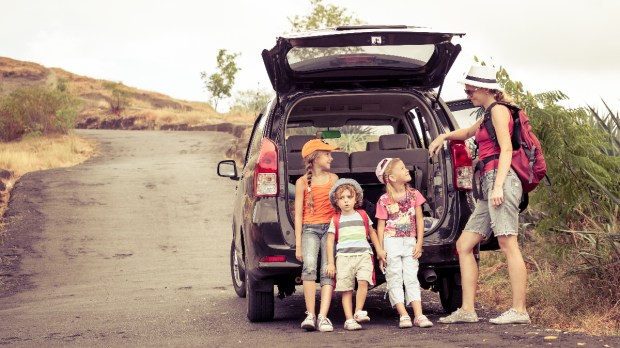
Against all odds, and in spite of justifiable questioning of our sanity, my husband and I just successfully completed a road trip from Chicago to Miami… and back.
That’s 22 hours each way, for the folks keeping score at home, although each drive was actually several hours longer, owing to bathroom stops about every 37 minutes.
Because, oh yeah, did I mention? We brought along our four kids, the youngest of whom is 3 and the oldest of whom is 9.
I know. Who does that? But the wildest part is that we actually had a lot of fun! It went so well that we plan to do it again next year.
Surprisingly, there are a number of reasons to prefer driving to flying when traveling with kids. For one thing, driving is more relaxed: There are no hard deadlines, so the inevitable kid dawdling is much less stressful. For another, there’s no worry that your child will be loud and annoy others on the flight. They can be as loud as they want in the car! It’s also really nice to be able to bring whatever you want instead of cramming everything for 6 people into a few carry-on bags and those annoying 3-oz liquid containers. And yes, it’s a lot less expensive!
If you’re planning a long road trip with kids, perhaps for spring break or over the summer, here are 5 things that made all the difference for us.
1 Screen time rules go out the window
We are a very minimal screen time family most of the time, and my kids often go weeks without watching any screens at all. But I make a huge exception for travel.
Traveling with kids is pure survival and I have no qualms about giving them many hours of screen time on a plane or road trip. The kids got about 4-5 hours of screen time per day on our long drive, but the timing was strategic.
We did sticker books, activity books, drawing, audiobooks, music, play dough, and other activities first, and then saved the movies for the last leg of the drive. (Hands down audiobooks were the most popular activity other than screen time, and we listened to about half the Narnia series on the drive.)
Typically, the last few hours of driving are the hardest part, when everyone is just absolutely done with being in the car. By saving the screens for that time, those hours became something fun that my kids looked forward to and enjoyed. The end of the drive flew by as my husband and I got some quiet alone time for conversation. Saving screen time for the last few hours was really key to enjoying the trip so much!
2 Pack your own food
I packed a lot of food in coolers and I highly recommend doing that, as every time we stopped to buy a meal, it ended up taking at least 45 minutes. Thanks to complimentary hotel breakfasts and packing a mix of snacks (nuts, granola bars, apples, homemade muffins, pretzels, and other shelf-stable items), we stopped for a meal only once a day, which saved a lot of time.
3 Bring your own potty for small kids
Thanks to the aforementioned constant bathroom stops, we made good use of a foldable travel potty , which is truly a genius parenting invention. We literally just set it on the floor of the car for the kids to use whenever we stopped, and it was a lot faster and more hygienic than bringing preschoolers into random gas-station bathrooms!
4 Plan a daily surprise or two
I packed two “surprise toys” for each day of the drive, to keep the kids entertained during the long hours in the car. These included things like hidden picture books, sticker dolls, puffy stickers, magnetic dolls, scratch art, color wonder, water wow, mini squishies, and maze books.
The kids each packed a small bag of activities from home they wanted to do in the car, and I also brought clipboards, lap desks, blank sketchbooks, colored pencils and a small pencil sharpener. We also alternated listening to audiobooks, listening to music, reading aloud, travel bingo, and travel games.
5 Keep a few essentials handy
The kids were often thirsty, so pack extra water so you don’t have to stop to refill too often. We were glad we brought several water bottles and a backup large jug of water!
Keep handy a stash of plastic grocery bags, tissues, and baby wipes, just in case of emergencies. We also set up a little trash bag between the two front seats and that was very useful.
My oldest wants to tell you that you should choose carefully who sits in the middle row, as that person will be constantly passing things back and forth from the front and back rows. He was in the middle row and did an admirable job as designated “passer,” passing probably hundreds of things with great patience.
Finally, I recommend consulting with your children’s pediatrician about medication for motion sickness and sleep aids (kids get pretty riled up when they arrive at a new hotel).
Despite a few setbacks, like car sickness and endless bathroom stops, the drive overall went really well, and we would absolutely do it again. I hope these tips can be helpful for you if you’re planning a big road trip, and don’t hesitate to reach out with any questions in the comments!

Articles like these are sponsored free for every Catholic through the support of generous readers just like you.
Help us continue to bring the Gospel to people everywhere through uplifting Catholic news, stories, spirituality, and more.


IMAGES
VIDEO
COMMENTS
9. Pack your cat's litter box, filled with clean litter. Cat's have an amazing ability to hold in their urge to go to the bathroom. That being said, sometimes the urge can be overwhelming and your cat will need to use the litter box on the road, particularly if you are road tripping long distance.
1. Place your cat in its carrier. Make sure that your cat is securely in its carrier before you place it in your car. It may take some coaxing to get your cat to enter and stay in the carrier, so offer it some treats or a favorite toy, and be patient. Letting your cat loose in the car while traveling is not safe.
Some cat carriers have more room to spread out, and some even include a litter box. Necoichi portable cat cage and litter box: This carrier, really "cage," has straps for securing it in the car, and it can fit a litter box, which is sold separately. The cage, used on a long road trip by a Preventive Vet team member, is featured in the photo above.
The night before travel, put your cat in a small room with the carrier, a litter box, food, and water. This will make it easier to get your cat in the carrier the next day. Plus, it can help your cat adjust to a smaller space. If the trip is more than two or three hours long, then your cat will need a break. Bring a litter pan, food, and water ...
The 9 Tips for Long-Distance Travel With a Cat in a Car 1. Familiarize Your Cat With the Car. Image Credit: Raindom, Pixabay. Cats may associate the car with vet trips and be anxious during them ...
A successful road trip with a cat begins long before the day of travel. The best time to teach a cat to travel easily is when she is still a kitten. However, even for an adult cat, the sequence of learning to travel is essentially the same. ... Never leave your cat alone in the car. The interior temperature can rise to a dangerous level within ...
1. A Sturdy and Well-Ventilated Carrier. Choose a carrier large enough for your cat to get up, turn around, and lie comfortably. Make sure the carrier has a secure latch and soft bedding inside. Consider spraying some Feliway or other calming pheromones inside the carrier to help your cat relax.
Get your cat used to their carrier and car in advance of your long road trip. Get your cat used to a harness and leash in advance too. Pack everything you need (see our packing list) Keep water, food, and spare litter within reach in the car. Stop every 2-3 hours and use a harness and leash to walk your cat.
2. Get Them Used To Their Carrier Ahead Of Time. A cat's carrier should be their safe space. You want them to be used to the carrier before ever bringing them into the car in it. To do this, leave the carrier out in the house for your cat to constantly use. At the start, I left treats inside for my cat to find.
Before the Trip. The best way to prepare for a long car ride with your cat is to help them get used to the car at least a few weeks before you plant to leave. Train them by letting them sit in the car for a little bit to get used to the smells & sounds, then begin taking small rides around the neighborhood, to your vet, or run errands together ...
The temperature inside your car should ideally be kept between 70-75°F (21-24°C), a comfortable range for most cats. Overheating can be harmful to cats or any other pet, so use the air conditioner if needed, and avoid parking in direct sunlight. Temperatures get high really fast if you leave your car in the sun.
Thundershirt. $40-45. 3. Ask Your Veterinarian for Anxiety Meds. Some cats are incredibly fearful of going to the veterinarian's office. It might make your life easier if you get them anxiety drugs to help them cope with the drive to the office and all the unpleasant things they'll go through once you've arrived.
If you notice your cat is restless, panting, and frequently vocalising, this could indicate that your kitty is just not a fan of travelling by car. This is where you can make arrangements with your veterinarian for feline stress relievers. 4. Ensure Safety Precautions. Image by Cintya Marisa on Unsplash.
The 15 Expert Tips For Road Trips With Cats. 1. Check into Travel Restrictions at Your Destination. Do yourself a favor and find out if there are any travel restrictions where you're headed. Most municipalities don't regulate pets beyond licensing and similar requirements.
Below is a checklist of items we suggest taking with you when traveling with one cat (increase quantities as needed for multiple cats). Food and snacks/treats. Fresh water, preferably bottled or brought from home. Bowls (2) Clean cat litter. Clean litter pan. Brush or grooming tools. Any medications. Pet first-aid kit.
The Petmate Two Door Top Load carrier is the overall best cat carrier for long road trips in the hard category due to its easy to use nature, affordability, and security. True to the top load in its name, you pop the top door and simply drop in your kitty if the front gate a no-go.
Prepare for Your Road Trip with A Dress Rehearsal. Of course, the best way to see how your cat will react on a long distance car ride is to actually put them in the car and go somewhere. It's one thing to drive them quickly to the vet and back. But, you want to see how they'll react on a long distance road trip.
11 Tips for Car Travel with Cats. 1. Secure Your Cat in a Carrier. A secure carrier can be the difference between life and death for a cat in a car accident. It can also save human lives! At just 30 miles per hour, a 10-pound cat flying across the car turns into a 300-pound force. This can severely injure the humans in the vehicle!
Feeding. Comfort. Calming Treats. Entertainment. Walking. A ride in the car is an exciting and fun adventure for many pets. Cats typically aren't too fond of spending any time in a vehicle, so cat owners often resign themselves to a life without road tripping with their kitties. While it is admittedly harder to train a cat to be okay with car ...
Before you embark on a long road trip with your pet, take them for a test drive and see how they manage in the car. Drive for anywhere from two to four hours with your pet and observe how they do ...
6 expert tips for taking a dog on a long car journey. Tip 1: Create a packing list. Tip 2: Research your route. Tip 3: Practice car trips beforehand. Tip 4: Blow off steam before you travel. Tip 5: Try positive reinforcement. Tip 6: Create a calming space in the car. Robin Skillings, Chief Marketing Officer at Ruffwear, told Country Living ...
The eclipse's path fortuitously cuts across Mexico, 15 U.S. states and a small part of eastern Canada. In all other states in the continental U.S., viewers will be treated to a partial solar ...
NASA says that roughly 31.6 million people live in the path of this year's total solar eclipse, and a little under half of the U.S. population lives within 200 miles driving distance of the path ...
4Plan a daily surprise or two. I packed two "surprise toys" for each day of the drive, to keep the kids entertained during the long hours in the car. These included things like hidden picture ...
There are 3 ways to get from Elektrostal to Moscow Domodedovo Airport (DME) by train, taxi or car. Select an option below to see step-by-step directions and to compare ticket prices and travel times in Rome2Rio's travel planner. Recommended option. Train • 1h 42m.
Central Air Force Museum The Central Air Force Museum, housed at Monino Airfield, 40 km east of Moscow, Russia, is one of the world's largest aviation museums, and the largest for Russian aircraft. 173 aircraft and 127 aircraft engines are on display, and the museum also features collections of weapons, instruments, uniforms (including captured U2 pilot Gary Powers' uniform), other Cold War ...
Moscow, Russia. Moscow is the capital and largest city of the Russian Federation. The city stands on the Moskva River in Central Russia, with a population estimated at 13.0 million residents within the city limits, over 18.8 million residents in the urban area, and over 21.5 million residents in the metropolitan area.
Central PPK operates a train from Ploschad Tryokh Vokzalov to Fryazevo 4 times a day. Tickets cost RUB 120 - RUB 170 and the journey takes 44 min. Train operators. Central PPK. Other operators. BlaBlaCar. Taxi from Moscow Central Bus Station to Elektrostal.